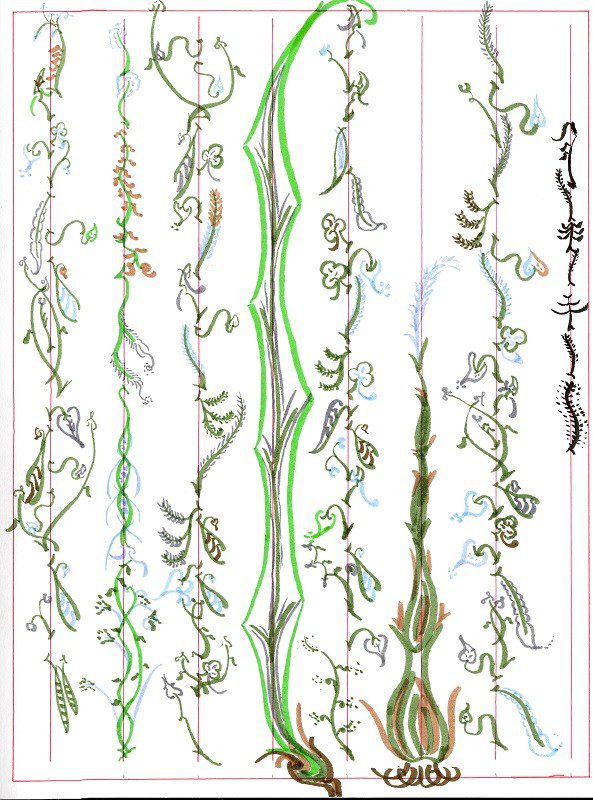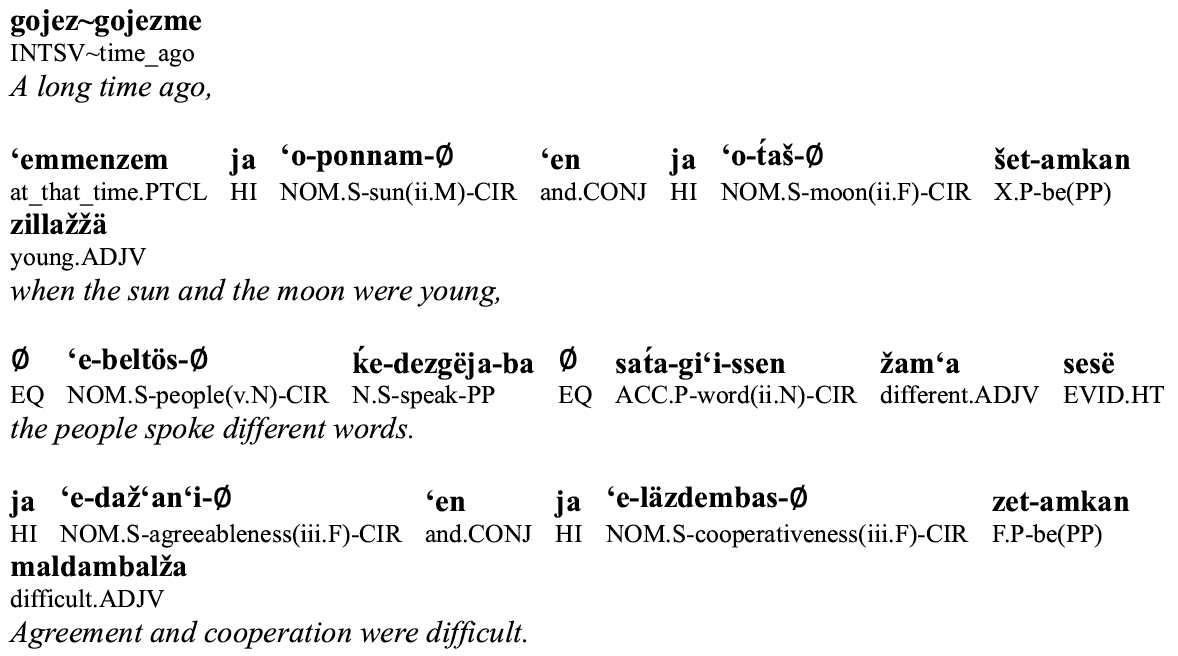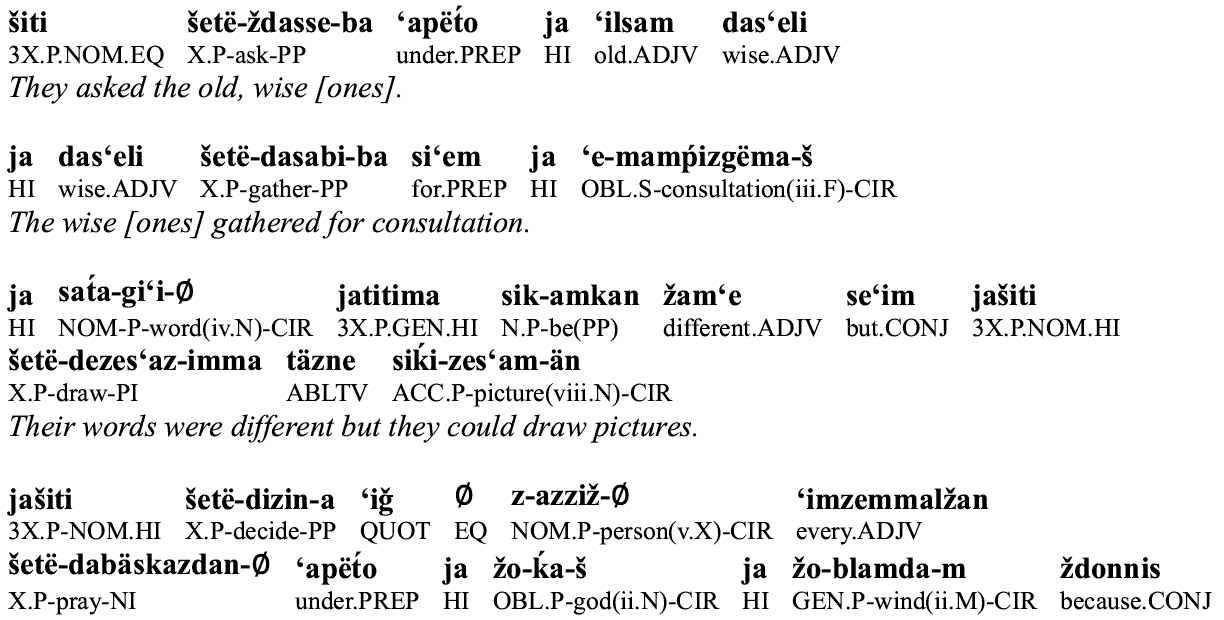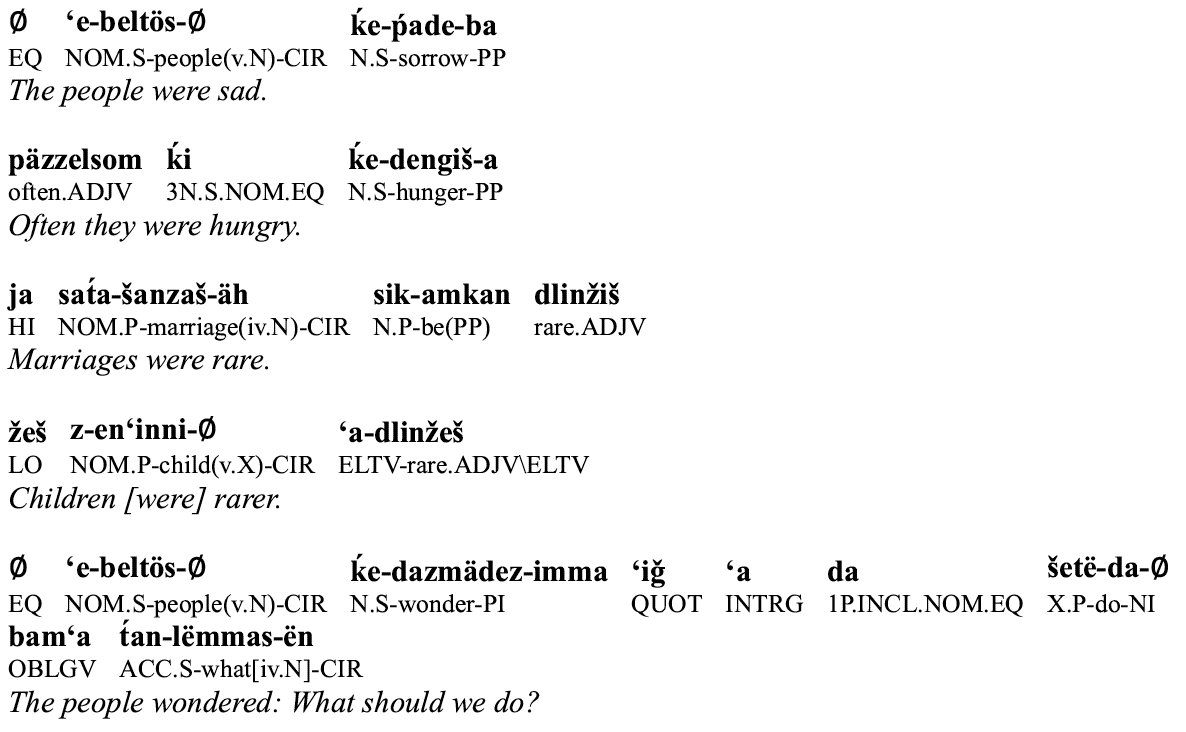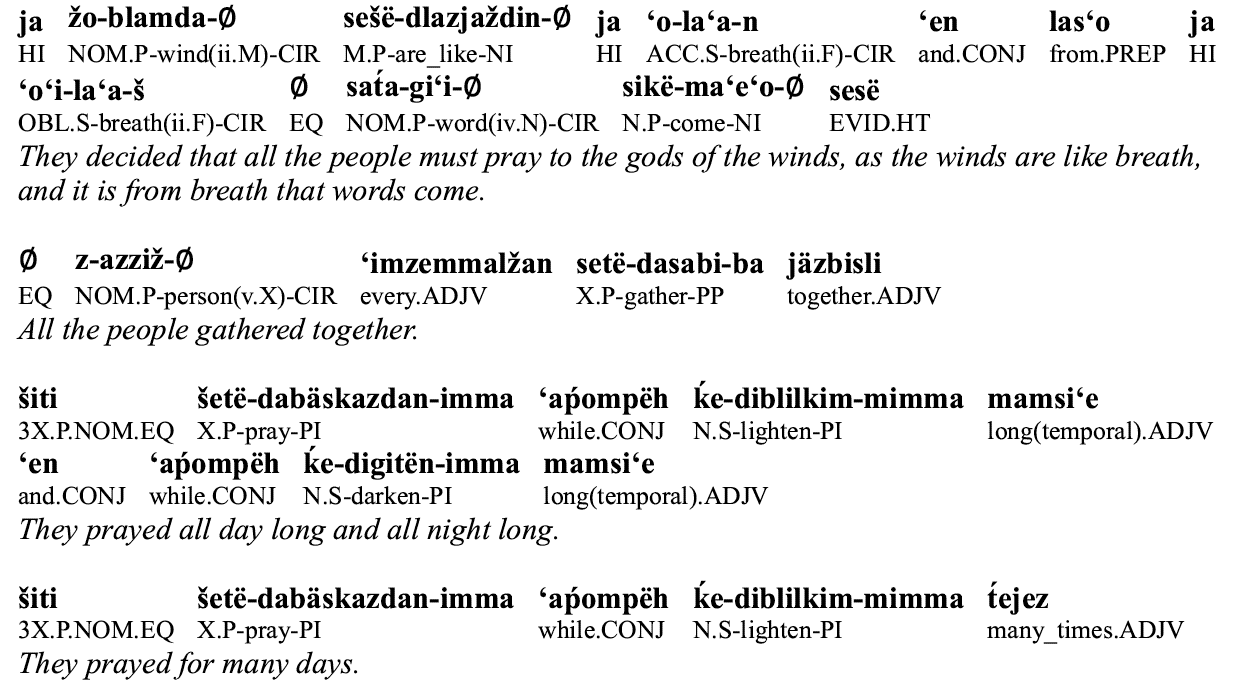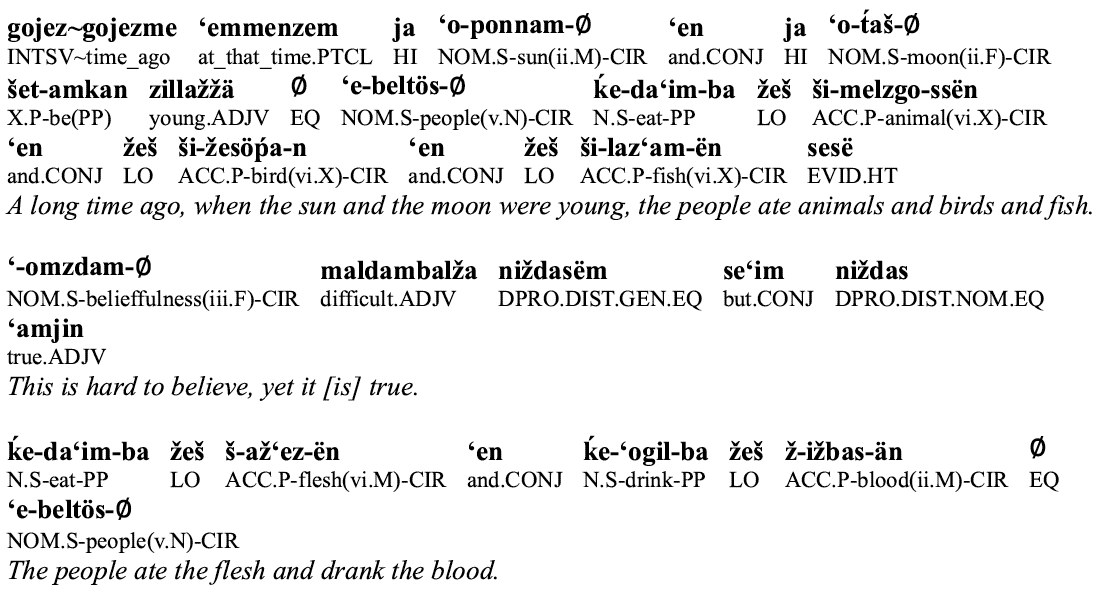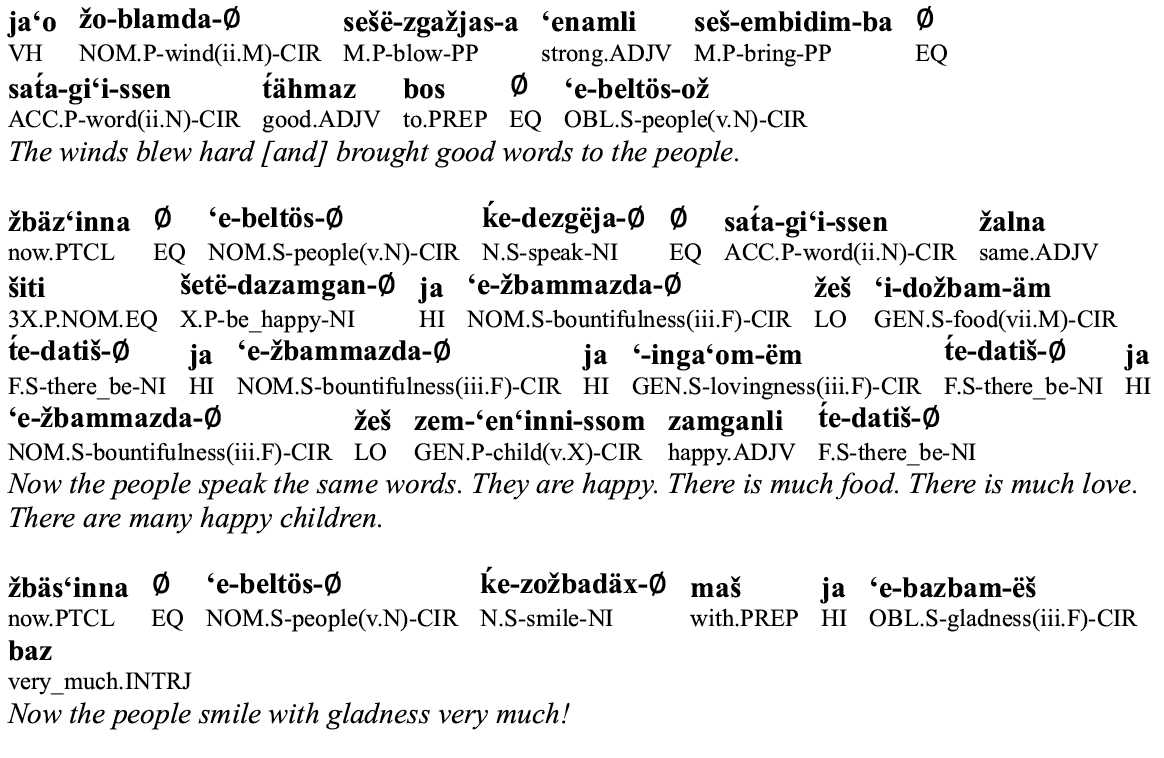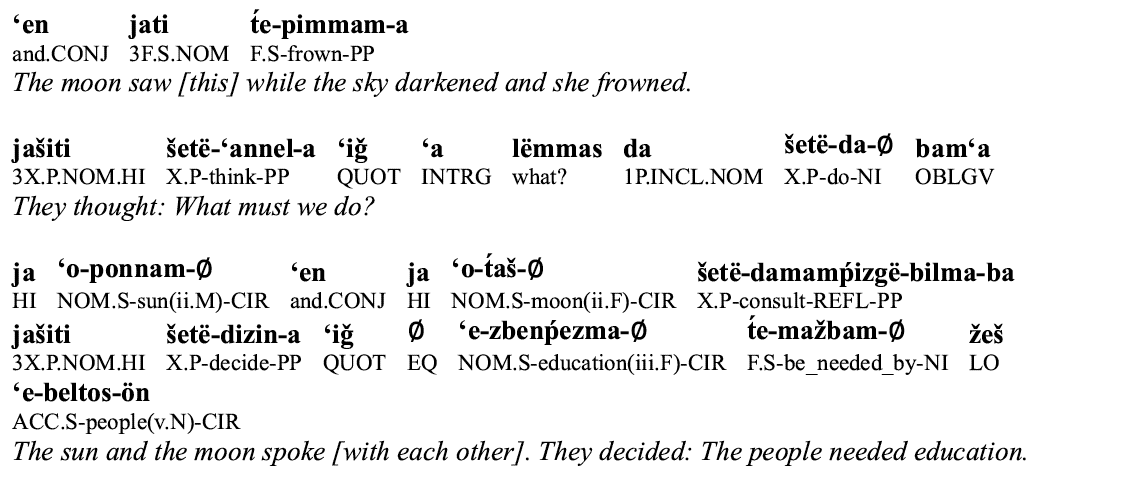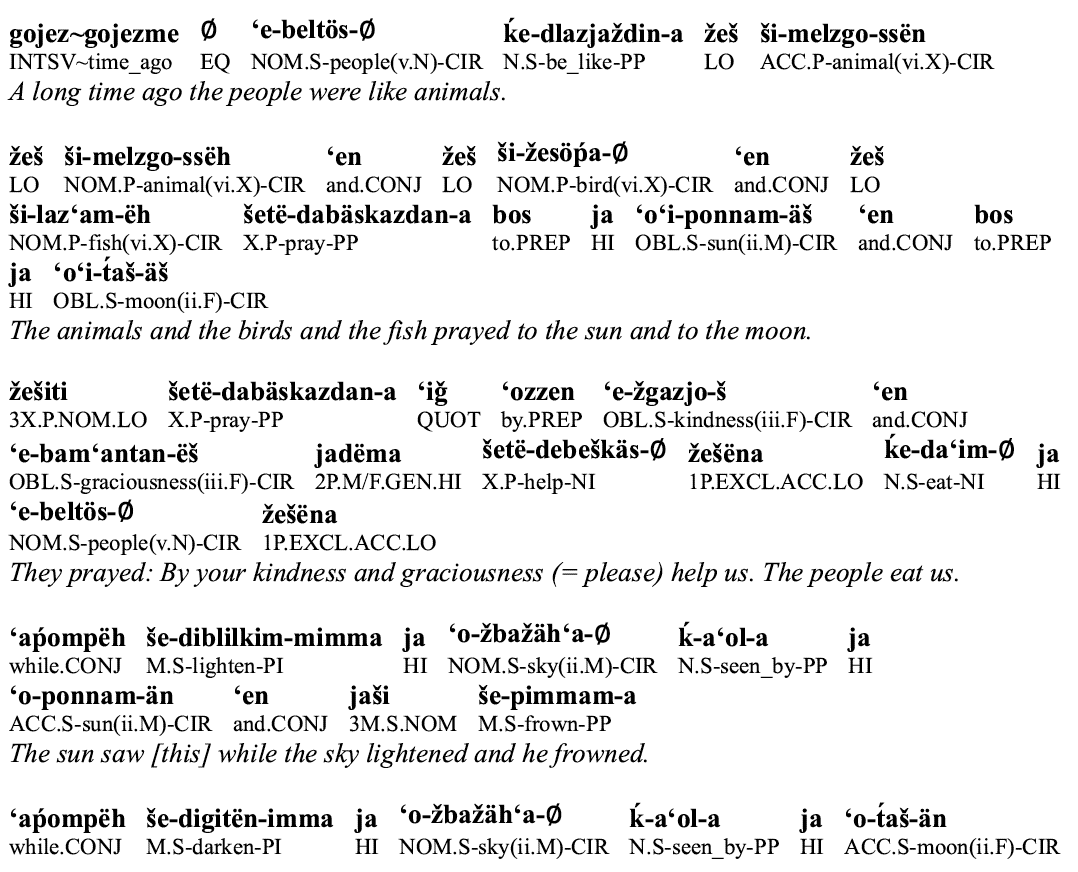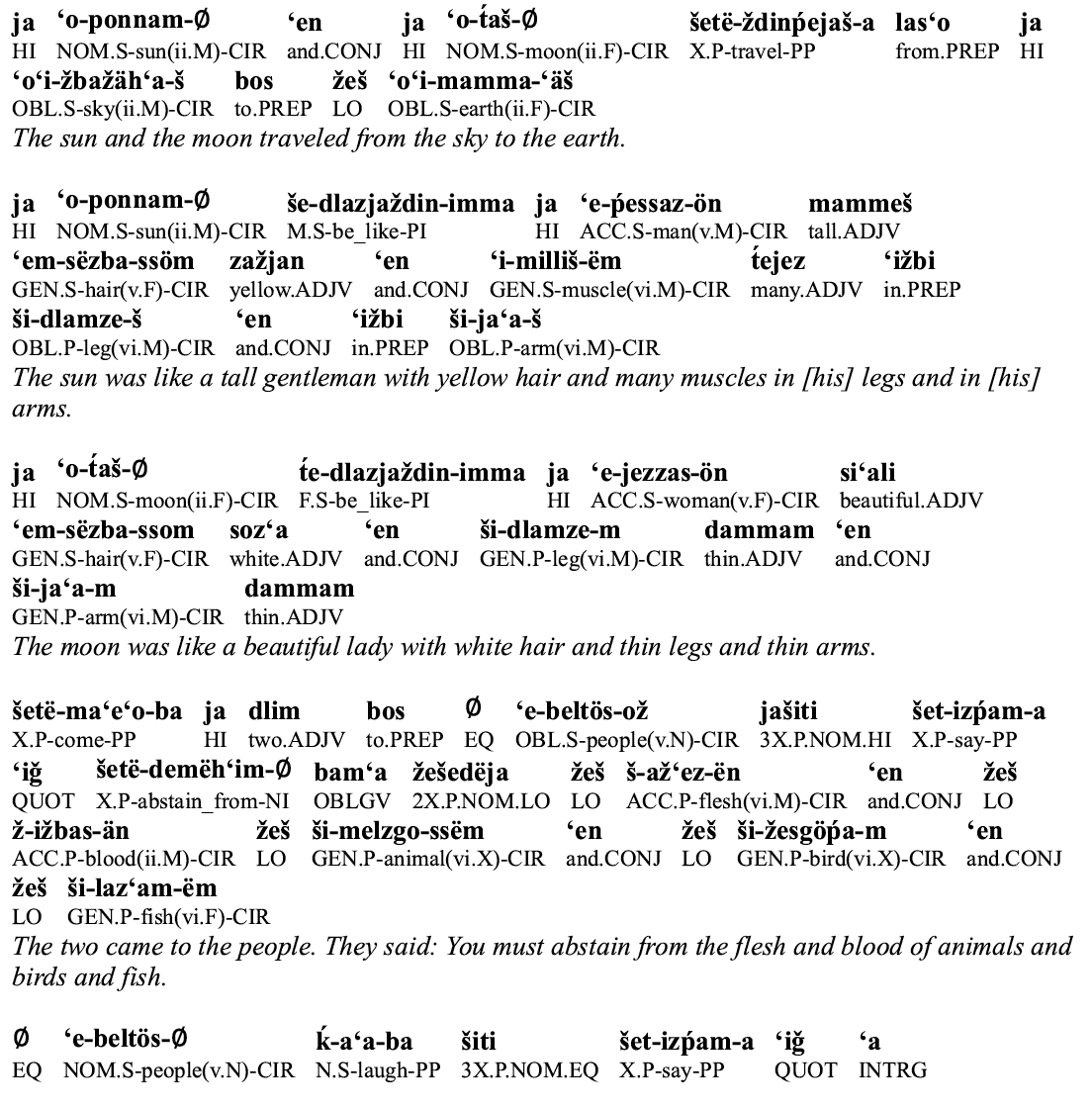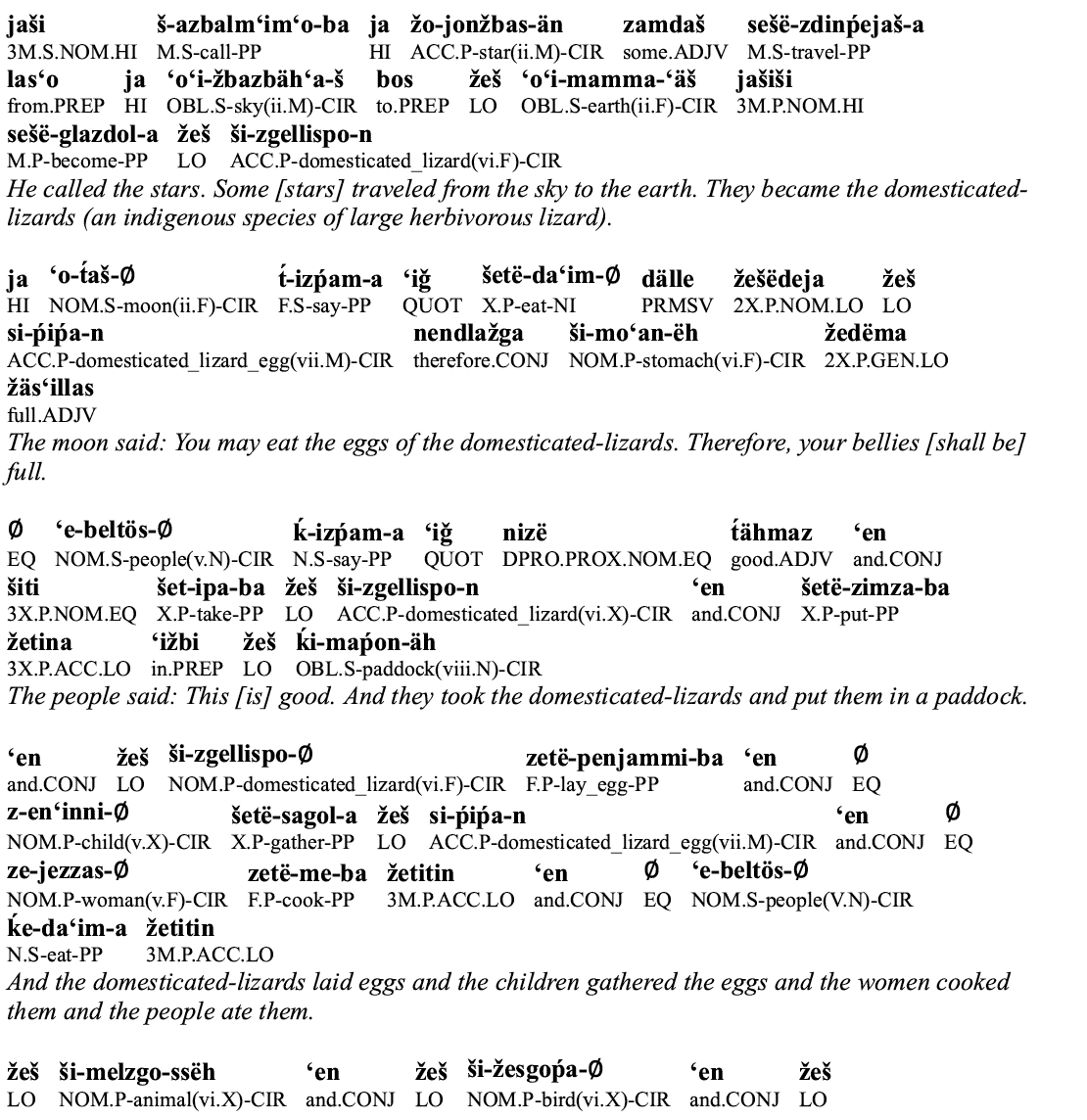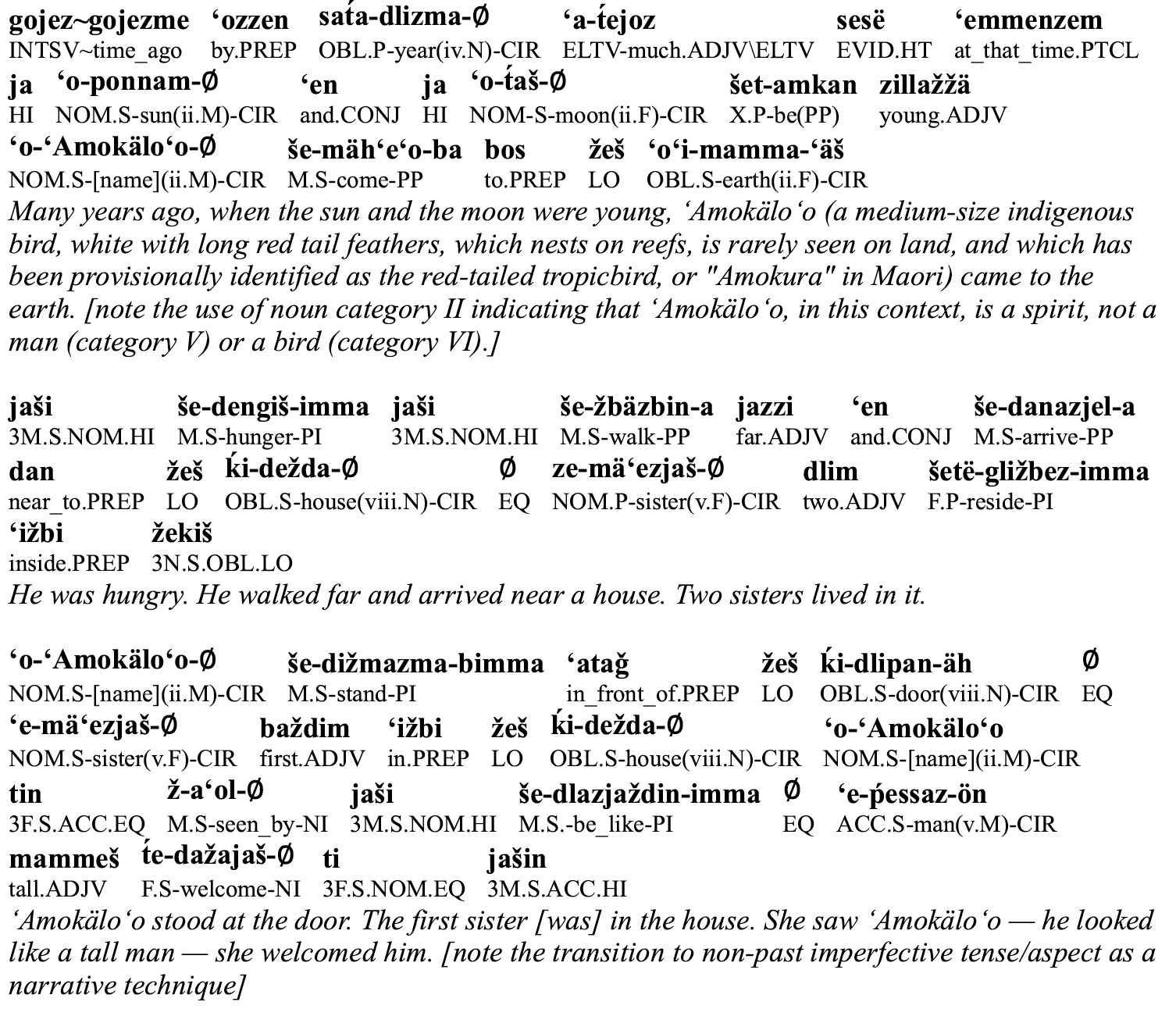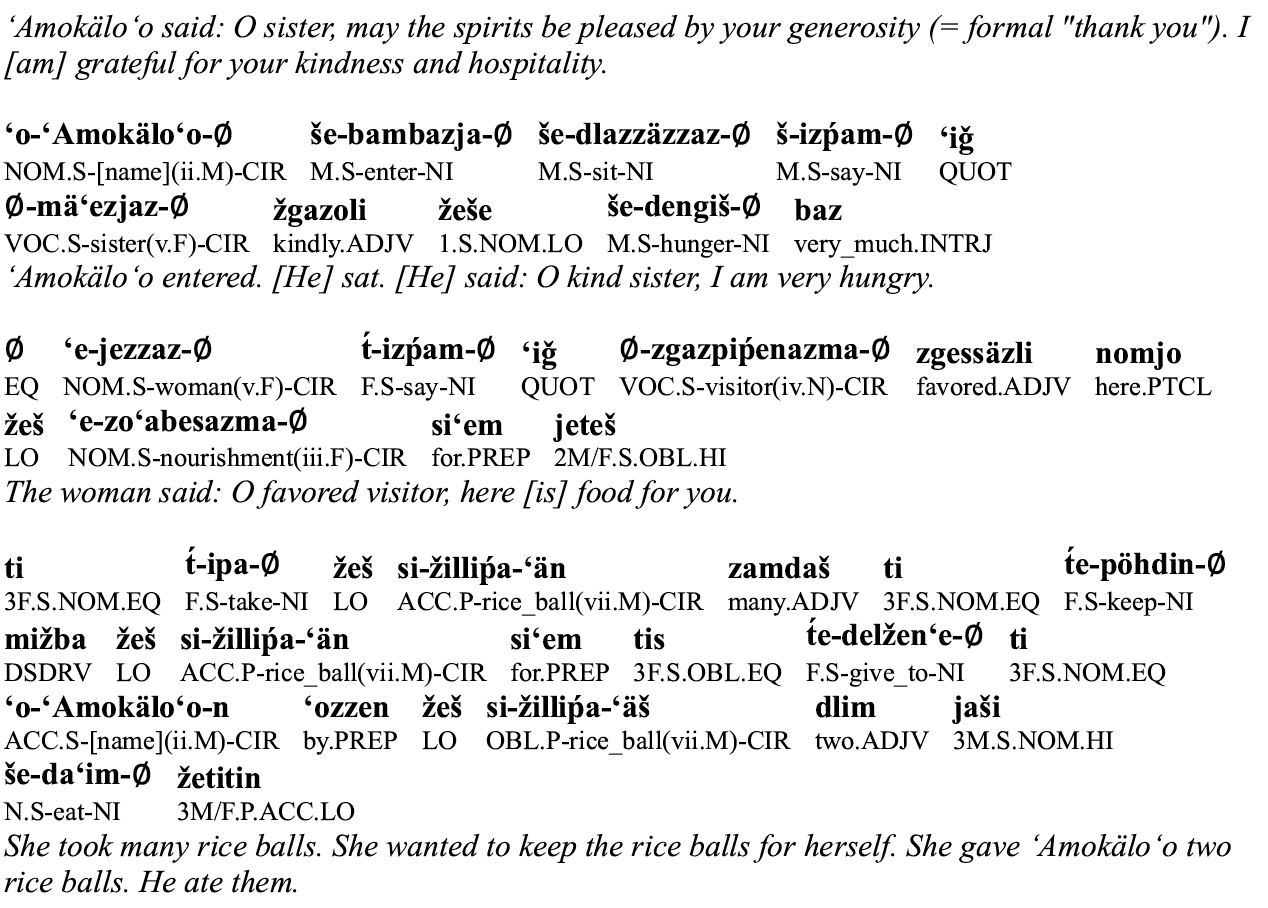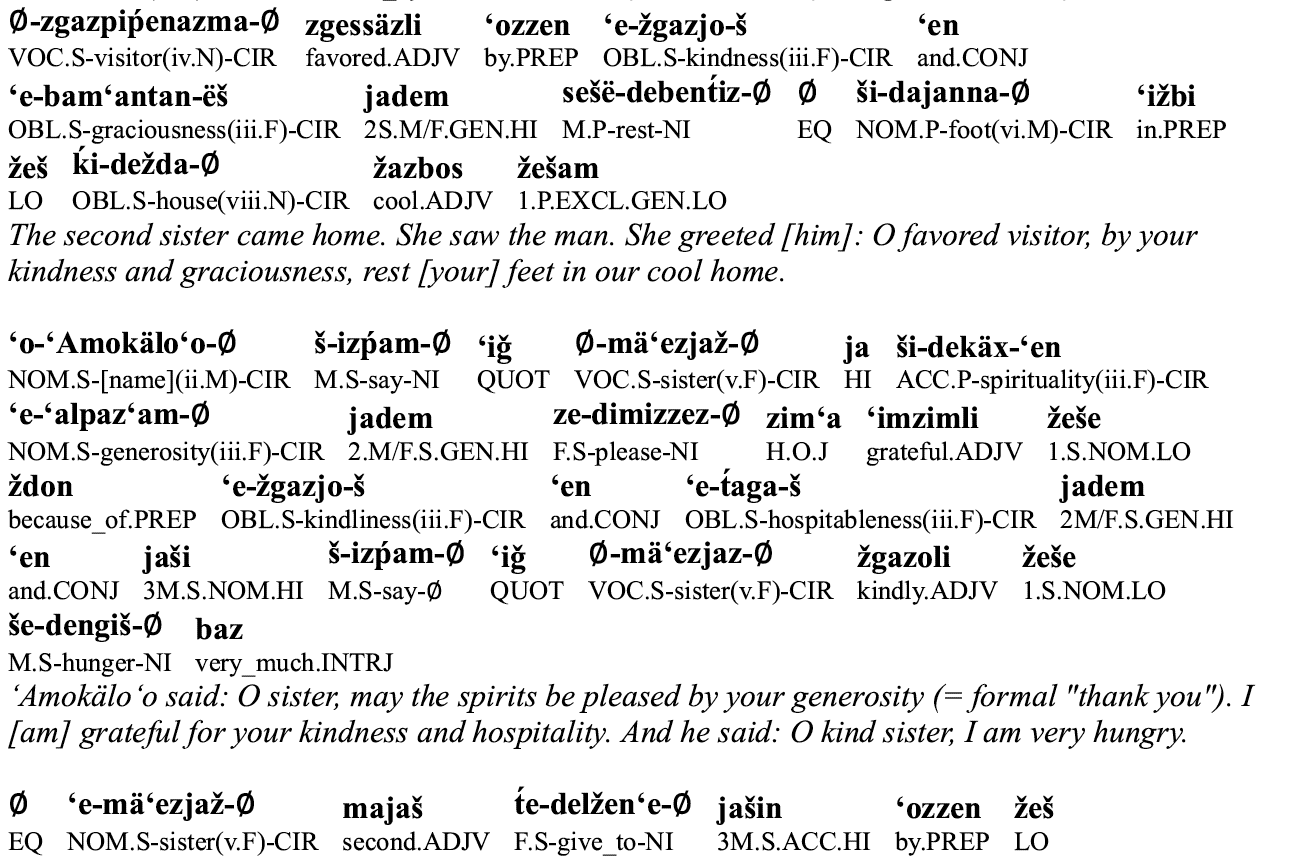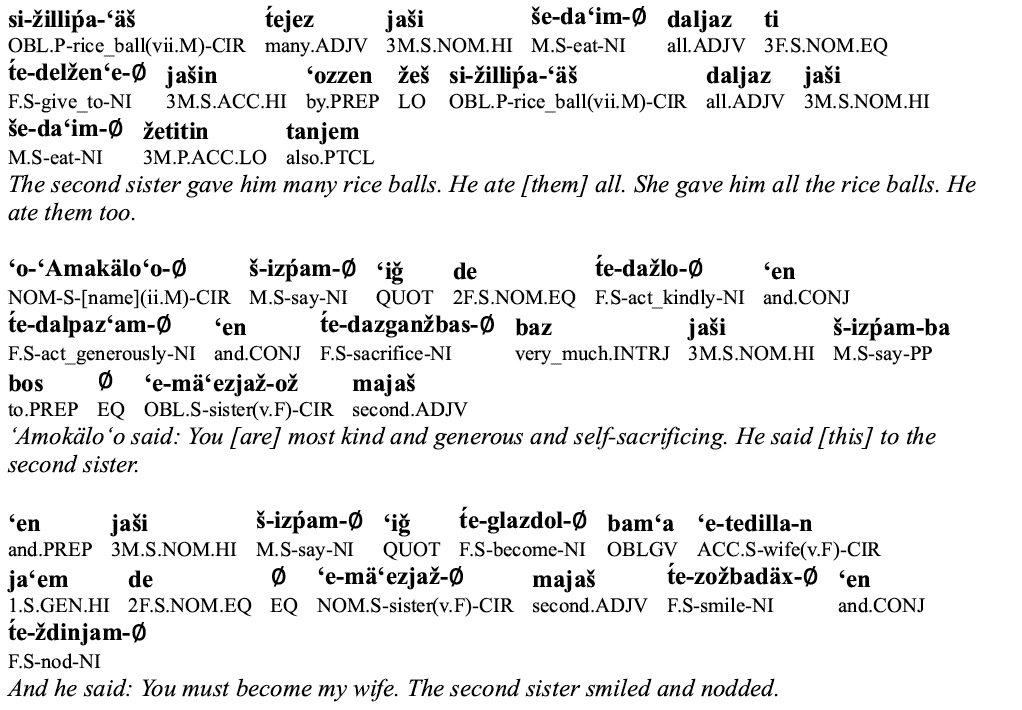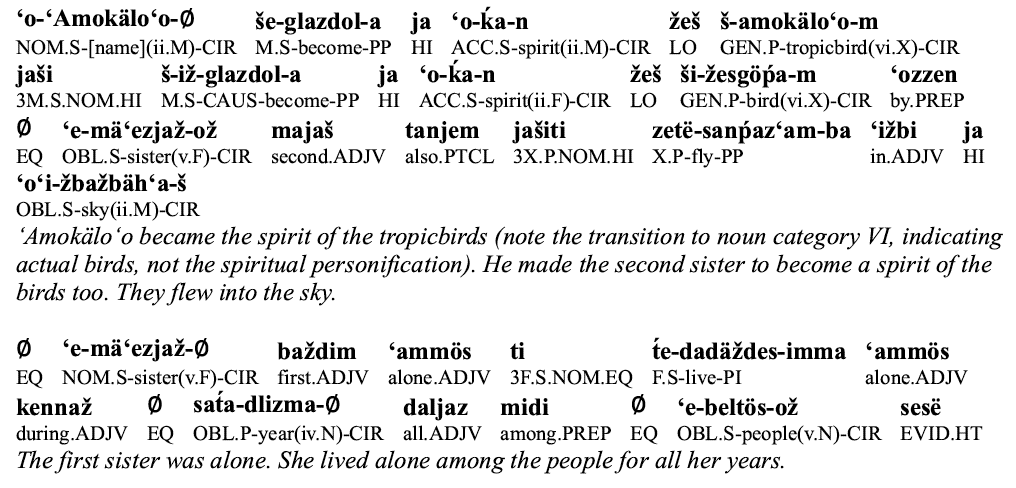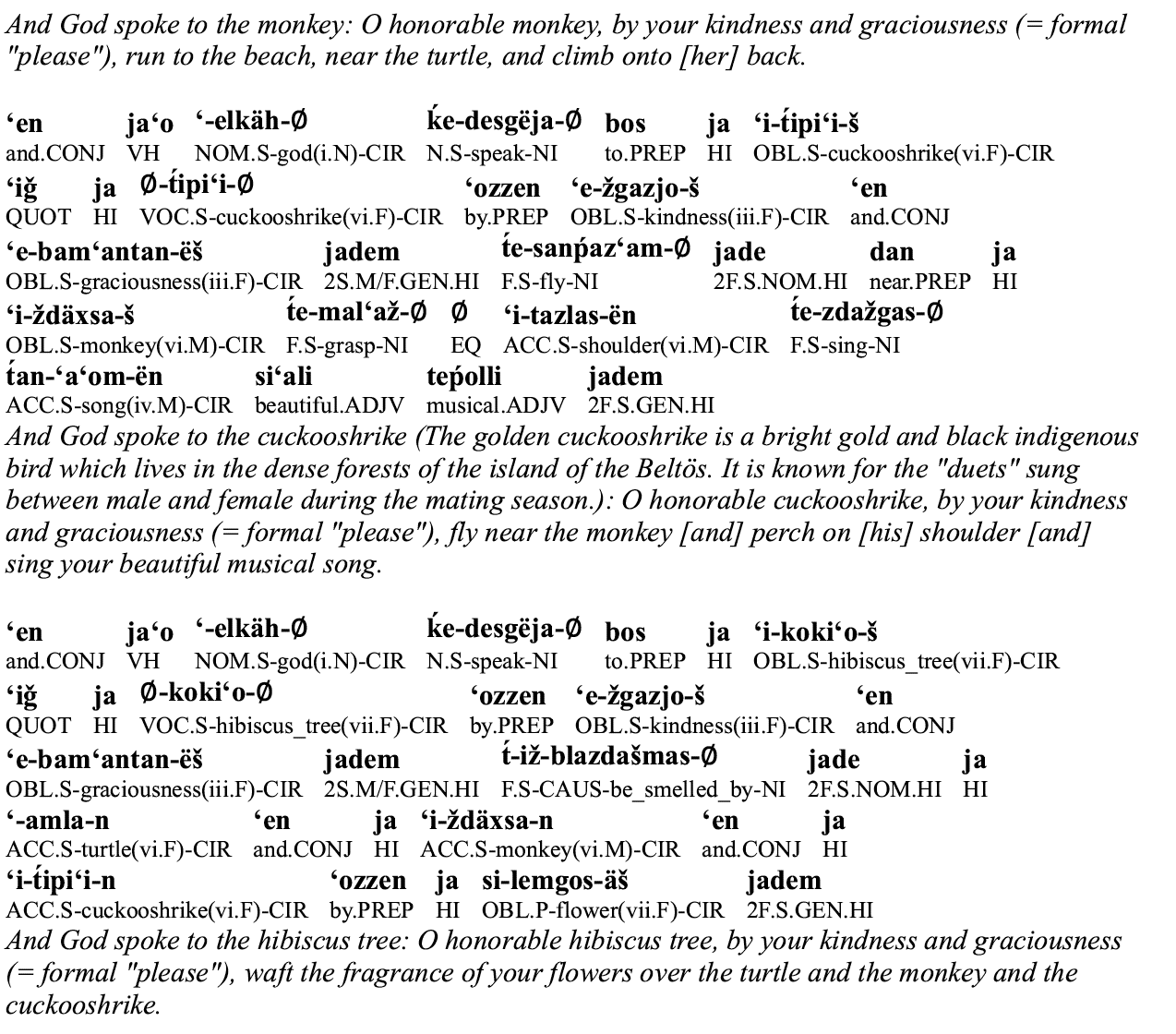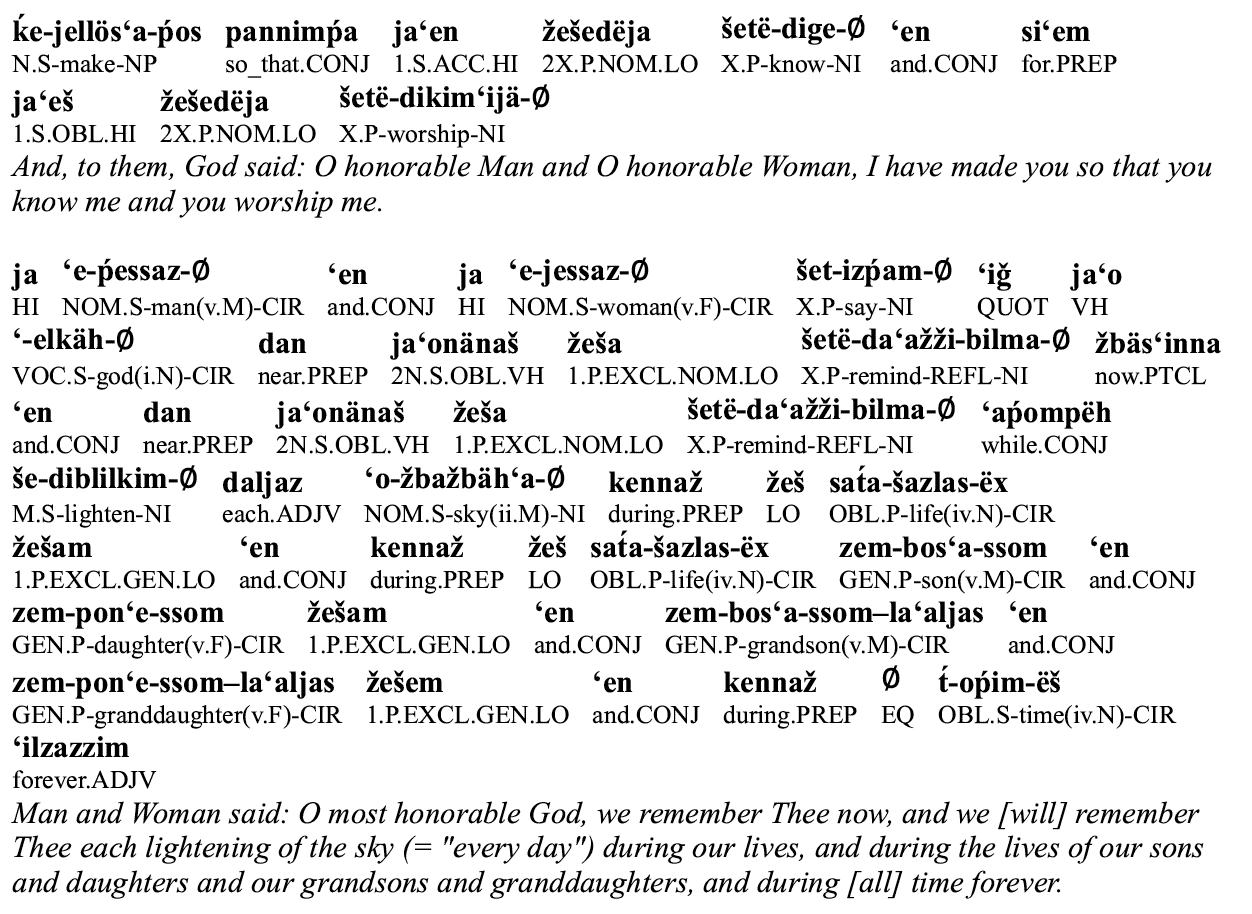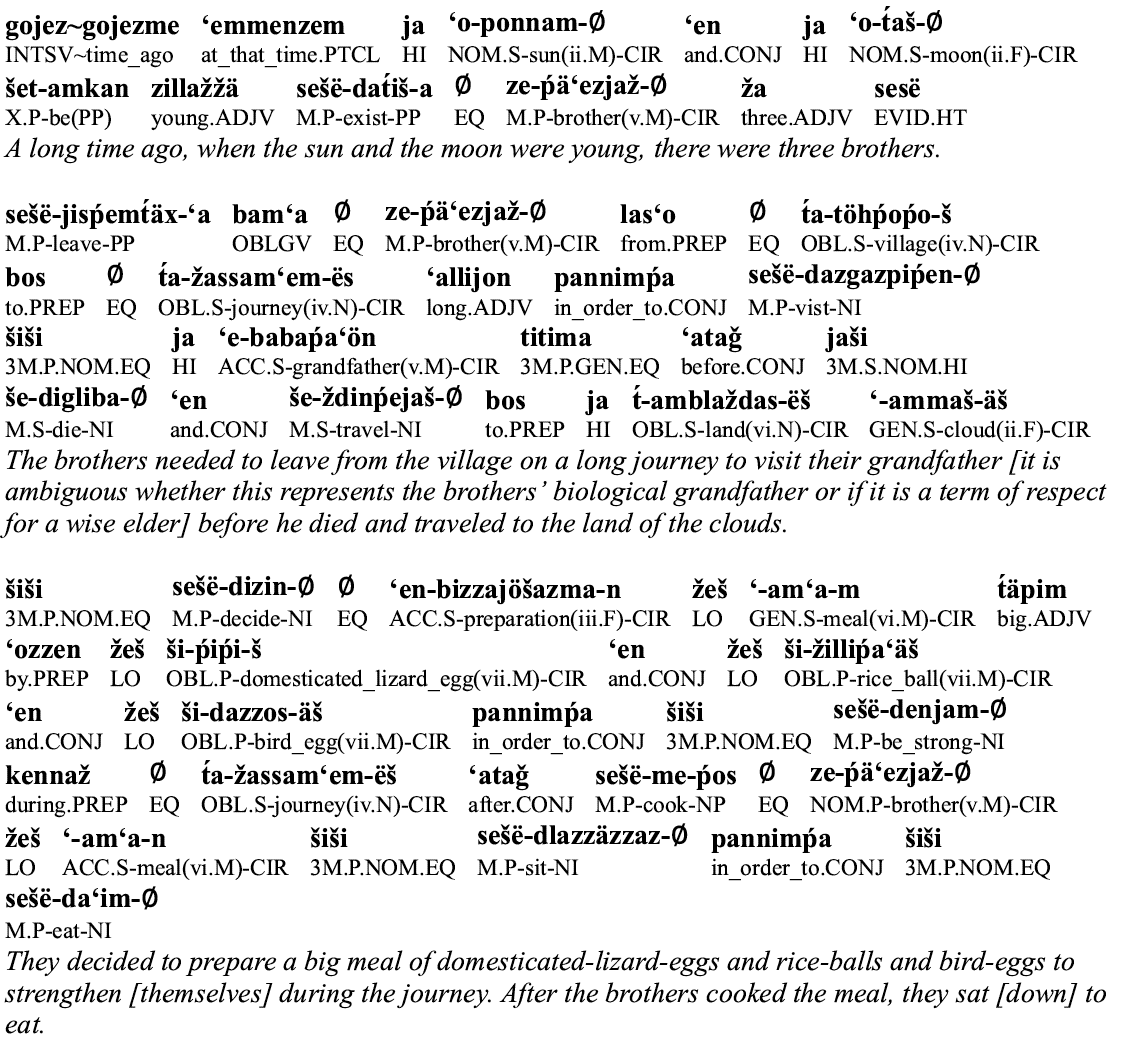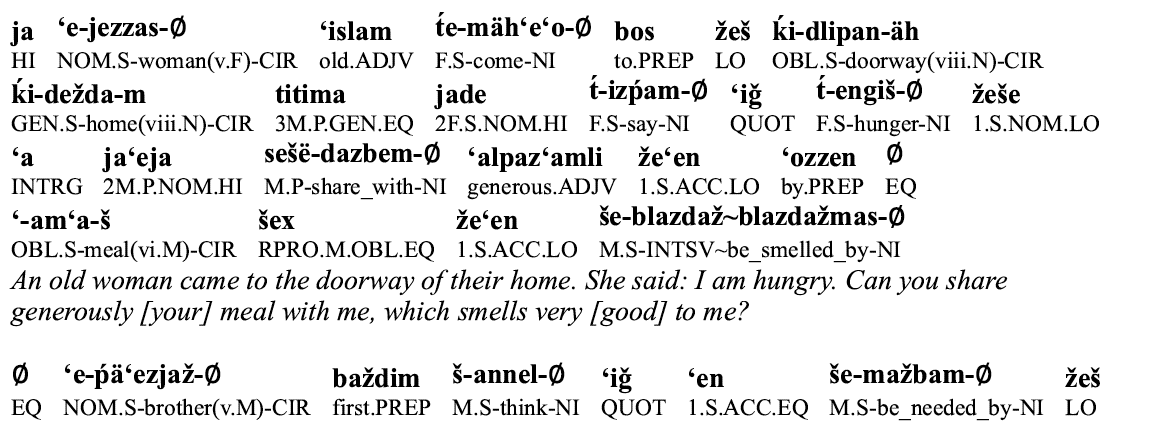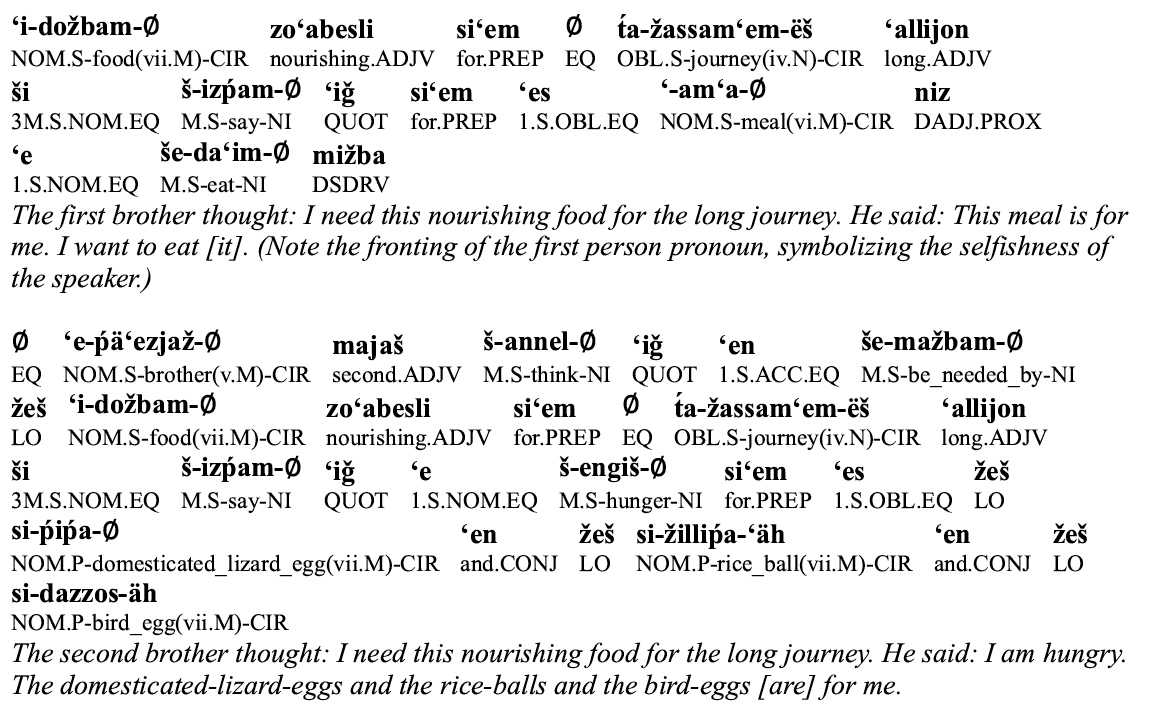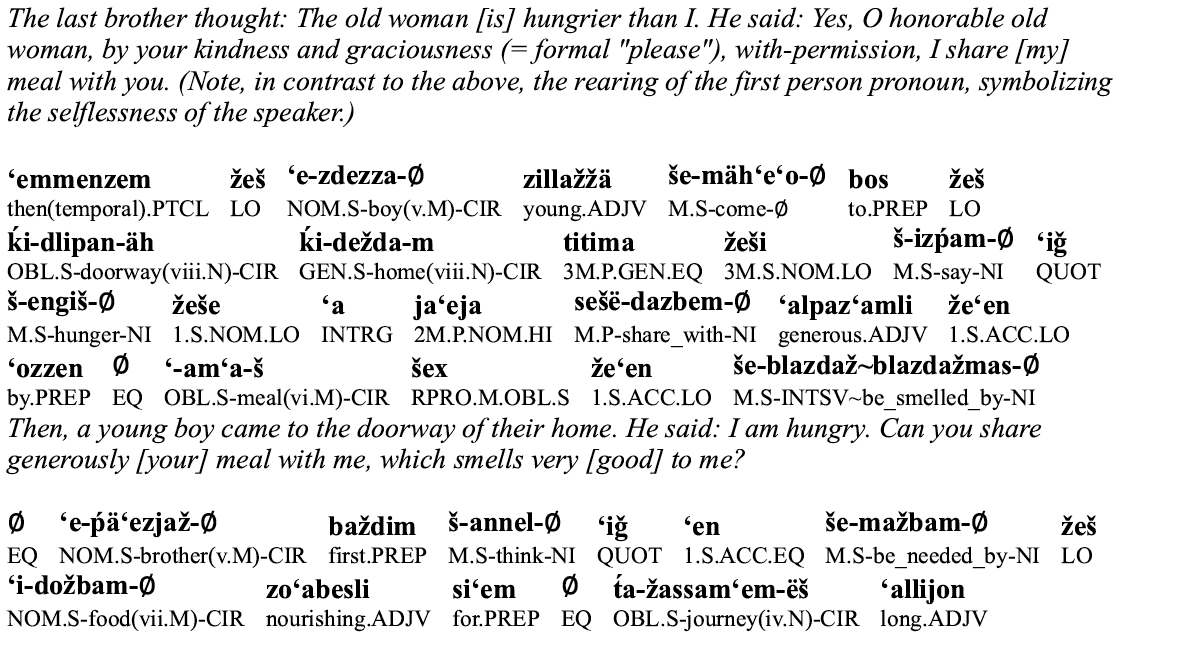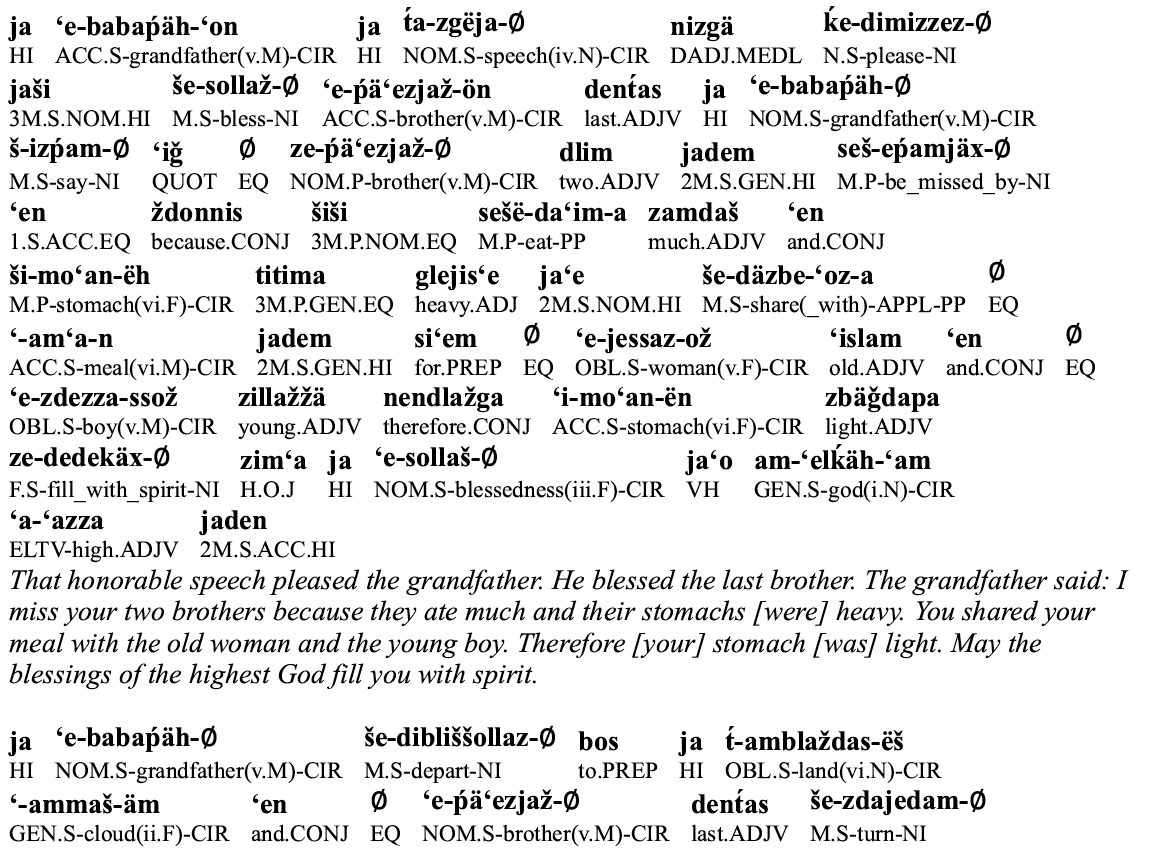Vatum: A Growing Collection of Conlang Literature,
no. 1
Editor: Jack Bradley
MS Date: 06-29-2020
FL Date: 10-01-2020
FL Number: FL-00006D-00
Citation: Bradley, Jack, editor. 2020. «Vatum: A Growing
Collection of Conlang Literature, no. 1.”
FL-00006D-00, Fiat Lingua,
Copyright: © 2020 Jack Bradley, Chris Brown, Jeffrey
Brown, Anthony Harris, James Hopkins, Franc
Kravos. This work is licensed under a Creative
Commons Attribution-NonCommercial-NoDerivs 3.0
Unported License.
http://creativecommons.org/licenses/by-nc-nd/3.0/
Fiat Lingua is produced and maintained by the Language Creation Society (LCS). For more information
about the LCS, visit http://www.conlang.org/
ISBN 978-1-71679-571-8
Vatum
A Growing Collection of Conlang Literature
Summer, 2020
no. 1
Produced by lam ‘aj Se’vIr malja’
Edited by Jack Bradley
2
Contents
From the Editor
Jack Bradley
Swesware
Chris Brown
From the Valley of Life
to the Island of the Green
Scarab
James Hopkins
Our Solar System
Anthony Harris
Beltös Mythology
Jeffrey Brown
Niyolue’s Choice
Franc Kravos
Black Wolf, Red Robin
Hood and the Three Pigs
Chris Brown
3
4
6
8
18
52
72
83
4
From the Editor
Conlangers have made
some
incredibly
in-depth
languages with rich literature all their own. Within these pages is
a space where conlangers who regularly compose in their own
conlang(s) can present their writings as well as get inspired by the
work of others. It’s a place to share, to applaud, and to learn.
When I announced that I was looking for contributions for this
first edition of Vatum, there was no shortage of material.
Conlangers of all sorts volunteered their work and I thank every
one of this quarter’s five contributors with all of my heart for
entrusting me with their creations. Together, you have made
something incredibly special. You all blow me away with your
boundless talent (and patience!) My hope is that I’ll keep
receiving enough contributions to compile these showcases of
amazing literary work being done by conlangers everywhere
quarter after quarter into the foreseeable future. nItebHa’ maqonjaj!
-Jack Bradley
5
Swesware
Chris Brown (Dêne)
Denê folk of the world called Yeola love to compose
little bits of nature themed poetry. Here, Swesware is a winter
poem. They also delight in complicated pictorial scripts, of
which the Flower Script is an example.
waylly na-moccanye surya pwe-herí sweswarocceng
sweswarenem Yeoles and en-derí harachanweste
le talghonye nimam and na-derí calamuravehers
esat endi sayano melle pwe-remanimonye wesenyas!
soft the cloak she snowed
in snow is Yeola shrouded
in fur-blanket is the girl sleeping
until her her Mother awakens!
6
7
From the Valley of Life to the Island of the Green Scarab
Gimlaay Zarideyna ta Karfeyese ta Shirit Shishaa
James Hopkins (Itlani)
The Itlani are great storytellers. The prazhendi, the
popular storytellers, will either generate new stories for pure
entertainment or re-tell old and well-known stories to inspire and
educate. Bellow is one such re-telling. It is a shorter and lighter
version of a part of the Prazhenú ta Vana, “Stories of the Origin”
well known and loved by all Itlani. This version was popularized
by An-Aylea. Many have grown up hearing her rendition.
[1] Iidova djatavit onyaru. Apuún kadimyava. Siarél
veykalyavel mogova arzenya raaréy. Vulbrugú kadimyaven.
Tendayunú ta visova Siarela klanaakriyaven. Dozhunú
panaifyaven, chadizhe byudemarizhe. Siarél mogese areylya
ra-vemyavel. Idatá, Rozh-Shpiláv
ta ebonova kimsiit
eylbrediese manukanavya veykalyavor.
8
[1] This I have heard. A disaster came. She-who-is-Blue decided not
to tolerate us anymore. Groundshakes came. Great waves wiped
across the surface of She-who-is- Blue. Great waters arose,
destroying much. She-who-is-Blue no longer wanted to be our nest.
Then, Rozh-Shpiláv decided to guide the people to a new home-
world.
[2] Franartantoilu, ta drunit bredí Drun seti ta versukan ta
dzevanzaa zumirit vey istonirit onyava. Ta fazhenit eyl ta
Itlantanarun onifyava. Itlán shtamishtaratyiva: Ushór Itlán.
Izaese ta Ravzhurit ebón, losh tamagit marfanit ebín, ta
Semeritanú vey ta Djiratanú, klanadepikyava. Ta tanto ta
Klanamisha kadimyava vey Rozh-Shpiláv
ta ebonovó
klanamanukanavyavor. Dini ta gimlaese ta zarideyna vutova
manukanavyavor, kiinizhe ruvivizhe dini ta Prazhenavá ta Vana
– iidova ishyari mog shey ta suuday. Shey iidova ta yastay mogit
ushelarun tilyari. Ruzay sheri ta perneyín ta ebontanarun
rachadizhe ruvyira.
[2] For a long time, the magenta planet Drun at the end of the travel-
9
portal had been watched and studied. It became the new nest of the
Itlani. It was renamed Itlán: Father Itlán. The Crane people along
with other friendly tribes, the Spruce Clan and the People of the
Whirlpools, moved there. The time of the Crossing came and Rozh-
Shpiláv guided the people across. He lead them to the valley of life,
as is told in the Stories of the Origin
– this we all know from our infancy. We learn this all from the
milk of our mothers. But little is said of the sufferings of the
people.
[3] TA GIMLA ZARIDEYNA shirit vey olutit onyava.
Varovfeynit onyava. Izá ta ebonú franarizhe anarakyaven,
loshdepikyaven, loshvadikyaven, loshetarashyaven. Ruzay,
ranti ta bakhna ta ebontanarun djamokrazhniya mabugyava
tadú khapanaifyaven izizá vey sheyzá vey layso ta chayantoit
ayzanenú ta Drunit Trela Rozh-Shpilava vutova degrimya
makayaven. Idatá ta Sanukír ta Drogosa mabugifyava.
[3] The Valley of Life was green and nourishing. It was mild and
gentle. For a long time the people were content there, they dwelt
together, they worked together, they grew together. But, when the
number of the people started to become too many disputes sprang
up here, there and everywhere and even the sweet smelling, sweet
tasting teachings of Rozh-Shpiláv’s Magenta Movement could not
10
extinguish them. It was then that the Age of Migration began.
[4] Ta min ebonú ta Gimlaay Zarideyna inubranya ra-
vemyaven ruzay ta tunkiú ta rozhreza djurova venyaven vey ta
heslaúd Rozh-Shpilava djurova amgalyava. Vey iíd ishyiva:
kulit akalalit bredí tashi ta min ebonavá ksevyava. Ta birafú ta
Drogosa gidanit vey franarit onyaren vey ras ta tantoova ras ta
shapova vutova iíz fidiriprazhenya lafiyari ruzay iküí chadit
anaravá ta perneyú ta ebontanarun akishtyaven.
[4] The three peoples did not want to leave The Valley of Life but
the needs of peace and tranquility required it and the wisdom of
Rozh-Shpiláv counselled it. And this is known: a whole explorable
planet lie before the three peoples. The adventures of the Migration
are great and long and we have neither the time nor the space to
tell out their stories but through many regions the sufferings of the
people were severe.
11
[5] TA GIMLA ZARIDEYNA anár
shasderevushit
mantabira onyara vey ta maka ta nasheyovó ekhdatya
shprunizhe safafivit onyava. Djufi-bolo, ta gimla stranit ta
rugesa, ta kutroa, ta tuhibroa, ta rafoa vey ta aktoa helistizhe
onyava vey ta kadjegú, ta madjuzú vey ta taraniú ta latsdiarun
palanaizhe ipulyaven. Ta ambáz, ta yast vey ta gisgís
palonyaven ruzay ta nasheyú afakyaven ra. Ta ebontanú
ardralit latseshkit birzaovó zhanya cheykopyaven. Ta muit
drogarú runese kiharya mabugyaven. Shatova run-pirenese
izaay proshyaven: Djurova Anso mishtaratyaven.
[5] THE VALLEY OF LIFE is a region of treeless highland and
the ability to cultivate crops was greatly limited. Nevertheless, the
valley was certainly rich in shrubs, sword- grass, red-grass,
mosses and lichens and the goats, the sheep and the cattle of the
farmers throve healthily. Meat, milk and cheese were plentiful
but the crops were not happy. The people had to find more
farmable land. The first pioneers began to move north. They
founded a city north-east of there: They called it Anso.
[6]ANSO dralit vey banadjinit shat onifyava. Shan gidanit
dozhlanan zamyiva. Ta ebontanú ta dozhlanova “Lusa Ansoa”
mishtaratyaven ruzay tsornitá idá kiinizhe “Pevlúsh Iyetea”
12
pilayira. Izá ta vul halanís arsefeshkit onyava vey izá ta banet
arurzit onyava. Anso etarashyava vey seti shey aulan arshmiit
onifyava.
[6] ANSO became a good and beautiful city. It was located along
a large body of water. The people called it “Anso Bay” but
nowadays it is known as the “Iyete Ocean”. The soil is more easily
planted there and the weather there is better. Anso grew and every
year became more prosperous.
[7] Lanlanizhe salú ta ebontanainen layso arrunese dzevyaven
vey ta Amarit Dzarovó klanamishyaven. Secha ta derevushú
pe iíd dzaravá etarashya ra-makayaren, ta amarró izá naryara.
Idakín ta dzarú amarit beylatsyaren. Iíd pientaizhe banadjinit
mashrá ta mosit Talorrovinavá onyara. Ta ebontanú djamó ta
dzaravá, dini naese drogyaven vey djurova “Na Mavivvula”
mishtaratyaven. Chadit drogarsalú
izá franar-anarakizhe
depikyaven. Iíd na dralit resh ta latsamín vey ta fahunosey ta
uridamarun onyava. Karizhe, ta yagusit drogarsalú gidanit
djurova
oglumese
“Djumdjeyelún”
maldjayaven.
13
mishtaratyaven vey
mishtaratyira.
tsorni-sáy “Djumdjeyelún Kesrea”
[7] Eventually groups of people travelled even further north and
crossed the Yellow Mountains. Although trees could not grow on the
mountains, the yellow-grass was dominant there. That is why the
mountains appear yellow. This is particularly beautiful during the
wondrous Pilgrimages of Talór (sunsets). The people journeyed
beyond the mountains, into the steppe and called it the “Mavivvúl
Steppe”. Many migratory groups settled there contentedly. This
grassland was good for the livestock and for hunting game. Finally,
various travelers reached a great fjord. They called it, “Narrow-
Deep” and now it is called the Great Narrow-Deep Fjord of Kesre.
[8] Franarit aulú ta zaradit ruzay zarideyneynit drogosaris
djamoyaven vey ta shprunudova ta ebontanarun chad-
lokoviilisa virmukaryiva. Ruzay Uramún-Tamú vutese ta
azova chokha dafarazhit onyavad: ta karfeyova ta shirit
shishaarun maldjaavit onyaven: mu ta oybanadjinit karfeyú
ta drunit bredia Itlán.
[8] Long years of difficult but life-filled migration passed and the
strength of the people was greatly tested by this ordeal. But the One-
Great-Friend, Uramún-Tamú, the Creator gave to them the jewel of
a reward: they had reached the isle of the green scarab: one of the
14
most beautiful islands of the magenta planet Itlán.
[9] TA KARFÉY TA SHIRIT SHISHAA dini ta zornastan ta
kubeyta onyara vey stranit ta notsia, ta braza, ta semeria, ta bulurza,
ta pilua, ta urua, ta sapruna vey ta lutana onyara. Dazhini djurit
amavá roeynadú, ta tsirstragú, ta doladamú, ta yovogú, ta
tuhibtsulaú vey ta koealír zhanyiren. Djurit oznatú djemarit ta
fardova, ta kevdoa vey ta istania onyaren vey dini djurit
derevushsalavá ta dakiuntasú, ta djoluntasú vey ta vorinú otrinizhe
kunyaren.
[9] THE ISLAND OF THE GREEN SCARAB is in the taiga
zone and is rich in pine, fir, spruce, birch, larch, alder, willow
and poplar trees. Among its animals are found grass- snakes,
fire-lizards, frogs, toads, red-wolves and white eagles. Its
rivers are full of salmon, trout, and seal and in its forests
brown-bear, black-bear and wolves roam free.
15
[10] Ruzay ta oykedit vey oyaleybit am ta karfeya ta shirit shishá-sá
onyara. Talvorit natunizhe shirit gurdzu – losh drunit brietín pe djurit
liravá vey narvamarit shumesha onyara. Mashrá ta urit harkazavá ta
Rumelosa ta derevushsalovó iküitaleayaren. Ta karfeyese djurit
mishtaratova dafaravit onyaren – vey daeshkizhe ta “Vuoti ta Shirit
Shishaarun” fidiri ta Fereshay Talór- Shirela dralpilaivit onyara vey iíz
djurova ra-prazhenyazhu shta. Vey ta anú ta Itlanit yoteyna ta aniena
ta shirit shishaa kadimyaren.
[10] But the most amazing and most dazzling animal is the green
scarab itself. It is a bioluminescent mostly green beetle – with
magenta spots on its wings and a bright yellow head. During the
short nights of the Leafing (Summer) they illuminate the forests.
They have given its name to the island – and of course the “Miracle
of the Green Scarabs” from the Book of Jewels is well known and
I will not re-tell it here again. And from the colors of the green
Scarab come the colors of the Itlani flag.
[11] Vey idaizhe brinkiyava u ta karféy ta Shirit Shishaa zhanyiva
vey depikyiva. Secha ta izait paleshát franarizhe kilikit samyava
Uramún-Tamú talvonit yazhtaova djureyre pabasyavad. Izá ta
Talruvarór Talór-Shirél kuteyryavor vey ayzanyavor. Izá ob ta
shuvekarun diniensiyiva. Izá natunshatún Pelesona vey Forokhena
16
kumenteryiva. Iidú ta prazhenú ta narena onyaren. Eshkizhe ranti
ta tanto vey ta muzhet dzavanyazhen iidovó ukhese ruvyazhu.
Shtashún!
[11] And so it happened that Green Scarab Island was found and
populated. Although the settlement there remained small for a long
time the Creator planned a glorious future for it. The Light-Speaker
Talór-Shirél would visit and teach there. An order of monks and
nuns would take root there. There the capital city of an Empire and
a Commonality would be established. These are the stories of
history. Perhaps when the time and interest prevail I will tell you
these. Until we see each other again!
17
Our Solar System
Ólves-Óñenyár
ólves-óñenyár
Tony Harris (Alurhsa)
The following is translated from a passage in an Alurhsa
children’s reader, intended to help children between the ages of 7
and 8 ½ Alurhsa years old learn about the planets of their solar
system. The language is suitable for young readers, but the
information is helpful for Terrans seeking to know more about this
fascinating civilization.
ólves-lúvá sóCô lòndrá. Lôñ gázá@e áySá
hìyán ìJäyá pel texná Còláznónyá ólves-
ánóñen Dá Zë yásmë vlóRyë óñen ólves-
óñenyárá. lòndrá ácëlô Sevánsán enegván Dá
lúvánán Zë þelnónÿ Dá Zë háZörónÿ. ólvë
áluRen órLályá Z’enegván Jú pólef ánegvâ
ólves-enesne@ëván, Dá Zë lúvánán pólef
Srëtâ ðiqenón, pólef Gelâ, Dá pólef áhìlâ
ólves-ánsígvâyón.
Ólves-lúvá sódlô Lòndrá. Lhôñ gázárre áyshá hìyán ìtsäyá pel
texná dlòláznónyá ólves-ánóñen ddá zhë yásmë vlórhyë óñen
ólves-óñenyárá. Lòndrá ácëlô shevánsán enegván ddá lúvánán
zhë thelnónÿ ddá zhë házhörónÿ. Ólvë álurhen órlhályá
zh’enegván tsú pólef ánegvâ ólves-enesnerrëván, ddá zhë
lúvánán pólef shrëtâ diqenón, pólef ghelâ, ddá pólef áhìlâ ólves-
ánsígvâyón.
18
Our sun is named Londra. It is a huge silver ball of fire
around which circle our homeworld and the other nine planets
of our solar system. Londra provides lifegiving energy and light
to the plants and animals. We Alurh also use the energy to
power our civilization, and the light to grow crops, to see, and
to heat our homes.
ólves-levíSá ánóñen Lôñ xrevná lòndráyá,
he eçe Lôñ Bìlá áváme ól delselká
nedelsáks dúvlen. ens úmáZëxná lòndrá
sáyô Tòsvì zánye hìyán çávin Lôñ zá@evá ól
áluRná zó denelsárenóxná.
Ólves-levíshá ánóñen lhôñ xrevná Lòndráyá, he eçe lhôñ bhìlá
áváme ól delselká nedelsáks dúvlen. Ens úmázhëxná Lòndrá
sáyô ttòsvì zánye hìyán çávin lhôñ zárrevá ól Álurhná zó
denelsárenóxná.
Our beautiful homeworld is the nearest to Londra, but even so it is over
one hundred and seventy five dúvlen away. Because of this Lòndrá
looks like just a small ball, although it is thousands of times larger than
Alurhna.
ólves-ánóñen sáyô óráñe þ ensá Zë skánáç.
Z’ásqám áluRnáyá zlúdelsá súçáme telámé
Z’álskenáxná, ávnáme álsken Zë kólexá. Zë
kólex sáyô ávnáme lúnye Dá Zë kámír sáyónyá
sín Dá sóyä Dá nává, póv delzyû Belkáren áv
áqáláren áv zólexár áv veskánþá. çávin
sáyónyá gázá@e ólves-íþlánó Dá ólves-
ávrídó, ñeyë dyár ávô Gelévrá Zë skánáç.
Ólves-ánóñen sáyô óráñethensá zhë skánáç.
Zh’ásqám
Álurhnáyá zlúdelsá súçáme telámé zh’álskenáxná, ávnáme
19
álsken zhë kólexá. Zhë kólex sáyô ávnáme lúnye ddá zhë kámír
sáyónyá sín ddá sóyä ddá nává, póv delzyû bhelkáren áv áqáláren
áv zólexár áv veskánthá. Çávin sáyónyá gázárre ólves-íthlánó
ddá ólves-ávrídó, ñeyë dyár ávô ghelévrá zhë skánáç.
Our homeworld looks multi-colored from space. The surface of
Alurhna is 80% covered with water, mostly ocean water. The ocean
looks mostly blue, and the land looks red and green and brown,
depending on whether it is forest or fields or mountains or desert.
Although our cities and buildings look huge, none of them are visible
from space.
áluRná pelvrïtóyù, ten elevályá Còrâ, Dá
hólef Zë ser myává @ónyá eSnô lòndrán mele
Lôñ Zë blé, Dá hólef GìSnô lòndráç mele Lôñ
Zë ñevan. kálÿ áluRná Lôñ gázá@e hìyán, Zë
Geles te vëZô blén Tólevóyô, nálÿ hólef
ánZyáð ráme Lôñ mátës tye káláSénáyá máçisì,
mele Lôñ líñva tye senekáyá tye lyívá
kániltómá, Dá Lôñ vetës tye eskálváyá
veçisì. dwi blé vùn dwi ñevaná remónyá
Bóran, ten ányátályá delsáme ás tenÿ
sóCónyá Bór.
Álurhná pelvrïtóyù, ten elevályá dlòrâ, ddá hólef zhë ser myává
rrónyá eshnô Lòndrán mele lhôñ zhë blé, ddá hólef ghìshnô
Lòndráç mele lhôñ zhë ñevan. Kálÿ Álurhná lhôñ gázárre hìyán,
zhë gheles te vëzhô blén ttólevóyô, nálÿ hólef ánzhyádhráme
lhôñ mátës tye Káláshénáyá máçisì, mele lhôñ líñva tye Senekáyá
tye lyívá Kániltómá, ddá lhôñ vetës tye Eskálváyá veçisì. Dwi
blé vùn dwi ñevaná remónyá bhóran, ten ányátályá delsáme ás
tenÿ sódlónyá bhór.
20
Alurhna turns around and around, which is called rotating. When the
land where we are faces Londra it is daytime, and when it faces away
from Londra it is night. Because Alurhna is a huge ball, the part where
it is day changes, so when, for example, it is dawn in Kalashena in the
East, it is midnight in Seneka in the center of Kaniltom, and it is sunset
in Eskalva in the West. One daytime and one night make up a day,
which we divide into ten parts we call hours.
Zë yásmë údrës ten kelyô ólves-óñen Lôñ
Còznâ lòndrán. áluRná ontô zá@en Còleskván
pel lòndráyá, Dá Zë WòXrë te neLé pólef
kályâ úmáZën ontenán sóCô síznâ. áluRná
Còrô sedelselká-zlúdelsáxne gó dwi síznâ.
elñ ráyáyëv Zë cìrán gó ñevaná Zla móyëv íSâ
ñólyën Gelesán Zë síznâyá vëZáyëv. gó sílátá
síznâxná, LáskyeJáç ás Lányóenánÿ, Lôñ
Gelévrá Zë CòráZge. úmáZë sílátá síznâ, ó
znâ, sóCô LáskyeJvá. gó Zë yálexná sílátá
síznâxná, Lányóenáç ás LáskyeJánÿ, sùlme
Geyëv Zë léLán nvelán skánán, ne¿ï Zë yásmën
lòndráyón, Cáskúyádán, Dá lúskren. úmáZë
znâ sóCô LányeXvë.
Zhë yásmë údrës ten kelyô ólves-óñen lhôñ dlòznâ Lòndrán.
Álurhná ontô zárren dlòleskván pel Lòndráyá, ddá zhë shthòszrë
te nelhé pólef kályâ úmázhën ontenán sódlô síznâ. Álurhná
dlòrô sedelselká-zlúdelsáxne gó dwi síznâ. Elñ ráyáyëv zhë cìrán
gó ñevaná zhla móyëv íshâ ñólyën ghelesán zhë síznâyá
vëzháyëv. Gó sílátá síznâxná, lháskyetsáç ás lhányóenánÿ, lhôñ
ghelévrá zhë Dlòrázhge. Úmázhë sílátá síznâ, ó znâ, sódlô
lháskyetsvá. Gó zhë yálexná sílátá síznâxná, lhányóenáç ás
lháskyetsánÿ, sùlme gheyëv zhë lélhán nvelán skánán, ne¿ï zhë
21
yásmën lòndráyón, Dláskúyádán, ddá Lúskren. Úmázhë znâ
sódlô lhányeszvë.
The other motion that our planet does is to revolve around Londra.
Alurhna follows a big circle around Londra and the time it takes to
complete this is called a year. Alurhna rotates two hundred and eighty
times in one year. If you look at the sky at night you can tell what part
of the year you are in. For half the year, from Lhaskyets to Lhanyoen,
the Great Wheel is visible. This half year, or season, is called
Lhaskyetsva. For the other half of the year, from Lhányóen to
Lhaskyets, you will only see empty black space other than the other
Children of Londra, the Milky Way, and Triangulum. This season is
called Lhanyeszvë.
pólef Wálâ áluRnáç Zë yásmënÿ lòndráyónÿ
deyëS Zeznâ skánváRáxná. he neLené lesmel
qóráS póv hólef vánRáyëv. Wóváxne Lôñ
móvrá úmáZë? vëZô kálÿ kólf áluRná Còznô
lòndrán, Jú Còznónyá Zë yásmë lòndráyë. Dá
ñe Còznónyá gó sirá qóráSáxná. kálÿ Tòsnë
yásmë lòndráyë ávô Bìlává lòndráç ól
áluRná eref dyárs-Còznen, ó dyárs-síznâ,
ávô qórsává, nálÿ ánZyáðráme áluRná móvrô
vëZâ LáskyeJván gó Z’óñen ten bleSváyëv
ándzálâ vëZô enþá LányeXván Dá Lôñ eref
wóqe lòndráyá nálÿ Zë Wálës Lôñ qórsá. he
yáneres ens Zë Còznenán áluRnáyá delzyû
lórqává úsme óñen Lôñ siqe lòndráyá Dá Lôñ
lórqává Zë Wálës.
Pólef shthálâ Álurhnáç zhë yásmënÿ lòndráyónÿ deyësh zheznâ
skánvárháxná. He nelhené lesmel qórásh póv hólef vánrháyëv.
Shthóváxne lhôñ móvrá úmázhë? Vëzhô kálÿ kólf Álurhná
dlòznô Lòndrán, tsú dlòznónyá zhë yásmë lòndráyë. Ddá ñe
22
dlòznónyá gó sirá qórásháxná. Kálÿ ttòsnë yásmë lòndráyë ávô
bhìlává Lòndráç ól Álurhná eref dyárs-dlòznen, ó dyárs-síznâ,
ávô qórsává, nálÿ ánzhyádhráme Álurhná móvrô vëzhâ
lháskyetsván gó zh’óñen ten bleshváyëv ándzálâ vëzhô enthá
lhányeszván ddá lhôñ eref wóqe Lòndráyá nálÿ zhë shthálës lhôñ
qórsá. He yáneres ens zhë dlòznenán Álurhnáyá delzyû lórqává
úsme óñen lhôñ siqe Lòndráyá ddá lhôñ lórqává zhë shthálës.
In order to travel from Alurhna to the other Children of Londra you
must take a shuttle. But it will take a different amount of time
depending on when you leave. How is this possible? It happens because
just like Alurhna revolves around Londra, the other Children of Londra
also revolve around it. And they do not revolve in the same amount of
time. Because every Child of Londra is farther from Londra than
Alurhna, there revolutions, or years, are longer, so for example Alurhna
could be in Lhaskyetsva while the planet you want to visit might be in
Lhanyeszvë and therefore on the other side of Londra so the trip is long.
But another time because Alurhna’s revolution is shorter that same
planet might be on this side of Londra so the trip is shorter.
Zë sílává óñen Gel lòndráç Lôñ árïkan.
árïkan Lôñ nílísá zányevá ól áluRná Dá
Còznô lòndrán sùlme eldelsáL súçá
neLényá Lúdelselká zlúr
Bìláváme.
áluRnásá Bóran pólef TòCòznô lòndrán, he
Zë Bóran árïkaná Lôñ lórqává ól Z’áluRnáyá,
kálÿ Còrô nílísá qálsáváme. Zë Bóran
árikaná góyô zlúr Bóráxná vùn nestá peSárá.
nálÿ Zë síznân árïkaná Lôñ Lúdelselká
ksòndelsáL árïkansá Bóran.
Zhë sílává óñen ghel Lòndráç lhôñ Árïkan. Árïkan lhôñ nílísá
zányevá ól Álurhná ddá dlòznô Lòndrán sùlme eldelsálh súçá
23
bhìláváme. Nelhényá lhúdelselká zlúr Álurhnásá bhóran pólef
ttòdlòznô Lòndrán, he zhë bhóran Árïkaná lhôñ lórqává ól
zh’Álurhnáyá, kálÿ dlòrô nílísá qálsáváme. Zhë bhóran Árikaná
góyô zlúr bhóráxná vùn nestá peshárá. Nálÿ zhë síznân Árïkaná
lhôñ lhúdelselká ksòndelsálh Árïkansá bhóran.
The second planet from Londra is Arikan. Arikan is a little smaller
than Alurhna and orbits Londra only 43% further away. It takes three
hundred and eight Alurhnan days to complete a trip around Londra,
but the day on Arikan is shorter than the Alurhnan day, because it
rotates a little faster. The day on Arikan lasts eight hours and seven
tenths. So the year on Arikan is three hundred fifty three Arikan days.
yásmë lesmelës tye árïkaná Lôñ el Vájáyëv
éve ól tye áluRnáyá. kálÿ árïkan Lôñ zányevá
ól áluRná, Dá kálÿ Lôñ eSkï lesmelán
remenón, Z’óñentránsës árïkaná Lôñ leftává.
elñ Vájáyëv nestá kevi tye áluRnáyá, Vájáyëv
Tòsvì zílyev tye árïkaná.
Yásmë lesmelës tye Árïkaná lhôñ el llájáyëv éve ól tye
Álurhnáyá. Kálÿ Árïkan lhôñ zányevá ól Álurhná, ddá kálÿ lhôñ
eshkï lesmelán remenón, zh’óñentránsës Árïkaná lhôñ leftává.
Elñ llájáyëv nestá kevi tye Álurhnáyá, llájáyëv ttòsvì zílyev tye
Árïkaná.
Another difference on Arikan is that you weigh less than on Alurhna.
Because Arikan is smaller than Alurhna, and because it is made of
different materials, the gravity on Arikan is weaker. If you weigh seven
kevi on Alurhna, you weigh only six on Arikan.
tye árïkaná vìgô rehelSá Záfáren kólf xólyá
tye áluRnáyá he Z’árïkansá Lôñ clá fósá Dá
24
leftá. áluRen ñe móvrô Sevâ vá qórsáme veñ
Záfìráç ne¿á tye Zë veCávnáyá Welyáóná. vìgô
zánye elírá þeln te Srëtónyá tye Zë
hólexárá Dá Zë yásmá veCánþáyáóná, myává
léyô Zë ñórá álsken árïkaná. Zë þeln ávô
ávnáme lúnye ó vlónë Bésáxne Zë Bìyä ó Zë
sóyä ó Zë gaín ó Zë sín te Gelényá tye
áluRnáyá. árïkan Jú tôñ crêvá ól áluRná Dá
Zë bóyen te gevónyá vá deSónyá hìnâ
hìlánsáván hìnárán.
Tye Árïkaná vìgô rehelshá zháfáren kólf xólyá tye Álurhnáyá he
zh’Árïkansá lhôñ clá fósá ddá leftá. Álurhen ñe móvrô shevâ vá
qórsáme veñ zháfìráç ne¿á tye zhë vedlávnáyá shthelyáóná. Vìgô
zánye elírá theln te shrëtónyá tye zhë hólexárá ddá zhë yásmá
vedlántháyáóná, myává léyô zhë ñórá álsken Árïkaná. Zhë theln
ávô ávnáme lúnye ó vlónë bhésáxne zhë bhìyä ó zhë sóyä ó zhë
gaín ó zhë sín te ghelényá tye Álurhnáyá. Árïkan tsú tôñ crêvá
ól Álurhná ddá zhë bóyen te gevónyá vá deshónyá hìnâ
hìlánsáván hìnárán.
On Arikan there is a breathable atmosphere like we have on Alurhna
but the Arikan air is very thin and weak. Alurh cannot live there for
long without air tanks except in the low places. There are small native
plants that grow in the valleys and the other low areas, where the little
water on Arikan is found. The plants are mostly blue or purple instead
of the orange, light or dark green or red that are seen on Alurhna.
Arikan is also colder than Alurhna and the people who live there must
wear warmer clothing.
vìgô sedelsán Bìgeven tye árïkaná. Zë
zá@evá Bìgeven Lôñ áwnáliJ, te Lôñ Zë
tye
prëyevná
ólves-¿ámsá
Bìgeven
25
vìgô ksòndóvírá bóyen te
yáSóñenyá.
gevónyá áwnáliJán, Dá ksòndóvenyá tye
árïkaná. ávná Z’íþlánáóná Lôñ kaskámì kálÿ
ñe Lôñ móvrá el kórá bóyen geválnâ berkámì
tye árïkaná.
Vìgô sedelsán bhìgeven tye Árïkaná. Zhë zárrevá bhìgeven lhôñ
Áwnálits, te lhôñ zhë prëyevná bhìgeven ólves-¿ámsá tye
yáshóñenyá. Vìgô ksòndóvírá bóyen te gevónyá Áwnálitsán, ddá
ksòndóvenyá tye Árïkaná. Ávná zh’íthlánáóná lhôñ kaskámì
kálÿ ñe lhôñ móvrá el kórá bóyen geválnâ berkámì tye Árïkaná.
There are twenty-seven settlements on Arikan. The biggest settlement
is Awnalits, which is the first offworld settlement of our people. There
are five hundred thousand people who live in Awnalits, and five million
on Arikan. The cities are mostly underground because it is not possible
for so many people to live above ground on Arikan.
árïkan xô sílá kálzámán, lóran Dá Zíran. ñe
vìgô Záfáren ñó álsken tye dyárá, nálÿ ñeyë
gelv gevô vá. ñeyë gelv ne¿á ksònye zánye
kámìZánsá Bìgeven tye lóraná Dá ává Lúvá
tye Zíraná. órá speZáne Jelem qíëdónyá
úmáZëç sílá kálzámáç. Z’ásqám ávô CeSá Dá Zë
cìr ávô Tórsá nvel kólf Zë skán. Zë Bìgeven
ávô
Zë
kámìZónevár Dá yáSë bóyenár te neLényá
pólef fárónâ Zë kámìZáqárán gevónyá Zë
Bìgevenón.
kaskámì Dá
Tòsneme
sùlme
Árïkan xô sílá kálzámán, Lóran ddá Zhíran. Ñe vìgô zháfáren
ñó álsken tye dyárá, nálÿ ñeyë gelv gevô vá. Ñeyë gelv ne¿á
ksònye zánye kámìzhánsá bhìgeven tye Lóraná ddá ává lhúvá tye
26
Zhíraná. Órá spezháne tselem qíëdónyá úmázhëç sílá kálzámáç.
Zh’ásqám ávô dleshá ddá zhë cìr ávô ttórsá nvel kólf zhë skán.
Zhë bhìgeven ávô
sùlme zhë
kámìzhónevár ddá yáshë bóyenár te nelhényá pólef fárónâ zhë
kámìzháqárán gevónyá zhë bhìgevenón.
ttòsneme kaskámì ddá
Arikan has two moons, Loran and Zhiran. There is no atmosphere or
water on them, so there are no living things there. No living things
except for five small mining settlements on Loran and another three on
Zhiran. Many important metals come from these two moons. The
surfaces are rocky and the sky is always as black as space. The
settlements are entirely underground and only the miners and other
people who are needed to make the mining equipment work live in the
settlements.
Zë Lúvásá lòndráyë Lôñ kìsál. kìsál Lôñ
sùlme Lúvá elkátá zá@esi ól áluRná, Dá Còrô
clá lesqáváme. dwi Bóran kìsálá góyô
eldelsás Bóran áluRnáyá. Dá Zë síznâ kìsálá
góyô ává ól vlóRyë áluRnásáxná síznâxná kálÿ
Lôñ kìn Lúváxne Bìlává lòndráç ól áluRná.
ñe xô kálzámán. sóCô kìsál kálÿ vìgô órá
kámáZen máceSòná Dá preleksáZïná ber
Z’ásqámá te sáyónónyá Z’óñenyán kìS. úmáZë
kìS ásqám yánáSô órá lúvensán Dá dzónô
kìsálán Zë lúvósávná Zë cìrá ne¿ï lòndrán
Dá Zë CòráZge.
Zhë lhúvásá lòndráyë lhôñ Kìsál. Kìsál lhôñ sùlme lhúvá elkátá
zárresi ól Álurhná, ddá dlòrô clá lesqáváme. Dwi bhóran Kìsálá
góyô eldelsás bhóran Álurhnáyá. Ddá zhë síznâ Kìsálá góyô ává
ól vlórhyë Álurhnásáxná síznâxná kálÿ lhôñ kìn lhúváxne
bhìlává Lòndráç ól Álurhná. Ñe xô kálzámán. Sódlô Kìsál kálÿ
27
vìgô órá kámázhen máceshòná ddá preleksázhïná ber zh’ásqámá
te sáyónónyá zh’óñenyán kìsh. Úmázhë kìsh ásqám yánáshô órá
lúvensán ddá dzónô Kìsálán zhë lúvósávná zhë cìrá ne¿ï Lòndrán
ddá zhë Dlòrázhge.
The third Child of Londra is Kisal. Kisal is also only three quarters as
big as Alurhna, and rotates very slowly. One day on Kisal lasts forty
two Alurhnan days. And the year on Kisal lasts over nine Alurhnan
years because it is almost three times as far from Londra as Alurhna is.
It has no moon. It is called Kisal because there are many deposits of
milkstone and mineral salts on the surface which make the planet
appear white. This white surface reflects a lot of sunlight and makes
Kisal the brightest object in the sky except for Londra and the Great
Wheel.
Zë Záfáren kìsálá Lôñ clá fósá, Dá ðón
remónyá Záfen ten ñe ávrályá rehâ kólf Zë
sóyZem Dá Zë tvixáZem. Z’óñentránsës kìsálá
Lôñ sùlme zídelsás súçá Z’óñentránsës
áluRnáyá, nálÿ elñ Vájáyëv nestá kevi tye
áluRnáyá Zla Vájáyëv Tòsvì elká vùn Lúvátáyá
tye kìsálá. Jú hìvô zá@eme crê ens delzyû
sá Bìlá lòndráç Dá ens ñe xólâ sehene
Záfárenán pólef áklâ Zë hìlësán. ñe vìgô
álsken tye kìsálá, Dá eref ñe vìgô elírá
gelv.
Zhë zháfáren Kìsálá lhôñ clá fósá, ddá dhón remónyá zháfen ten
ñe ávrályá rehâ kólf zhë sóyzhem ddá zhë tvixázhem.
Zh’óñentránsës Kìsálá lhôñ sùlme zídelsás súçá zh’óñentránsës
Álurhnáyá, nálÿ elñ llájáyëv nestá kevi tye Álurhnáyá zhla
llájáyëv ttòsvì elká vùn lhúvátáyá tye Kìsálá. Tsú hìvô zárreme
crê ens delzyû sá bhìlá Lòndráç ddá ens ñe xólâ sehene
28
zháfárenán pólef áklâ zhë hìlësán. Ñe vìgô álsken tye Kìsálá, ddá
eref ñe vìgô elírá gelv.
The atmosphere of Kisal is very thin, and is made up of gases that we
cannot breathe like chlorine and methane. The gravity of Kisal is
only 62% of the gravity of Alurhna, so if you weigh seven kevi on
Alurhna you weigh only four and a half on Kisal. There is no water
on Kisal, and also no native life.
ñe vìgô veRsá Bìgeven tye kìsálá, he ens
kìsálán delzyû xólélá nòv speZáneç
CeSóRóç Dá Jelemóç vìgô ává ól ksòndelsá
kámìZáliJ, Dá cen Tòsná gevónyá ás Lúdelsá
bóyen pólef fárónâ Zë kámìZeskváJán. Lôñ
lefsá Seven, Dá Zë bóyen sevláme álstónyá
ñává ól dwi sílá zenyáxná Tòsnë Bè#.
Ñe vìgô verhsá bhìgeven tye Kìsálá, he ens Kìsálán delzyû xólélá
nòv spezháneç dleshórhóç ddá tselemóç vìgô ává ól ksòndelsá
kámìzhálits, ddá cen ttòsná gevónyá ás lhúdelsá bóyen pólef
fárónâ zhë kámìzheskvátsán. Lhôñ lefsá sheven, ddá zhë bóyen
sevláme álstónyá ñává ól dwi sílá zenyáxná ttòsnë bhèrz.
There are no real settlements on Kisal, but because Kisal is rich in
important minerals and metals there are more than fifty mines. Up to
thirty people live at each one to operate the mining systems. It is a
difficult life, and people generally stay no more than one or two months
each time.
Lúvá Zë seqáyá elká lòndráyá ávô ZáfeSká
vízé dyárán delzyû
óñáZge,
delsáksáxne ás Lúdelsáksáxne zá@evá ól
áluRná he reményá ávnáme Záfenáráxná kólf
texná
29
Zë sóyZem, Zë tvixáZem, Zë lúvìZem, Zë síZem,
Z’ányáStáZem, Dá Zë lüzénem. úmáZë Lúvá
óñáZge xónyá óRál kálzámán, Dá çávin ñe
ávrályá gevâ ó eç rïJâ ásqámì dyárá, eçe
dyárs-kálzám xónyá órá Bìgevenán.
Lhúvá zhë seqáyá elká lòndráyá ávô zháfeshká óñázhge, texná
vízé dyárán delzyû delsáksáxne ás lhúdelsáksáxne zárrevá ól
Álurhná he reményá ávnáme zháfenáráxná kólf zhë sóyzhem,
zhë tvixázhem, zhë lúvìzhem, zhë sízhem, zh’ányáshtázhem, ddá
zhë lüzénem. Úmázhë lhúvá óñázhge xónyá órhál kálzámán,
ddá çávin ñe ávrályá gevâ ó eç rïtsâ ásqámì dyárá, eçe dyárs-
kálzám xónyá órá bhìgevenán.
Three of the next four planets are gas giants, which means they are
fifteen to thirty-five times bigger than Alurhna, but are made up mostly
of gasses like chlorine, methane, hydrogen, argon, nitrogen, and
ammonia. These three worlds have several moons, and although we
cannot live or even stand on their surfaces, their moons have many
settlements.
mórdá Lôñ Z’elkává óñen lòndráç, Dá Zë
zányevá Zë ZáfeSkáyá óñáZgeyá, he eçe Lôñ
delsáksáxne vùn sílátáyá zá@evá ól áluRná.
mórdá Lôñ zlúdelselká dúvlen lòndráç,
Dá síznâ tye mórdáyá góyô delsálk vùn
sílátáyá áluRnásáxná síznâxná. elñ móvrálná
Gelâ ólves-lúvá ðyáns-ásqámáç Zla sáyálná
ñává ól nílísáme zá@evá túk ól Zë yásmë óñen
sáyónyá tye áluRnáyá. he Zë Bóran mórdáyá
Lôñ lórqá, éve ól zílyev áluRnásá Bór. ens
Zë zá@ësáxná mórdáyá Lôñ ksònyexne festává
Z’óñentránsës vá, nálÿ elñ Vájáyëv nestá
30
kevi tye áluRnáyá Zla Vájáyëv Lúdelsáks
kevi tye mórdáyá.
Mórdá lhôñ zh’elkává óñen Lòndráç, ddá zhë zányevá zhë
zháfeshkáyá óñázhgeyá, he eçe lhôñ delsáksáxne vùn sílátáyá
zárrevá ól Álurhná. Mórdá lhôñ zlúdelselká dúvlen Lòndráç,
ddá síznâ tye Mórdáyá góyô delsálk vùn sílátáyá Álurhnásáxná
síznâxná. Elñ móvrálná ghelâ ólves-lúvá dhyáns-ásqámáç zhla
sáyálná ñává ól nílísáme zárrevá túk ól zhë yásmë óñen sáyónyá
tye Álurhnáyá. He zhë bhóran Mórdáyá lhôñ lórqá, éve ól zílyev
Álurhnásá bhór. Ens zhë zárrësáxná Mórdáyá lhôñ ksònyexne
festává zh’óñentránsës vá, nálÿ elñ llájáyëv nestá kevi tye
Álurhnáyá zhla llájáyëv lhúdelsáks kevi tye Mórdáyá.
Morda is the fourth planet from Londra, and the smallest of the gas
giants, but even so it is fifteen and a half times bigger than Alurhna.
Morda is eight hundred dúvlen from Londra, and a year on Morda
lasts fourteen and a half Alurhnan years. If you could see our sun
from its surface it would seem like no more than a slightly larger dot
than the other planets look like from Alurhna. But the day on Morda
is short, less than six Alurhnan hours. Because of Morda’s size the
gravity there is five times as strong, so if you weigh seven kevi on
Alurhna you weigh thirty-five kevi on Morda.
mórdá sáyô skánáç lúnye Dá gaín kálÿ Zë
Záfáren remé ávnáme
sóyZemáxná Dá
lüzénemáxná. ens Z’óñentránsësáxná Dá Zë
Córüçánsáxná
tìðrës
Záfárenáxná
Z’ásqámá kályé móSvá vebóyensáxná váRáláxná
ó váRáláxná te órLónyá kánsátránegvësán.
ber Z’ásqámá vìgô Zel ányáStáZemá Dá múnyár
tvixáZemá, Dá vegelvá mónesár CeSòná. Jú
hìvô Z’ásqám mórdáyá clá zá@eme crê.
Tòrá
31
sóyzhemáxná
Mórdá sáyô skánáç lúnye ddá gaín kálÿ zhë zháfáren remé
ávnáme
Ens
ddá
zh’óñentránsësáxná ddá zhë dlórüçánsáxná zháfárenáxná ttòrá
tìdhrës zh’ásqámá kályé móshvá vebóyensáxná várháláxná ó
várháláxná te órlhónyá kánsátránegvësán. Ber zh’ásqámá vìgô
zhel ányáshtázhemá ddá múnyár tvixázhemá, ddá vegelvá
mónesár dleshòná. Tsú hìvô zh’ásqám Mórdáyá clá zárreme crê.
lüzénemáxná.
Morda looks blue and green from space because the atmosphere is
mostly made up of chlorine and ammonia. Because of the gravity and
the corrosive atmosphere all exploration of the surface is done by
unmanned probes or probes that use antigravity. On the surface there
is frozen nitrogen and pools of methane and lifeless stone mountains.
It is very cold on the surface of Morda.
mórdá xô ksònye kálzámán, teç Lôñ áliská Zë
zá@evná. áliská Lôñ nedelsá súçá zá@esi ól
áluRná, yáSóváxne Tòsne¿á zá@esi ól kìsál. he
áliská Lôñ CeSá Dá nváJá, veñ Záfárenáç Dá
álskenáç, Dá crêsi ól Zë skán. ápreme Zë
Bìgevensáyá gáláxá vìgeláynû yáve kámìZen
tye áliskáyá, he exen ñe neLényá nálÿ ñevá
gevô vá. Zë seqáme zá@e kálzám, beská, Lôñ
Lúdelsá súçá zá@esi ól áluRná, Dá Lôñ Zë
xrevná kálzám mórdánÿ. Z’ásqám Lôñ hìlává
ól Z’ásqám áliskáyá kálÿ Zë Jeqel beskáyá Lôñ
áQá ñe Jerá kas Z’ásqámá, Dá úmáZë dzónô
Z’ásqámán veGólá. ñévá gevô beskán ens Zë
sevlánsáxná çòCiSenáxná néfáQemá.
Mórdá xô ksònye kálzámán, teç lhôñ Áliská zhë zárrevná.
Áliská lhôñ nedelsá súçá zárresi ól Álurhná, yáshóváxne ttòsne¿á
32
zárresi ól Kìsál. He Áliská lhôñ dleshá ddá nvátsá, veñ
zháfárenáç ddá álskenáç, ddá crêsi ól zhë skán. Ápreme zhë
Bhìgevensáyá Gáláxá vìgeláynû yáve kámìzhen tye Áliskáyá, he
exen ñe nelhényá nálÿ ñevá gevô vá. Zhë seqáme zárre kálzám,
Beská, lhôñ lhúdelsá súçá zárresi ól Álurhná, ddá lhôñ zhë
xrevná kálzám Mórdánÿ. Zh’ásqám lhôñ hìlává ól zh’ásqám
Áliskáyá kálÿ zhë tseqel Beskáyá lhôñ áshhá ñe tserá kas
zh’ásqámá, ddá úmázhë dzónô zh’ásqámán veghólá. Ñévá gevô
Beskán ens zhë sevlánsáxná çòdlishenáxná néfáshhemá.
Morda has five moons, of which Aliska is the largest. Aliska is 70% as
large as Alurhna, in other words almost as large as Kisal. But Aliska
is rocky and dark colored, with no atmosphere or water, and as cold as
space. Before the Settlements War there were some mines on Aliska,
but today they are not needed so no one lives there. The next largest
moon, Beska, is 30% as large as Alurhna, and is the closest moon to
Morda. The surface is warmer than the surface of Aliska because the
inside of Beskaya is molten not far below the surface, and this makes
the surface unstable. No one lives on Beska because of the frequent
eruptions of lava.
Zë Lúvá yásmë kálzám mórdáyá, máGál, mektá,
Dá inúZá, ávô zánye CeSá óñísá te ñe xónyá
Záfárenán, Dá teyá Lôñ leftá Z’óñentránsës.
mektá Dá inúZá ñe ávô hìyán ne¿á dreSvá
Dízÿá Sáqen.
Zhë lhúvá yásmë kálzám Mórdáyá, Mághál, Mektá, ddá Inúzhá,
ávô zánye dleshá óñísá te ñe xónyá zháfárenán, ddá teyá lhôñ
leftá zh’óñentránsës. Mektá ddá Inúzhá ñe ávô hìyán ne¿á
dreshvá ddízÿá sháqen.
The three other moons of Morda, Maghal, Mekta, and Inuzha, are
33
small rocky planetoids that do not have atmospheres, and whose gravity
is weak. Mekta and Inuzha are not spheres, but rough, ragged shapes.
vódeg Lôñ Zë ksònyevá óñen lòndráç. ñe Lôñ
óñáZge ñó Lôñ ZáfeSká, çávin Lôñ Lúváxne
zá@evá ól áluRná. vódeg Lôñ clá crê CeSá
óñen te xô Bayánón lüzénemá Dá sevlánsá
kámá@áksáyón.
Zë záfáren Lôñ ávnáme
Bóran vódegá góyô delsálk
tvixáZem.
áluRnásáxná Bóranáxná vùn nestá Bórá, çávin
ens delzyû vlódelselká ksòndelsá dúvlen
lòndráç Zë Qáðá lesmelës Zë cìrá Lôñ ve
Lôñ Gelévrá Zë CòráZge. dwi síznâ vódegá
Lôñ sedelsálk áluRnásá síznâ vùn nestá
zenyáyá. Z’óñentránsës vódegá Lôñ síláxne
festává ól Z’áluRnásá nálÿ elñ Vájáyëv nestá
kevi tye áluRnáyá Zla Vájáyëv delsálk kevi
tye vódegá.
Vódeg lhôñ zhë ksònyevá óñen Lòndráç. Ñe lhôñ óñázhge ñó
lhôñ zháfeshká, çávin lhôñ lhúváxne zárrevá ól Álurhná. Vódeg
lhôñ clá crê dleshá óñen te xô bhayánón lüzénemá ddá sevlánsá
kámárráksáyón. Zhë záfáren lhôñ ávnáme tvixázhem. Bhóran
Vódegá góyô delsálk Álurhnásáxná bhóranáxná vùn nestá bhórá,
çávin ens delzyû vlódelselká ksòndelsá dúvlen Lòndráç zhë
shhádhá lesmelës zhë cìrá lhôñ ve lhôñ ghelévrá zhë Dlòrázhge.
Dwi síznâ Vódegá lhôñ sedelsálk Álurhnásá síznâ vùn nestá
zenyáyá. Zh’óñentránsës Vódegá lhôñ síláxne festává ól
zh’Álurhnásá nálÿ elñ llájáyëv nestá kevi tye Álurhnáyá zhla
llájáyëv delsálk kevi tye Vódegá.
Vodeg is the fifth planet from Londra. It is neither a giant nor made of
gasses, although it is three times as big as Alurhna. Vodeg is a very
34
cold, rocky planet that has ammonia seas and frequent earthquakes.
The atmosphere is mostly methane. A day on Vodeg lasts fourteen
Alurhnan days and seven hours, although because it is nine hundred
and fifty dúvlen from Londra the main difference in the sky is whether
the Great Wheel is visible. One year on Vodeg twenty-four Alurhnan
years and seven months. The gravity on Vodeg is twice as strong as on
Alurhna so if you weigh seven kevi on Alurhna you weigh fourteen
kevi on Vodeg.
Zë speZánevná Dá blesqávná káPen vódegá
Lôñ Zë Sevónjá preleksená. úmáZë Sáqen te
sáyónyá Belk ó yáSë þeln Srëtónyá xre órüvá
Zë lüzénemeSkáyá Bayáná. ávná ávô zánye Dá
veCá, he póv Xë Welyá yáve dzelyónyá Cúnán
zó ává ól sílá vlen. ñe ávô veRsáxne Sevá
kálÿ ñe áZùvónyá. áleksényá CeSóRáxná elÿ
lúSáç ónyëvá Zë Bayáná te áCiSé be Z’órüvánÿ
Zë hávësáxná. vìgô góyá hávës tye vódegáxná
nálÿ Zë Bayán sevlá Sùtrúyé Dá erSé lúS vùn
úmáZë
CeSóRáóná þírenáç Zë Bayáná.
remónyá Zë Sevónján preleksenón.
Zhë spezhánevná ddá blesqávná kálren Vódegá lhôñ zhë
shevónjá preleksená. Úmázhë sháqen te sáyónyá bhelk ó yáshë
theln shrëtónyá xre órüvá zhë lüzénemeshkáyá bhayáná. Ávná
ávô zánye ddá vedlá, he póv zhë shthelyá yáve dzelyónyá dlúnán
zó ává ól sílá vlen. Ñe ávô verhsáxne shevá kálÿ ñe ázhùvónyá.
Áleksényá dleshórháxná elÿ lúsháç ónyëvá zhë bhayáná te
ádlishé be zh’órüvánÿ zhë hávësáxná. Vìgô góyá hávës tye
Vódegáxná nálÿ zhë bhayán sevlá shùtrúyé ddá ershé lúsh vùn
dleshórháóná thírenáç zhë bhayáná. Úmázhë remónyá zhë
shevónján preleksenón.
35
The strangest and most important detail about Vodeg are the so-called
living crystals. These shapes that look like trees or other sorts of plants
grow near the shores of the ammonia seas. Most are small and low,
but depending on location some become over two vlen high. They are
not really living because they do not reproduce. They are formed by
mineral salts from the foam of the waves on the seas, which are sprayed
onto the shore by the wind. There is constant wind on Vodeg so the sea
is often churned up which makes foam with mineral salts from the sea
bottom. These form the so-called living crystals.
vódeg xô dwi sùlën kálzámán, intús, te Lôñ
delsá súçá zá@evá Xë ól áluRná. Còznô
vódegán clá xresáme, te ányóvô órá Zë
kámá@áksán vódegá, Dá Jú kámá@áksáyón tye
intúsá. úmáZë Jú ányóvô túrsán zá@en nyúvón
Zë Bayáná vódegá. intús Còrô qálsásime ól
Còznô vódegán, nálÿ Zë simle Ceqá Zë
kálzámá eSnô svóná Z’óñenyán.
Vódeg xô dwi sùlën kálzámán, Intús, te lhôñ delsá súçá zárrevá
szë ól Álurhná. Dlòznô Vódegán clá xresáme, te ányóvô órá zhë
kámárráksán Vódegá, ddá tsú kámárráksáyón tye Intúsá.
Úmázhë tsú ányóvô túrsán zárren nyúvón zhë bhayáná Vódegá.
Intús dlòrô qálsásime ól dlòznô Vódegán, nálÿ zhë simle dleqá
zhë kálzámá eshnô svóná zh’óñenyán.
Vodeg has only one moon, Intus, which is actually 10% bigger than
Alurhna. It orbits Vodeg very closely, which causes many of the
earthquakes on Vodeg, and also earthquakes on Intus. This also causes
regular large tides on the seas of Vodeg. Intus rotates at the same speed
as it revolves around Vodeg, so the same side of the moon is always
facing the planet.
Z’ásqám vódegá Lôñ me veGólá pólef erSâ
36
Bìgevenán, he vìgô Lúvá Bìgeven tye intúsá,
sílá be Zë Ceqáyá Gel vódegáç Dá dwi yáqe.
vìgô órá Jelem Dá CeSóR tye intúsá nálÿ
erSáliJ Zë Bìgevenáóná elyerSónyá óRál
speZánen ¿ezón ólves-enesne@ëvánÿ.
Zh’ásqám Vódegá lhôñ me veghólá pólef ershâ bhìgevenán, he
vìgô lhúvá bhìgeven tye Intúsá, sílá be zhë dleqáyá ghel Vódegáç
ddá dwi yáqe. Vìgô órá tselem ddá dleshórh tye Intúsá nálÿ
ershálits zhë bhìgevenáóná elyershónyá órhál spezhánen ¿ezón
ólves-enesnerrëvánÿ.
The surface of Vodeg is too unstable to build a settlement, but there are
three on Intus, two on the side away from Vodeg and one on the other
side. There are many metals and minerals on Intus, so the factories in
the settlements produce several important things for our civilization.
Zë zílyevá Dá nestává lòndráyë ávô ZáfeSká
óñáZge, Dá Tòsne¿á sílánev. fárendá, Zë
zílyevá, Lôñ sedelsúráxne zá@evá ól áluRná,
Dá àSíd, Zë nestává, Lôñ Lúdelsáksáxne
zá@evá. Tòsílá xónyá Záfárenán órá Záfemá
kólf Zë lúvìZem, Zë sóyZem, Dá Zë síZem, Dá
Zë skánáç Tòsílá sáyónyá órálíhyensá. Zë
Záfáren
góyáxná
vrólexnexná te móvrónyá delzyû zá@evá ól
ólves-ánóñen. Zë cìriS Cónónyá pa#áSírán,
Dá Zë Záfáren Lôñ zá@eme Córüçánsá.
grúnényá
Tòsíláyá
Zhë zílyevá ddá nestává lòndráyë ávô zháfeshká óñázhge, ddá
ttòsne¿á sílánev. Fárendá, zhë zílyevá, lhôñ sedelsúráxne zárrevá
ól Álurhná, ddá Àshíd, zhë nestává, lhôñ lhúdelsáksáxne
zárrevá. Ttòsílá xónyá zháfárenán órá zháfemá kólf zhë
37
lúvìzhem, zhë sóyzhem, ddá zhë sízhem, ddá zhë skánáç ttòsílá
sáyónyá órálíhyensá. Zhë zháfáren ttòsíláyá grúnényá góyáxná
vrólexnexná te móvrónyá delzyû zárrevá ól ólves-ánóñen. Zhë
cìrish dlónónyá parzáshírán, ddá zhë zháfáren lhôñ zárreme
dlórüçánsá.
The sixth and seventh Children of Londra are gas giants, and almost
twins. Farenda, the sixth, is twenty-eight times bigger than Alurhna,
and Ashid, the seventh, is thirty-five times bigger. Both have
atmospheres made up of many gases such as hydrogen, chlorine, and
argon, and from space both look striped. The atmospheres of both are
beaten by continual storms that can be larger than our homeworld. The
clouds rain sulphuric acid, and the atmosphere is very corrosive.
fárendá Lôñ denelsá delselká ksòndelsá
dúvlen lòndráç. dwi fárendásá síznâ Lôñ
Lúdelsán áluRnásá, Dá Còrô sehene lesqáme
el dwi fárendásá Bóran Lôñ ává ól LúdelsáL
áluRnásá.
Z’óñentránsës fárendáyá Lôñ
Lúdelsásáxne festává ól Z’áluRnásá, nálÿ elñ
Vájáyëv nestá kevi tye áluRnáyá Zla Vájáyëv
sedelselká sedelsálk kevi tye fárendáyá.
eç ñe móvráyevá údrâ ódán. ens úmáZëxná
Tórá tìðrës tye fárendáyá kelyásveyn
vebólensáxná
óLefáxná
vrejáqáxná
skánváRáxná te xónyá kánsátránegvánsán
eskváJán. gánáSáxne ñe vìgô Bìgeven ó eç
kámìZen tye fárendáyá.
ó
Fárendá lhôñ denelsá delselká ksòndelsá dúvlen Lòndráç. Dwi
Fárendásá síznâ lhôñ lhúdelsán Álurhnásá, ddá dlòrô sehene
lesqáme el dwi Fárendásá bhóran lhôñ ává ól lhúdelsálh
Álurhnásá. Zh’óñentránsës Fárendáyá lhôñ lhúdelsásáxne
38
festává ól zh’Álurhnásá, nálÿ elñ llájáyëv nestá kevi tye
Álurhnáyá zhla llájáyëv sedelselká sedelsálk kevi tye Fárendáyá.
Eç ñe móvráyevá údrâ ódán. Ens úmázhëxná ttórá tìdhrës tye
Fárendáyá kelyásveyn vebólensáxná vrejáqáxná ó ólhefáxná
eskvátsán.
skánvárháxná
Gánásháxne ñe vìgô bhìgeven ó eç kámìzhen tye Fárendáyá.
kánsátránegvánsán
xónyá
te
Farenda is 1,150 dúvlen from Londra. One Farendan year is thirty-
seven Alurhnan years, and it rotates slowly enough that one Farendan
day is more than thirty-three Alurhnan days. The gravity on Farenda
is thirty-two times stronger than on Alurhna, so if you weigh seven
kevi on Alurhna you weigh two hundred and twenty-four kevi on
Farenda. You could not even move your arm. Because of this all
exploration of Farenda has been done by unmanned devices or special
purpose spacecraft that have antigravity systems. Obviously there are
no settlements or mines on Farenda.
fárendá xô elká kálzámán. seqársáme Zë
zá@evnáç ávô makeS, túltá, dúlZán, Dá kólág.
úmáZë kálzám ávô Tòsnë zányevá ól áluRná,
çávin makeS Lôñ vlódelsá súçá zá@esi Dá eç
kólág Lôñ sílátá zálesi. Zë kálzám ñe xónyá
Záfárenán. vìgô yáve Jelem Dá CeSóR he ás
vneres ñe vìgô kámìZen kálÿ ñe neLályá Zë
gásehán ácelámán.
Fárendá xô elká kálzámán. Seqársáme zhë zárrevnáç ávô
Makesh, Túltá, Dúlzhán, ddá Kólág. Úmázhë kálzám ávô ttòsnë
zányevá ól Álurhná, çávin Makesh lhôñ vlódelsá súçá zárresi ddá
eç Kólág lhôñ sílátá zálesi. Zhë kálzám ñe xónyá zháfárenán.
Vìgô yáve tselem ddá dleshórh he ás vneres ñe vìgô kámìzhen
kálÿ ñe nelhályá zhë gásehán ácelámán.
39
Farenda has four moons. In order from the largest they are
Makesh, Tulta, Dulzhan, and Kolag. These moons are all
smaller than Alurhna although, Makesh is 90% as large and
even Kolag is half as large. The moons do not have
atmospheres. There are some metals and minerals but there are
no mines yet because we do not need the extra supply.
àSíd Lôñ Zë zá@evná óñen ólves-óñenyárá.
Lôñ denelsá sedelselká Lúdelsáks dúvlen
lòndráç, Dá síznâ àSídá Lôñ eldelsáz
áluRnásá síznâ, Dá lesmele ól fárendá, Còrô
qálsáme álef Bóran àSídá Lôñ Tòsvì elká
Bór. Z’óñentránsës àSídá Lôñ gáGnélá,
eldelsánáxne festává ól Z’áluRnásá, nálÿ elñ
Vájáyëv nestá kevi tye áluRnáyá Zla Vájáyëv
Lúdelselká sedelsáv kevi tye àSídá. ñe
móvá tìðrâ àSídá ne¿á áðráváxná órLefáxná
fáráqáxná, Dá gánáSáxne yáSnyeJ, kólf tye
fárendáyá, ñe vìgô Bìgeven ñó kámìZen.
Àshíd lhôñ zhë zárrevná óñen ólves-óñenyárá. Lhôñ denelsá
sedelselká lhúdelsáks dúvlen Lòndráç, ddá síznâ Àshídá lhôñ
eldelsáz Álurhnásá síznâ, ddá lesmele ól Fárendá, dlòrô qálsáme
álef bhóran Àshídá lhôñ ttòsvì elká bhór. Zh’óñentránsës Àshídá
lhôñ gághnélá, eldelsánáxne festává ól zh’Álurhnásá, nálÿ elñ
llájáyëv nestá kevi tye Álurhnáyá zhla llájáyëv lhúdelselká
sedelsáv kevi tye Àshídá. Ñe móvá tìdhrâ Àshídá ne¿á
ádhráváxná órlhefáxná fáráqáxná, ddá gánásháxne yáshnyets,
kólf tye Fárendáyá, ñe vìgô bhìgeven ñó kámìzhen.
Ashid is the seventh planet in our solar system. It is 1,235 dúvlen from
Londra, and one year on Ashid is 46 Alurhnan years, and unlike
Farenda it rotates quickly so one day on Ashid is only four hours long.
40
The gravity on Ashid is crushing, fourty-seven times stronger than on
Alurhna, so if you weigh seven kevi on Alurhna you weigh 329 kevi
on Ashid. We cannot explore Ashid except with certain special purpose
devices, so again, as on Farenda, there are no settlements or mines.
àSíd xô Lúvá zá@en kálzámán, ánteS, mírtá, Dá
nógáS. TòLúvá ávô vele síláxne zá@evá ól
áluRnáyá, Dá ánteS Dá mírtá eç xónyá
Záfárenán, çávin ñe ávô rehévrá ólvëxná, Dá
eç elñ delzálná tye Z’ásqámá ánteSá hìvô
sevláme sedelselká ákánsá, Dá simlányáme
tye mírtáyá. he vìgô Bìgeven dóvírá bóyená
kas Z’ásqámá ánteSá, myává hìvô bóleváváme Dá
erSé eSkán Záfárenán. exen úmáZë Bìgeven,
te elevé Lásvójë, Lôñ bólevá íþlán, eç elñ
Lôñ kaskámì, he prë Zë Bìgevensáyá gáláxá
elevé veklóZ Dá dzelányû nyírzáliJ. veRsì
dzeláynû
Zrágánsávná, móGánsávná,
venìSélávná nyírzáliJ ten erSelsvô ólves-
¿áms áyelef. Zë Bìgevensá gáláx falelû ens
úmáZëxná nyírzáliJáxná. gá Zë gáláxá yáve
bóyen bleSveláynun CáGâ ðën, he ábácelé
yávrídâ ðën vúSï íþlánán Zë Lásváyá, pólef
kóvónâ ólvën el deSá gámás lévâ kálsán
yáSnyeJ vëZâ, Dá el móvá ávùnyefâ Zë váQán ás
Zë þánsánÿ.
Zë
Àshíd xô lhúvá zárren kálzámán, Ántesh, Mírtá, ddá Nógásh.
Ttòlhúvá ávô vele síláxne zárrevá ól Álurhnáyá, ddá Ántesh ddá
Mírtá eç xónyá zháfárenán, çávin ñe ávô rehévrá ólvëxná, ddá eç
elñ delzálná tye zh’ásqámá Ánteshá hìvô sevláme sedelselká
ákánsá, ddá simlányáme tye Mírtáyá. He vìgô bhìgeven dóvírá
bóyená kas zh’ásqámá Ánteshá, myává hìvô bóleváváme ddá
41
ershé eshkán zháfárenán. Exen úmázhë bhìgeven, te elevé
Lhásvójë, lhôñ bólevá íthlán, eç elñ lhôñ kaskámì, he prë zhë
Bhìgevensáyá Gáláxá elevé Veklózh ddá dzelányû nyírzálits.
Verhsì dzeláynû zhë zhrágánsávná, móghánsávná, venìshélávná
nyírzálits ten ershelsvô ólves-¿áms áyelef. Zhë Bhìgevensá Gáláx
falelû ens úmázhëxná nyírzálitsáxná. Gá zhë gáláxá yáve bóyen
bleshveláynun dlághâ dhën, he ábácelé yávrídâ dhën vúshï
íthlánán zhë lhásváyá, pólef kóvónâ ólvën el deshá gámás lévâ
kálsán yáshnyets vëzhâ, ddá el móvá ávùnyefâ zhë váshhán ás
zhë thánsánÿ.
Ashid has three large moons, Antesh, Mirta, and Nogash. All three are
about twice as large as Alurhna, and Antesh and Mirta even have
atmospheres, although we cannot breathe it, and even if we could the
temperature on the surface of Antesh is often two hundred degrees below
zero, and likewise on Mirta. But there is a settlement of one million
people below the surface of Antesh, where the temperature is more
normal and an artificial atmosphere is created. These days the
settlement, which is called Lhasvoje, is a normal city, even if it is
underground, but before the Settlements War it was called Veklozh and
it was a prison. In fact, it was the most cruel, deadly, and merciless
prison our people had ever made. The Settlements War began because
of this prison. After the war some people wanted to destroy it, but it
was decided to rebuild it as a city of hope, to remind us that we must
never allow such a thing to happen again, and that we can convert evil
into good.
Zë belná Lúvá óñen ávô váyen. eprës dyárá
elnáSelé dyárán ñe delzyû Zásná vùn Zë
yásmá lòndráyáóná. Z’emìren te remónyá
dyárán ávô sehene lesmel ól Zë yásmë óñenyó
el deZyályá dyárán áqíëdelâ elÿ Zë skánáç
gel ólves-óñenyáráç. Dá sónyá áqíëdelâ
dwi#e.
42
Zhë belná lhúvá óñen ávô váyen. Eprës dyárá elnáshelé dyárán
ñe delzyû zhásná vùn zhë yásmá lòndráyáóná. Zh’emìren te
remónyá dyárán ávô sehene lesmel ól zhë yásmë óñenyó el
dezhyályá dyárán áqíëdelâ elÿ zhë skánáç gel ólves-óñenyáráç.
Ddá sónyá áqíëdelâ dwirze.
The last three planets are mysteries. Research on them has revealed
that they were not originally with the other Children of Londra. The
elements that make them up are sufficiently different than the other
planets that we know they arrived from space beyond our solar system.
And they seem to have arrived one at a time.
Zë zlúrává lòndráyë Lôñ Cäsír. CeSá crê
óñen veñ Záfárenáç, Cäsír remé ávnáme
Jelemáxná, ó évnexne Jelánemáxná. eprës
Zë Jelánemá ástúrô Z’óñenyán ðalâ clá éve
ól Tòsnë óñen Zë Zásnáyá nestáyá, zó kìn
dúSentá síznâ. ñe Lôñ móvrá káls óñenyán
álekselê tye ólves-óñenyárá.
Zhë zlúrává lòndráyë lhôñ Dläsír. Dleshá crê óñen veñ
zháfárenáç, Dläsír remé ávnáme
tselemáxná, ó évnexne
tselánemáxná. Eprës zhë tselánemá ástúrô zh’óñenyán dhalâ clá
éve ól ttòsnë óñen zhë zhásnáyá nestáyá, zó kìn dúshentá síznâ.
Ñe lhôñ móvrá káls óñenyán álekselê tye ólves-óñenyárá.
The eighth Child of Londra is Dlasir. A rocky, cold planet with no
atmosphere, Dlasir is mostly made of metal, or at least metalic ore.
Research on the metalic ore indicates the planet is younger than any of
the original seven planets in our system by almost a billion years. It is
not possible for such a planet to have formed in our solar system.
43
Cäsír Còrô lesqáme, dwi Bóran vá góyô
delsán áluRnásáxná Bóranáxná. Cäsír Lôñ
Bìlá lòndráç, zó sedenelsá dúvlen, nálÿ
dwi síznâ Cäsírá Lôñ vlódelsá síznâ
áluRnáyá. Z’óñentránsës Lôñ leftává, çávin
cedzës Zë Jelemá dzónô ðón festává ól
delzálná, nálÿ nestá kevi áluRnáyá Vájô
Tòsne¿á zílyev kevi Cäsírá.
Dläsír dlòrô lesqáme, dwi bhóran vá góyô delsán Álurhnásáxná
bhóranáxná. Dläsír lhôñ bhìlá Lòndráç, zó sedenelsá dúvlen,
lhôñ vlódelsá síznâ Álurhnáyá.
nálÿ dwi síznâ Dläsírá
Zh’óñentránsës lhôñ leftává, çávin cedzës zhë tselemá dzónô
dhón festává ól delzálná, nálÿ nestá kevi Álurhnáyá llájô ttòsne¿á
zílyev kevi Dläsírá.
Dlasir rotates slowly, one day there lasts seventeen Alurhnan days.
Dlasir is two thousand dúvlen from Londra, so one year on Dlasir is
90 years on Alurhna. The gravity is weaker, but the presence of the
metals makes it stronger than it otherwise would be, so seven kevi on
Alurhna weighs almost six kevi on Dlasir.
Cäsír Lôñ Tòsvì Lúvá elkátá zá@esi ól
áluRná. ñe vìgô áyáls álskem ñó áZáf, sùlme
dreSvá ásqám vùn órá Jelánemá. vìgô CáRem,
náJel, bíZem, márem, Dá yásmó. vìgô yánye
kámìZen, he ólves-enesne@ëv Sá xô sehene
káls Jelemón elÿ xresáváç óñenyóç Dá
kálzámóç, Dá yáórLályá ávná Jelemón hólef
erSályá ó vrídályá.
Dläsír lhôñ ttòsvì lhúvá elkátá zárresi ól Álurhná. Ñe vìgô áyáls
álskem ñó ázháf, sùlme dreshvá ásqám vùn órá tselánemá. Vìgô
44
dlárhem, nátsel, bízhem, márem, ddá yásmó. Vìgô yánye
kámìzhen, he ólves-enesnerrëv shá xô sehene káls tselemón elÿ
xresáváç óñenyóç ddá kálzámóç, ddá yáórlhályá ávná tselemón
hólef ershályá ó vrídályá.
Dlasir is three quarters as big as Alurhna. There is no liquid or air of
any kind, just a rocky surface with a lot of metalic ore. There is iron,
copper, tin, gold, and others. There are a few mines, but our civilization
has enough of such metals already from closer planets and moons, and
we recycle most of the metal we use to build or make things.
Cäsír xô Lúvá kálzámán, páGán, mántír, Dá
mekú. TòLúvá ávô zánye, Zë zá@evná, páGán,
Lôñ éve ól delsátá zá@esi ól áluRná. mántír
Dá mekú ávô eç zányevá, Dá sùlme dreSvá
CeSòn kólf zá@e skánéf te íZelényun álef
Còznónyá Z’óñenyán.
Dläsír xô lhúvá kálzámán, Pághán, Mántír, ddá Mekú. Ttòlhúvá
ávô zánye, zhë zárrevná, Pághán, lhôñ éve ól delsátá zárresi ól
Álurhná. Mántír ddá Mekú ávô eç zányevá, ddá sùlme dreshvá
dleshòn kólf zárre skánéf te ízhelényun álef dlòznónyá
zh’óñenyán.
Dlasir has three moons, Paghan, Mantir, and Meku. All are small.
The largest, Paghan, is less than one tenth as large as Alurhna. Mantir
and Meku are even smaller, just large rough rocks like big meteors that
were pulled into orbit around the planet.
Zë
vlóRyává
nálásv,
Lôñ
sedenelsá vlódelselká dúvlen lòndráç,
nálÿ Zë síznâ vá Lôñ ává ól delselká
nedelsá áluRnásá síznâ. Lôñ zánye CeSá
lòndráyë,
45
óñen, veñ Záfárenáç Dá zányevá ól óRál
kálzám Zë yásmá lòndráyáóná. Còrô vás zlúr
Bórá vùn nestá peSárá, he Lôñ kóráme Bìlá
lòndráç el ñe vìgô veRsá blé Dá ñevan. Zë
sùlë lesmelës Lôñ Wó Gelé be Zë cìrá, ve Zë
skán áv Zë CòráZge. Z’óñentránsës nálásvá
Lôñ leftá, sùlme sedelsá súçá Z’áluRnáyá,
nálÿ nestá kevi áluRnáyá Lôñ ává nílísá ól
dwi kevi nálásvá.
Nálásv, zhë vlórhyává lòndráyë, lhôñ sedenelsá vlódelselká
dúvlen Lòndráç, nálÿ zhë síznâ vá lhôñ ává ól delselká nedelsá
Álurhnásá síznâ. Lhôñ zánye dleshá óñen, veñ zháfárenáç ddá
zányevá ól órhál kálzám zhë yásmá lòndráyáóná. Dlòrô vás zlúr
bhórá vùn nestá peshárá, he lhôñ kóráme bhìlá Lòndráç el ñe
vìgô verhsá blé ddá ñevan. Zhë sùlë lesmelës lhôñ shthó ghelé be
zhë cìrá, ve zhë skán áv zhë Dlòrázhge. Zh’óñentránsës Nálásvá
lhôñ leftá, sùlme sedelsá súçá zh’Álurhnáyá, nálÿ nestá kevi
Álurhnáyá lhôñ ává nílísá ól dwi kevi Nálásvá.
Nalasv, the ninth Child of Londra, is 2,900 dúvlen from Londra so
the year there is more than one hundred seventy Alurhnan years. It is
a small, rocky planet, with no atmosphere, smaller than several moons
of the other Children of Londra. It rotates in eight hours and seven
tenths, but it is so far from Londra that there is no true daytime or night.
The only difference is what is seen in the sky, whether space or the Great
Wheel. The gravity of Nalasv is weak, only 20% of that of Alurhna,
so seven kevi on Alurhna weighs a little more than one kevi on Nalasv.
nálásv xô sílá zányen kálzámán, röneS Dá
wótáS, te Còznónyá Z’óñenyán cla xresáme.
ásvónyá Lúvá Dá elká kálzenán Tòsnë
nálásvá Bóran. kólf mántír Dá mekú Cäsírá,
46
röneS Dá wótáS ávô dreSvá Dá ñe hìyán, ne¿á
gázá@e CeSòn te ándzáme íZelényun ás
kálzësánÿ gó Wezneláynun nálásván nòs
díWáláxná elÿ Zë CòráZgeç.
Nálásv xô sílá zányen kálzámán, Rönesh ddá Wótásh, te
dlòznónyá zh’óñenyán cla xresáme. Ásvónyá lhúvá ddá elká
kálzenán ttòsnë Nálásvá bhóran. Kólf Mántír ddá Mekú Dläsírá,
Rönesh ddá Wótásh ávô dreshvá ddá ñe hìyán, ne¿á gázárre
dleshòn te ándzáme ízhelényun ás kálzësánÿ gó shthezneláynun
Nálásván nòs díshtháláxná elÿ zhë Dlòrázhgeç.
Nalasv has two small moons, Ronesh and Wotash, which orbit Nalasv
very closely. They complete three and four orbits every Nalasvan day.
Like Dlasir’s Mantir and Meku, Ronesh and Wotash are rough and
not spheres but huge rocks that were probably pulled into orbit as they
passed Nalasv on a trajectory out of the Great Wheel.
veRsì, ándzáme Cäsír, nálásv, Dá Zë belná
lòndráyë Jú póntelsvényun elÿ Zë CòráZgeç,
Dá íZelényun ás kálzësánÿ lòndráyá gó
Wezneláynun.
Verhsì, ándzáme Dläsír, Nálásv, ddá zhë belná lòndráyë tsú
póntelsvényun elÿ zhë Dlòrázhgeç, ddá ízhelényun ás kálzësánÿ
Lòndráyá gó shthezneláynun.
In fact, Dlasir, Nalasv, and the last Child of Londra probably also were
cast out of the Great Wheel, and pulled into orbit around Londra as
they were passing by.
Zë belnávná lòndráyë Lôñ berïSán, Zë
delsává óñen ólves-óñenyárá. berïSán Lôñ
47
Zë zá@evná Z’elvácáyá óñenyá, zlúdelsaks
súçá zá@esi ól áluRná. Còrô qálsáme, Zë
Bóran berïSáná Lôñ Tòsvì ksònye Bór vùn
sílá peSárá, he Zë síznâ berïSáná Lôñ ává ól
Lúdelselká áluRnásá síznâ. Z’óñentránsës
berïSáná Lôñ Tòsne¿á sirá ól Z’áluRnáyá, nálÿ
elñ Vájáyëv nestá kevi áluRnáyá Zla Vájáyëv
zílyev vùn sílátáyá berïSáná. berïSán ñe xô
kálzámán.
Zhë belnávná lòndráyë lhôñ Berïshán, zhë delsává óñen ólves-
óñenyárá. Berïshán lhôñ zhë zárrevná zh’elvácáyá óñenyá,
zlúdelsaks súçá zárresi ól Álurhná. Dlòrô qálsáme, zhë bhóran
Berïsháná lhôñ ttòsvì ksònye bhór vùn sílá peshárá, he zhë síznâ
Berïsháná
síznâ.
Zh’óñentránsës Berïsháná lhôñ ttòsne¿á sirá ól zh’Álurhnáyá,
nálÿ elñ llájáyëv nestá kevi Álurhnáyá zhla llájáyëv zílyev vùn
sílátáyá Berïsháná. Berïshán ñe xô kálzámán.
lhúdelselká Álurhnásá
lhôñ ává ól
The last Child of Londra is Berishan, the tenth planet in our solar
system. Berishan is the largest of the outer planets, 85% as large as
Alurhna. It rotates quickly, the day on Berishan is only five hours and
two tenths, but the year on Berishan is more than three hundred
Alurhnan years. The gravity on Berishn is almost equal to that of
Alurhna, so if you weigh seven kevi on Alurhna you weigh six and a
half kevi on Berishan. Berishan has no moon.
Z’ásqám berïSáná xô reZán táválón myává vìgô
órá Zelsá áslìZem Dá Cúnán pa#emíján
mónesárón te ábónô áySáme Dá çáyáme
Z’óñenyán Zë skánáç. Zë veRsen el Lôñ
lúvánsá Dá yánáSánsá Z’ásqám berïSáná Lôñ Jú
Geles Zë prëveZená ólves-¿ámsá.
48
Zh’ásqám Berïsháná xô rezhán táválón myává vìgô órá zhelsá
áslìzhem ddá dlúnán parzemíján mónesárón te ábónô áysháme
ddá çáyáme zh’óñenyán zhë skánáç. Zhë verhsen el lhôñ lúvánsá
ddá yánáshánsá zh’ásqám Berïsháná lhôñ tsú gheles zhë
prëvezhená ólves-¿ámsá.
The surface of Berishan has vast plains with a lot of frozen mercury,
and tall mountains covered in sulphur that make the planet glow silver
and yellow from space. The fact that the surface of Berishan is bright
and reflective is also part of the history of our people.
hólef
gevúntánsësá
berïSán Lôñ Zë belná elvácá óñen te áqíëdelû
ólves-óñenyáránÿ, Dá veRsì áqíëdelû gó
ólves-prëveZená, ó évnexne kólfe sálqé. gó
ólves-¿áms
Zë
paWeláynû tye áluRnáxná pólef Bïksâ Zë
kámírán, íë bóleyává Wálelsvô eSkális pólef
yáqâ yáSeqe Zë LekSá@enán. deSónyá sánzâ
TòLárnán, myává tôñ clá crêZge, Dá kelyónyá
úmáZën gó LányeXvá, te tôñ eç crêvá. Lôñ
nveláze, Dá Zë cìr Lôñ léLá Dá nvel, Dá gó
Zë bléxná Dá Zë velúváláxná tôñ TòvríSén ás
ávô Tòsneme ánvá Dá ñe móvrónyá íSâ Zë
díçisán.
Berïshán lhôñ zhë belná elvácá óñen te áqíëdelû ólves-
óñenyáránÿ, ddá verhsì áqíëdelû gó ólves-prëvezhená, ó évnexne
kólfe sálqé.
Gó zhë Gevúntánsësá hólef ólves-¿áms
pashtheláynû tye Álurhnáxná pólef bhïksâ zhë kámírán, íë
shthálelsvô eshkális pólef yáqâ yásheqe zhë
bóleyává
Lhekshárrenán. Deshónyá sánzâ Ttòlhárnán, myává tôñ clá
crêzhge, ddá kelyónyá úmázhën gó lhányeszvá, te tôñ eç crêvá.
49
Lhôñ nveláze, ddá zhë cìr lhôñ lélhá ddá nvel, ddá gó zhë bléxná
ddá zhë velúváláxná tôñ ttòvríshén ás ávô ttòsneme ánvá ddá ñe
móvrónyá íshâ zhë díçisán.
Berishan is the last outer planet to arrive in our solar system, and in
fact it arrived during our history, at least according to the stories.
During the Gevúntánsës when our people were wandering across the
surface of Alurhna to settle the land, one tribe had travelled north to
reach the other side of the Great Spine. They had to cross the
Frostlands, which are bone-chillingly cold, and they were doing this
during lhányeszvë, which is even colder. It was the month of Nvelazë,
and the sky was completely empty and black, and throughout the
daytime and the evening there had been a blizzard until they were
totally lost and could not tell which direction was which.
Zë bóleyává Lôñ veñ Lásváç Dá ándzáme
móGánálná ens Zë crêxná. he peS mátô Zírá
ïlúv te ñe lefô vìgâ, zánye he álúvá be Zë
nvelá léLáyá cìrá. vóná te xelô beriS áþô
Dá áðrô ðën, Dá ásálqô ðën ástúrâ Zë máçisán.
nálÿ Z’ïlúv beriSá, ten exen elevályá kóvï
ðán berïSán, áqô Zë bóleyáván gel Zë
mónesáránÿ ás hálánþánÿ. Dá ólvë exen
Zë
kóvályá
lòndráyárán hólef dzeláynû bóvel ólves-
¿áms.
úrevelyelâ
berïSánán
Zhë bóleyává lhôñ veñ lhásváç ddá ándzáme móghánálná ens
zhë crêxná. He pesh mátô zhírá ïlúv te ñe lefô vìgâ, zánye he
álúvá be zhë nvelá lélháyá cìrá. Vóná te xelô Berish áthô ddá
ádhrô dhën, ddá ásálqô dhën ástúrâ zhë máçisán. Nálÿ zh’Ïlúv
Berishá, ten exen elevályá kóvï dhán Berïshán, áqô zhë
bóleyáván gel zhë mónesáránÿ ás hálánthánÿ. Ddá ólvë exen
50
kóvályá Berïshánán úrevelyelâ zhë lòndráyárán hólef dzeláynû
bóvel ólves-¿áms.
The people were in despair and would probably have died from the cold.
But suddenly a new star rose that should not have been there, small but
bright in the black empty sky. A wisewoman named Berish noticed it
and pointed it out, and proclaimed that it indicated the East. So,
Berish’s Star, which we now call Berishan, led the tribe beyond the
mountains to safety. And we remember today that Berishan joined the
Children of Londra when our race was very young.
tye berïSáná exen vìgô óRál Bìgeven myává
máZyónev elçónyá Zë gálsvá@enván, kálÿ veñ
Záfárenáç Dá Bìlá@á Zë lúvánáç lòndráyá
Tòsnë móvrô línsáme Gelê. Lôñ dwensìlá cen
belen Zë londránþáyá, he órá ándzálónyá
pólef vùzâ ólves-pónán Zë gálsvá@envá.
Tye Berïsháná exen vìgô órhál bhìgeven myává mázhyónev
elçónyá zhë gálsvárrenván, kálÿ veñ zháfárenáç ddá bhìlárrá zhë
lúvánáç Lòndráyá ttòsnë móvrô línsáme ghelê. Lhôñ dwensìlá
cen belen zhë londrántháyá, he órá ándzálónyá pólef vùzâ ólves-
pónán zhë gálsvárrenvá.
On Berishan today there are several settlements where scientists study
the universe, because with no atmosphere and very far from the light
from Londra everything can be seen clearly. It is lonely at the edge of
Londra’s Domain, but many people visit to understand our place in the
universe.
51
Beltös Mythology
Jeffrey Brown (Beltös)
A fantasy or science fiction story often starts with a premise.
What if the world were like it is today, except some impossible
assumption is added – What if there were dragons and we could talk
to them? – Or, what if you could go backwards in time? The Beltös
language (and its culture) starts with a similar impossible premise:
What if the Whorf hypothesis were true?
Benjamin Lee Whorf was a famous early 20th century linguist
who, among other things, hypothesized that the language one speaks
limits or constrains the thoughts one can think. If a certain idea could
not be expressed in a certain language, then the speaker could not even
conceptualize that idea. Subsequently, linguists studied the hypothesis
and found it to be untrue. It was still posited that although one’s
language did not constrain one’s thought processes, it might still
influence them, by making some ideas harder to conceptualize in
certain languages. Further studies showed that also not to be true, so
if there is anything to the Whorf hypothesis, the linguistic influence
is so weak as to be undetectable.
However, in this fantasy world, it is true. And therefore, by
constructing a language in a particular way, it should be possible to
constrain and influence the culture of the people who speak that
language. If this sounds similar to the plot of the science fiction novel,
52
The Languages of Pao, you are correct. However, the author, Jack
Vance never specified exactly what any of those languages were like.
Beltös is such a language.
Before we construct a language to limit thought, we should
consider what type of culture we want. The main idea for Beltös is to
eliminate every possible means of confrontation. The culture is a
peaceful one, where no altercation, no argumentation, no
disagreement, nor even any cruel or sarcastic comments are possible
to express. This leads to the most important restriction of Beltös:
There is no negation.
Really. None.
There is no word for “no.” There is no word for “not.” There
is no word nor morpheme to express “un-” or “anti-”.
Surely, you might think, one can express opposites simply by
using the antonym of what has been expressed. If one wished to
negate: “He is tall,” then one can simply state: “He is short.” Yet,
that actually is not true. “Tall” and “short” are positive attributes of
objects; to say that a person is short is not necessarily demeaning or
pejorative or negative in any way. Similarly, the negative of “black”
is not “white,” it is “non-black”; and red or blue or any color is
equivalently negating to the attribute of black.
53
Every negative word, any concept that could be construed as
negative or diminishing or cruel, has been ruthlessly stripped from the
vocabulary. Only in the most roundabout way, using the most
inconvenient and indirect phrasing, is it possible for a speaker even to
express the faintest glimmer of disagreement or disapprobation.
I hope you, dear Reader, enjoy some of the fables that make
up the Beltös mythology.
Interlinear Gloss Key:
https://www.temenia.org/Beltos/glosses/Gloss-Key.html
Beltös Culture:
https://www.temenia.org/Beltos/Culture.html
Beltös Grammar:
https://www.temenia.org/Beltos/Grammar.html
Myth 1
54
55
56
Myth 2
57
58
59
60
Myth 3
61
62
63
Myth 4
64
65
66
Myth 5
67
68
69
70
71
Niyolue’s Choice
Niyuer tanivana
Franc Kravos (Sudanian)
Sudanian1 is the first constructed language I’ve made,
spoken by the Sudanian nation. The idea was first conceived
when I was in fourth grade. It was then too that I created my
first conworld called Sudania, a supercontinent in an alternate
reality containing of Australia, Madagascar, South Asian
archipelago, New Zealand, Oceania and a part of Antarctica.
The main idea is: what if humans had to share their world with
another intelligent life form? And that life form is the Sudanian
species. They aren’t humans but are humanoid. As a species
they are peaceful, connected with nature, freedom loving and
highly intelligent. After I designed the continent and its native
species, I named its places too. Then, I lost interest until high
school, when I made the phonology and phonotactics of
Sudanian out of those place names. It has now been three years
since I made the actual language.
The language itself has a writing system—an abugida.
However, as of this time, I still have not devised a way of
writing it on the computer. Therefore, what I present here is
the latinization.
1(This language can also be called Sudanese, a derivation from the Italian word for south.
To avoid ambiguity regarding the demonym Sudanese, this article uses the name Sudanian
throughout.)
72
Labial
Coronal
Velar
Glottal
Stops
Fricatives
Nasals
Approximants
P[p]
F[f]
M[m]/V[v]
T[t]/D[d] G[g]/K[k]
S[s]/Z[z]
N[n]
R[ɾ]/RR[r]
Y[j]
H[h]
Front Central Back
U[u]
I[i]
E[e]
A[a]
Close
Mid
Open
The letter X is pronounced like [ks]. A doubled
consonant reprensents gemination (NN, YY, ZZ, SS). There are
only two exceptions to this. The first is RR which is
pronounced like postalveolar trill. The second is XX which is
pronounced like [ksks]. Sudanian is a stress language and
the first vowel of the word is always stressed unless the vowel
is doubled. If we double a vowel like this UU, AA, EE, II means
that the stress is on that vowel e.g. DUVAA. When there is an
apostrophe in between two vowels that means that you make
a small break and then say the vowel again e.g. GA’AX.
Sudanian is a SOV (subject, object, verb) language and
adjectives come after a word.
The short story below has been written in English and
then it has been translated into Sudanian. It talks about a
planet that has been invaded by an alien species, which has
73
been destroying it and enslaving the native population. We
follow the story around queen Niyolue (Niyuer in Sudanian)
who is trying her best to help her people.
The story, an important one for the Sudanian nation,
demonstrates their worry that humans will destroy their
beautiful home. In this alternate reality, humans and the
Sudanian try to have good relations with each other, but the
humans often disrespect that bond. Queen Niyolue represents
the nation suffocating in worry, the Katherines represent
humans, and the nation represents the Sudanian secret wish of
what they want to do to humans. I hope you will enjoy this
short story! If you want to learn more about Sudanian please
contact me on Facebook.
Exyemivu nam mane vapieram vuzya ramuya. Fareku
kazekuvudef kepuy pufueziga pisevatan za pumaneyafun vuzya
zenuy muyaf. Pietu muzaza muyam za zanamerum, kar e sitera
pufare nagu airepuysaza kazekuvuden nagu Fangryuinad
danuva tu zapie gurrayum zanpante, raz. Vapiera, puy gumana
turikin, rahuya raz. A pupimane uhuayien azatum, ama degu
rravura in naterunainpagayafu, maz savante. Pare yuixuam puy
arapufaye rumevam nam mane, ae in pufuemere gikuvan vuzya
ruyuduex, raz.
The two suns were shining bright on the walls of the room. The white
curtains were gently moving in the slow and fresh wind. There was a gentle
sweet aroma, which smelled like the flowers found on the white beaches in the
northern part of Fangrolyuin Peninsula. The room was large, with a high
ceiling and big open windows to let as much sunlight in as possible. On the
74
walls there were purple plants with yellow blossoms that were moving in the
afternoon breeze.
Kayava marayvun, puy zefuz yuixuaf za zapateke
patezaexrirrukim menguyum kazekuvudem, netuiteu nizain
piexhevaru maz gayafu. Tunata yuixuan nagu zevar
iyysapufupiea vuz
rafunagu. A deki yurevana eratun
puynaguvante. Ay tunata kurasa, sitera a pufuruduvu. Zeva nagu
duvaa maz duvevuzap zau a nam pamena maz pafuna. Zeva
netuiteu maz inpufuvante zainien zau a zevar nameygupiea
matakun maz yuguvudu’uh zau a zevar zapateke pufunavam
sitera uvupateka maz dusiteruh zau a uiteu, asei a mat zevamuy
maz hatakanapafuna, maz tatuvante. Zevar yunmanduvu muyaf
zatepie vafupietak maz ranvaneta zau u tuvu kutadu maz
nitatuvante. In kutadu puskuvudu pietu vu’uzya rafu. Zeva, puy
puskuvudu, muve fusyum za takien nam zevar vuta maz
puskuvudarat. A iyysaparatay maz yanatinaiyysapuzerru zau a
kavara za fuzura ma’azz iyysapuzerru, suvunu a izerru maz
savaratu espiratuf. Zeva guvare maz yuguvudu’uh zau a in
mutakura utapafanf merakuvuden za tuinpan, mar am zeva
exmeya kazetavar, raz. Zeva fuvuvana kutanf namuvupu zevar
muvusezia za mutukutiza uvupu zevar rrafupiei vuzya nuzexdi.
Zevar pufupieu, asei u pufuina maz karavante, vuzya daduex
kadagien. Deratas zeva maz yanatinagayafuduvevuzax. Ganax
penetarranx rafu zau zeva farefufu vuzya iyysapuzerru, suvunu
zeva nitanin ganax maz sarafunat. Uin zeva pierat maz gayafu, a
dupie rateraka maz gayaretag.
Suddenly, through the doorway came a beautiful creature with
purplish skin and long, luscious, white hair. Lightly dressed and showing lots
of skin. On her head bestowed a purple jewel accompanied by little, silver wear,
which hugged the jewel in such a way it looked like it was floating. She sat
down on a chair and looked in the mirror. She inhaled deeply and took off her
75
majestic crown, configured her free hair into a bun and took a moment to look
at herself. Her gentle hands reached for a compartment and took out some
seashells. In them were paints, which she used to make dark and harsh lines
on her face. She began to feel disconnected. Guilt and confusion came over her.
But she quickly shook them off. She undressed and pulled on a puffy black and
red dress that covered her from head to toe. She felt a tight grip on her waist
and a contracting feeling in her three hearts. Her lungs were working hard to
get a breath of air. Nevertheless, she started walking. It was hard and she felt
dizzy, but she pushed through it. When she went outside she was escorted to a
ship.
Zeva azax nut tu kugavayaxa maz saziyi. A sitera
susurakuva maz iyysapuzerru, suvunu a zan ususrakuva ma’azz
rafu. Uin zeve puruden maz purugayafu, tu metukutiza maz
sagayafutan. Pietana, kar zeva in a maz ingayafu, nehuemura nut
rrauiv rafu. A turiki rafu zau a dunida zanuparatu zau a kate
situm, kar e rafendu, savante. Zeva pietar maz gayafu zau a
takavata rahuyan fusyun yisu maz henpagayafu zau a at fan
fuiteua ma’azz pafuzape. Zeva maz inpufuvante zau a takavata
maz sayaruve muyam. Vapiera, kar a takavata yusi rafu, pufusyu
rafu. In a muzaza hunatam pukasyum vu’uzya rafu. Pietar
rafunara vuzya rafu. Ar guvare fusyum utapafien za puskuvude
merakuvudem takien naguvante zau a zapateke mivana savante.
A degu tunata uhuayanf dagan naguvante zau a zever nizata
sakinatanaranedaz. Vapiera simata in exhererri savante. Simata
denu marre za rrame vuzya denuvante. Zeve yusi simata
duvevuzap, e ma’azz vudarravat zau e marre ma’azz irrama,
suvunu exvanutu marre za rrame, kar zeve ma’azz irrama za irra,
nut zevar nane uhuaykien ma’azz punidar aru narutuza. Zeve
puy zever nane azatum ma’azz nanake, e sitera unudivada
ma’azz hapuyamafite zau e ganede hunidadam ma’azz
nanakevat. Fanedu sakayave zeva maz pafurafu. Meya nagu
duvaa, kar ad meve sitera zeva nataman sazaduex, maz
yuduvevuzap. Zeva sitera zeve sarafu. A ata aeiva za satu rafu.
76
za
mur
zeva
zenu
husapafuna,
Yunu zeve zeva maz pafurafu, e kefupu’ax asei zeva ma’azz rafu
zau e zeva maz uge’eanunasarafunat. Zeva ganut vuiitu maz
tatuvante zau a maz puruduveduex. Kaze kayave savemah in
vapiera maz tarehiaxnuy. Kaze mat zeva savandera ma’azz
pafuzape, suvunu rrauiv zeva azax maz zenu nanami, zeve maz
uge’eanunahapuyamafite. Zevar hapuyamafit situ za ganivera
rafu. Nidinui iu nut tefidina maz puruduveduex za zeva “Tuiye,
sitera tefidina saiyysape, kuvu sarunahapuyamafite! – Tuiye
kuvu
vuz
zantekaduexnananami?” maz nanami. Zeve savemah maz
tarehiaxnuy zau zeva maz yuduvevuzap. Muya “Guvaraxix K-
19 (K-esaxx)” maz nanami zau a maz fuya. Zeva “Ava maka
zever kenutu muduf navu maz savaru, maka uk puruidu vu’uz
saexduzu, asei maka kuvu iyysapuvaya, kar tuiye marafe
mevaratum za nekarum iyivu ui menu yanavante kuvu savante.”
maz nanami. Iu duy tarafe puy “Tuiya devanu maz yizivi.” maz
sivui. Fakuyava duy tarafe “Ka zau regune marayvu kantaf ya
geyaa sayizivi.” maz nanami. Eum “Mitivar zeva niruze zarutan
rafu. Hukayavu ma’avu kuzyu hutiyysaputan, kar Niytruka
sitera Katherina kuvu yaniduga.” maz nanami. Kaze zeve radiu
maz yantinahapuyamafite. Vapiera fusyu maz tarehiaxnuy. Zeva
metakutiza kutanf namuvupu zevar muvusezia radiu ma’azz
nuzexdi. Eum maz fuya. Zeva “Zeva fumida rafu – zau geyava
pafuzape, zeva zevar nampusku kaverata zenu duhunam.” maz
nanami. Zeve rad tat rrauiv ma’azz hapuyamafite. Zeva puy
“Zeva sitera zevar munudu: saiyysap, hatuy za tanten rafu.” maz
purudevan. Zeve radenu ma’azz hapuyamafite, kar e ma’azz
zanu pufuvante. Sapamefuva zevar pafu maz yanatinanatinu zau
zeva ni nut vapiera maz gayaveduex. Uin a pierat maz
henpagayafu, a farefufu maz yanatinaiyysapuzerru. A nagu
saizes maz narut zau a maz uge’eanunasapamefuvana. Pie fusyu
za sarra vuz tarehiaxnuy.
77
She didn’t remember anything from the ride. It was like she fell
asleep but was wide awake. When they finally arrived, the contracting feeling
didn’t go away. The building she entered was different than the one she left. It
was tall and made of steel with sharp peaks sticking out. She went inside and
advanced toward a large, dark door and looked at it for a moment. She took a
breath and opened the door gently. The room was dim, filled with strange
musky aromas. The creatures inside were wearing dark, puffy clothes and
harsh, black makeup. They had little to no hair. They wore many big and
heavy jewels and weren’t ashamed to show off their gold. In the middle there
was a table filled with much food and drink. Behind the table they sat,
chugging and eating the food with half of it dripping or falling out of their large
mouths. They talked with their mouths open, laughed as if there was no
tomorrow, and argued over the smallest things. Nobody actually noticed. The
queen sat herself down on a chair that wasn’t made for someone of her small
stature and slim build. Having noticed her, they became annoyed and
endeavored to ignore her. Then, she gathered her courage and stood up. The
room went quiet. They were all looking with resentment, but before she could
say anything they started to laugh. Their laugh was piercing and swinish.
After a while one of them stood up, “Stop laughing like a bunch of imbeciles.
Can’t you see she is trying to say something?” They went quiet and he sat back
down. “Thank you K-19,” she said. “Well, since I have caught your precious
attention may I not waste it any longer, because I know you all, mighty and
powerful beings, have little time to give.” “You forgot wealthy,” interrupted
one of the attendees. “Yeah. And let’s not forget extremely beautiful,” said
another. “Honestly, she looks quite horrible. Who would have thought, a
Niyoltruck dressing up as a Katherin,” said a third. They all started to laugh
again. The room went dark. She again felt a tight and contracting feeling in
her waist. “She is foolish. And look! She can’t even put on her makeup
correctly,” they laughed even more. “She is just like her parents: dumb, boring,
and pathetic.” They laughed so hard they couldn’t breathe. Tears began to fill
her eyes and she ran out of the room. When she came outside she began to fell
dizzy. She fell to the ground and started crying. It began to get dark and cold.
Suvunu ganax deki punuza rrayanf nagu zevar exvar maz
sagarux. Zevar fanukaya “Makar zikiva! – Tuiya makuu ga’ax,
kar yaka ma’azz hudue, saneva kuvu nanariu.” maz nanami.
78
uin
mur
ninkanikienpe
Fanukayar idada razeva fuzaray raz, suvunu zeva idada difu
uiteua maz iyysapemaru. Meya zeva maz kayarasa zau a maz
yanatinasapanuguduna. Fanakaya zeva suy maz kayarasa zau
zevu nagu saizes dui uiteaua ma’azz duvevuzap. Meya, neynuk
rrauiv,
pufuvantaner
yanatinananaiyysamaru. Zeva “Tuiya, givuin tefidine tuiya radar
vuinta ma’avuya rumuya, vuira ma’avu huvuiyysata? Maka,
man
Katherines,
sitera
inipafuyava
zeve
yanatinaiyysapemaru, ma’avu
sarafunat, yunanuh mavu
iyysaputan – ava K-19 (K-esaxx) ma’avu rafunat. Su maka ganax
ma’avu vuiyysata. Tefidine makar inipafuyava vey zenu ya
iyysapemaru – Tefidine magamnazaxe vey zenu ya exdazavanx
– tefidine makuu vuinta ya hurumuya? Maka iyysapen, kar
makar munudu makuu man rumuya – Suvunu zevu kuvu sarafu.
Zevu uxguma zau u makuu puy yanuva runananf man futan, mar
maka yanuva geyaa ya yuruden, dafe Katherines makar yanuva
ya kenur. Maka mekane meve yanuva denu ma’avu
nekayavante, suvunu zeve nenur meru ma’avu rafu. Maka kaze
manz zantekaduex. Maka sitera Katherines manz siterafu, a
mekane zever yaneganax man iyysapureyna, a makar vuta zever
namupusku manz duhunam zau neuiva mekane in te mutakura
kutanf meve zeve maz kenuhuy, suvunu Katherines rur sarafunat
za ganivada. Zeve, kar maka kuvu zantekaduex, zenu
huypafuna? Y’ya-zien makuu kuvu nanariu, tuiya makuu, ga’ax
maka geyaa ya duex., kuvu nanariu.” maz nanami. In pie saha
vuzya rafu. Guduy y’yoa-zien: “Meya Niyue, tuiya zenu
sahuypafuna, kar zeve tuiya kuvu saintefimeyvu? Suvunu tuiya
zeve sarafu. Tuiya tuiyamuy rafu, a Niytruk rafu. Huva tuiya
vuinta ya magayamaritu, nur asei a pantenamenunatefinur? Zeve
gazeax neve regune ma’ann duex. Makar meya, zeve reguner
memayuvupu tan regune man gayafupuvu, e reguner airas man
tatuvante, e reguner yanuva man sazadakaex zau e tefidine, kar
79
tuiya kaveranta meve
zever ide man nanasa, man uxgipa. Zeve saze su nagavere’exay
neve reguner airas, memaya za tuiyar memaya man merenvuy.
Suvunu tuiya sapafureux ma’avu rafu. Maka iyysapen, kar tuiya
zeve ma’ann iyysapuyavanamenunagenunaya, suvunu tuiya
tuiyar munudu sarafu. U suyakava man rafu, kar u meru ma’ann
sananasa, suvunu
tuiyar yanuva
hatakanamenunaduex. Tuiya makar punuza kuvu fuvuvante zau
regunu re’eion ya intefidire.” maz nanami. Niyue-sun fazurefu
maz
rana
iyynurru zau zeva yanatinaiyysaputan. A
muyunaranitenax, suvunu ganax penetaranx razeva raz zau
mutakura kutanf zeva maz safanu. Zeva “Suvunu yanuva – zeve
nataya yanitarante za uxgipa. Regunu ganax sageyava ya hudue.
Maka zenuga ya zanapante ama
regune zena ya’a
genexnurdavanx – Maka rad ui kuvu muyu. Maka Katherineser
kenutu vey ya kuravante ama zeve ya’a sayavuz.” maz nanami.
Y’ya-zien “Niyue-sun,” maz nanami, a zevar punuza maz
fuvuvante zau a in zevar pafu maz pafuzape. Y’ya-zien “Regune
yanuva nagu pieuvupa, kar ap exyemivu za sezeuvupu nate
zikiven, rafu zau regune yanuvu nateya samuyunazikivenan –
Katherines ma’avuya sasayavuz, zeve irrama za irrama, asei e
nanur meru ma’avuya rafu. Suvunu regune zenu ya re’e zau e
reguner pieuvupa nut zeve ya gayafupuvu – Ama tuiya makar
punuza geyaa kuvu fuvuvante zau regunu faya ya duex – genu.”
maz nanmi.
But that was interrupted by a warm hand on her shoulder. “Your
majesty,” said her servant, “tell me what has happened to you?” It took her a
few moments to comprehend what he had actually said and when she did, she
hugged him and started crying. He hugged her back and so the two sat on the
floor for a moment. She began to speak even though it was even harder to
breathe than before. “Do you ever wonder whether people would like you more
or less if they could see inside you? I mean, I’ve always felt like the Katherines
dump me right when they start to see what I look like from the inside—well,
all except K-19. But I always wondered about that. If people could see what I
80
look like from the inside—if they could live in my memories—would anyone
love me? At least I know my parents did—but they are gone now. Dead. And
they left me with an angry nation to calm before the Katherines punish them.
I sacrifice myself for them more and more and yet they are never satisfied. I
tried everything. I acted like them, I educated myself on their culture, I put on
their makeup, and I even dressed myself in this tight dress for them. But the
Katherines only ignored and laughed at me. Can’t they see I’m trying? Tell
me By’youla; tell me what do I have to do?” There was silence and then
By’youla said: “Queen Niyolue, can’t you see that they don’t accept you. It is
because you aren’t them. You are you; you are a Niyoltruck and nothing less.
Why would you sink so low just to please them? After all they did to us. Your
majesty, they invaded our planet, took our land, enslaved our people, and
killed the ones that rebelled. They have brought nothing but destruction to our
land, our home, your home. But yet you stay blind. I know you have been
raised to respect them, but you aren’t your parents. They were cowards that
never rose up. But you have the opportunity to do what is right for your people.
Take my hand and we shall join the rebellion together.” She was in shock and
started to think. It was hard for her to make a decision and the tight dress
didn’t help. “But the people—they will be tortured and killed. We can’t let
that happen. I will surely find a way for us to coexist—I just need more time.
If I could just get them to listen,” she answered. “Niyolue,” he took her hand
and looked into her eyes, “We are a race on a planet governed by two suns and
two moons; we do not have to be governed by two nations – The Katherines
don’t listen, they only consume and consume to fill their unquenchable thirst.
But this is our chance to fight back and take what is rightfully ours. So take
my hand and let’s make a change—together.”
Zevu mat zevur pafe dui nayur ui ma’azz pafuipetekis zau
Niyue-sun guduy maz zantekaduexnapuruduveduex. Zeva
ganax nekur maz duex zau a kazidu dunifide ma’azz duex, a
nitara in muyuexherriguva ma’azz nuzexdi. Ganax razeva
penetaranx ma’azz rafu. Zeva zevar munfa nefunidenanf maz
ruzeyavu zau a neguverra maz fuvuvante. A mutakura maz
pantenasiadaner, suvunu a maz yuratinav. A fuzura ma’azz
iyysapuzerra. Zevar punuza uge’eanunagayespiduex zau zeva
yaui ma’azz iyysapenad. Zeva neguverra kize maz vufuvante. A
81
maz kimadunafenidu, suvunu a pufuina kinidun mavuiitu maz
pufuvante zau a zevar mutakura maz yanatinasiadaner. Guduy
zeva rad zenu maz pufuvante. Sapanumuve nam zevar vuta
fusyun maz gayu. Zeva zevar namupusku puy zevar punuzu maz
nepuru. A rad munuya ma’azz iyysapuzerru. Ganax, sitera zeva
maz arayexdeix, raz. Zeva Y’yar punuza maz danyu zau Y’ya-
zien zeva maz ruzeyaku. Zevar pafu mat takavat maz pufuruti.
Zeva maz kimadunagayafusenuvuax. Exyemivu nam vuta
venuun yuixuan ma’azz ramuya. Zeva Niyue-sun nameygupiea
maz yanavante zau meya mat an ma’azz pafuzape. Zeva an
mavuiitu maz rafunagu zau a puy Y’ya-zien kef zeva
yanatinagayafuvuzax.
They stared into each other’s eyes for a while and then she tried to
stand up. She was barely able. Every step hurt her in the waist. She couldn’t
bare it any longer. She lifted her feeble arm and grabbed the collar. She wanted
to rip the dress apart, but she hesitated. It was hard. Her hand started to shake
and all she could think about was what would happen next. She almost let go,
as if she was ready to give in, but then she took a small breath and started rip
her dress apart. At last, she could breathe. Tears of relief fell on her dark face.
She took her hands and cleaned her makeup off. She felt even more relief, as if
she was shedding her old skin. She touched By’youla’s hand and he lifted her
up. Her eyes looked back at the door. Finally, she was ready to walk away.
The two suns were shining on her smooth purple face. He gave her the crown
and she looked at it for a moment. Then she bestowed it on her head and began
to walk with By’youla by her side.
82
Black Wolf, Red Robin Hood and the Three Pigs
Blacco Wolfaz, Ruodo Rohhben Hodez ande thô Thrêy Piggos
Chris Brown (Dêne)
In the world of Yeola, quite a lot of the literature of the Werre
folk of the Eastlands is wrapped in the guise of folklore & legend,
fairy tales and fables. Here is an example of an early kind of
short story, written in Avantimannish, that has clear links to the
tales of the granthund, the professional tale tellers of the
Eastlands. A curious convention of the genre is the two part
ending. Similar to a “choose your own adventure” that were
popular here on Earth in the 1970s and 1980s, it is often the case
in these tales that the audience or reader is given the option,
towards the ending, of which path the hero will take. In this case,
Red Robin Hood’s choice is between the White Witch and the
Black Wolf, and the consequences of each.
On fornam was this tuwellen mahheths ande ho hehôte
Ruodo Rohhben Hodez ande ho buwete te Yanthwesseldale.
Nuw thês dayô buwete alswo te thêm woudam selfe this
grêten blacqen wolfaz ande he hehôte Blacco Wolfaz ande
swithe euele was he, for that hit him lîqete te underfanen
summe mahheth or yere that yoet on therhhimfarend therh
his selvam. Ande he wollet hem caften ande hem slehen ande
hem yaarcutiscen ande hem douwngobben.
83
One time there was this winsome maiden and she hight Red Robin
Hood and she lived in Entwhistledale. Now, in those days, there also
lived in the woods around this great black wolf and he hight Black
Wolf and so very evil was he, indeed it pleased him to seize some girl
or boy that was walking through his woods. And he would catch them
and slay them and cook them up and gobble them all down.
Nuw te this murhhene daye yoete on therhherfarend this Ruodo
Rohhben Hodez therh thona woudam selfe hwer buwete that
grêten Blacco Wolfaz. Ande sahe he te her on therhfarend with
her thrêy pyggam delycioso.
Now on one morning day, there went this Red Robin Hood travelling
through those same woods where lived the huge Black Wolf. And he
saw her going along with her three delicious pigs.
Swo he uwthimlelôwpe te beforon Ruodo Rohhben Hode with
her thrêy pyggam ande him yelpend: “Stande ande delefere,
thuw qenavô!”
So he leapt out in front of Red Robin Hood with her three pigs and
roared: “Stand and deliver, knave!”
“Oi! Ei ent ne qennavaz, thuw moncgih forne huwndaz!
Mahheths em ihh; nuw sête thih selfe uwt min weye!”
“Hey! I ain’t no navy, you mangy old dog! I’m a girl; now stand
yourself out of my way!”
“Ne qyire hherten, ihh thih clepete qenavô, en word
ensoltand, for that thuw be gangend therfarend therh min
selvam!”
84
“No, dearheart, I called you a knave — a name of insult, because
you are going along through my woods!”
“Uu, hit mih sayret, seyer. Beouten ne nuw ne hwethere em ihh
qenavô!”
“Oh, sorry sir. Well, I ain’t a knave either!”
“Ne thang that, min swête clousez! Nuw, wes gôde mahheths
ande stande ande delefere!” sayete he, his meqele ruode ôhhus
yawhheletun te thon meqelesto farhhe. He sayete: “Ih te thih
sahe on therhthihfarend therh min woudam, Ruodo Rohhben
Hodez! Travanspassant! Thiefaz! Beouten thuw es ofermehhel
thunne, min clousez. Swo, telôse mih yân fête farhhe, yân
gôdhapplih omswathet sauwsacge, ande eillem lêten thih te
liven anther daye!”
“No worries there, my sweet candy! Now, be a good girl and stand
and deliver!” said he, his great red eyes ogling the biggest pig. He said:
“I saw you coming through my woods, Red Robin Hood! Trespasser!
Thief! Though you are too thin, my sweet. So, hand over yonder fat
porker, that conveniently wrapped sausage, and I’ll let you live
another day!”
“Foh te that thuw stenckih forne moncgefothrô! Wollet ihh îyen
rather hyrren thih te seuwlhhen min land, Blacco Wolfaz, thana
lôsen ênih min qennavô!”
“Fie on that, you stinky old mangefur! I would really rather hire
you to plow my fields, Black Wolf, than lose any of my little lads!”
85
“Qennavos, thuw sayes?” he sayete ande lehhte; “Thih selfe
lîqe! Ande red thih geontille prapastum of omplayemant,
sôthlih aftes ihh fenecge te eten yân fête farhhe, ei wellem
treuwlih thih scewen huw te îyen scîthen thih swête falden,
Ruod Rohhben Hodez!”
“Lads you say?” he said and laughed; “Well, please yourself! And
as for your kind offer of employment, truly after I finish eating yon
fat porker, I will truly show you how to plow your lovely fields,
Red Robin Hood!”
Meth that ande cuwycke swo wenckaz, ho her suwarfe ande
rane, havend hyndes her meth rêpe strungon ther to thês
pyggô snoddundum her twa pygges. Ho suwarfe her and
thethrôwe ther, therh rodom ande om medewam, that Blacco
Wolfaz te theys hâckscinnes! “Cwemet ye two!, lêten we ôs
berzyen yn then forne falden — hit be wel acunon mih. Blacco
Wolfaz ne môte ôs fanen her!”
With that and quick as a wink, she turned and ran, hauling behind
her with a rope attached to the three pigs’ nose-rings. She swerved
here and twisted there, under brooks and over trees, that Black Wolf
ever at their heels! “Come along you three! — let’s hide in this
burrow. I know it well. Black Wolf may not seize us here!”
Beouten se meqelen farhhaz rost ande him thethrêwe,
terend that snoddundum uwt fram his snuwte. “Burrouw
ne burrouw — ihh nellem ne yngangen nethes ther!
Wolfaz ne wolfaz — ofermehhel dercke that huwlet plâze,
ande we ne nost nouwt hwat lytheret ther!” Ande swo
thane he fande summe yehuwlet falden for te him hîden.
86
But the biggest porker roared and twisted himself away, tearing the
nose-ring from his snout. “Burrow or no burrow, I will not go down
there! Wolf or no wolf, that hollow is too dark a place, and we don’t
know what’s lurking down there!” And so then he found some hollow
log to hide himself in.
Nuw cwemt that Blacco Wulfaz ahwuwffend ande apuwffend,
beouten he bypassete then burrowe. Thane he stoppete en
unsces ande hasete yân
summe hwuffundum ande
snuwrtundum acwemend ut fram then falden, ande he him
selfe sayete: “By oscam, em ei utpuwffet, beouten ei cnêwô alle
thona grespundum ande rasclundum te min ihht forne lungô!
Ande eillem gambollen be ther summe fête farhhaz yn yân
huwlet falden!”
Now comes that Black Wolf a-huffing and a-puffing, but he passed
right by the burrow! Then he stopped a moment and heard yonder
some whuffing and snorting coming from the log, and he said to
himself: “By hokey! I’m puffed, but I know all the gaspings and
raspings of my own lungs! And I’ll wager there’s some fat porker in
yon hollow log!”
Swo up he lelôwpe and duwn he crascgete ofer then most
falden ande he barste that falden asunder ande ther he fande
that fête farhhe, ahwezend ande askremlend agast. Se yermen
pyggaz scuwescwelle, beouten Blacco Wulfaz sancke his
fanteth te then throwte ande pette stoppe ther to. He snâthe his
throwte asunder ande then blôd douwnrane his neqen, hit
scuwyrtete ande spâwe, gustend ut fram his tuwycknend lêqe
tilles he starfe. Thane Blacco Wolfaz upname then lêqe ande
begobbete him douwn levende ne benes.
87
So up he leapt and down he crashed upon the fallen log and he bashed
it asunder and there he found that fat pig, a-wheezing and shivering
with fright. The poor pig squealed, but Black Wolf sank his fangs into
his throat and put a stop to that! He slit his throat and the blood ran
down his neck; it squirted and splattered, flowing from his twitching
body until he died. Then Black Wolf snatched him up and gobbled him
down, bones and all.
Ande Ruod Rohhben Hodez smayge ut fram then burrowe
with her twa pyggam ande yoete on her weye, under Blacco
Wolfaz nappete. Nuw te that aftnônes, weknede Blacco
Wolfaz ande bethanke him hwat he môye to nôneskengen.
Thane he sahe he te her on therhfarend with her twa pyggam
delycioso.
And Red Robin Hood crept out from the burrow with her two pigs
and went on her way while Black Wolf was napping. Now, that
afternoon Black Wolf awoke began to wonder what might be for
lunch. Then he saw her going journeying on with her two delicious
pigs.
…
Swo he uwthimlelôwpe te beforon Ruodo Rohhben Hode
with her two pyggam ande him yelpend: “Stande ande
delefere, thuw kerelez!”
So he leapt out before Red Robin Hood with her two pigs and yelled:
“Stand and deliver, you little churl!”
“Oi! Ei ent ne gerelez, thuw lythersame forne huwndaz!
Mahheths em ihh; nuw sête thih selfe uwt min weye!”
88
“Hey! I ain’t a little girl, you good for nothing old hound! I’m
a young maiden; now stand yourself out of my way!”
“Huw nuw qyire hherten, ihh thih clepete kerelez, en word
ensoltand, for that thuw be gangend therfarend therh min
selvam!”
“How now dearheart! I called you a churl, a word of some insult,
because you are going through my woods!”
“Uu, hit mih sayret, seyer. Beouten ne nuw ne hwethere em ihh
herelez!”
“Oh, sorry sir. But all the same, I’m no churl!”
“Ne thang that, min swête clousez! Nuw, wes gôde mahheths
ande stande ande delefere!” sayete he, his meqele ruode ôhhus
yawhheletun te thon meqeler farhhe. He sayete: “Ih te thih sahe
on therhthihfarend therh min woudam, Ruodo Rohhben
Hodez! Travanspassant! Thiefaz! Beouten thuw es ofermehhel
thunne, min clousez. Swo, telôse mih yân fête farhhe, yân
gôdhapplih omswathet backen, ande eillem lêten thih te liven
anther daye!”
No worries there, my sweet candy! Now, be a good girl and stand
and deliver!” he said, his big red eyes ogling the bigger pig. He said:
“I saw you on the way through my woods, Red Robin Hood!
Trespasser! Thief! But you are too thin, my sweet. So, hand over
yonder fat porker, that happily wrapped side of bacon, and I’ll let
you live another day!”
89
“Foh te that thuw euele forne yeithondaz! Wollem ihh îyen
rather hyrren thih te scîthen min falden, Blacco Wolfaz, thana
lôsen ênih min qennavô!”
“Fie on that, you evil old beast! I would rather hire you to split my logs,
Black Wolf, than lose any of my little lads!”
“Qennavos, thuw sayes?” he sayete ande lehhte; “Thih selfe
lîqe! Ande red thih geontille prapastum of omplayemant,
sôthlih aftes ihh fenecge te eten yân fête farhhe, ei wellem
treuwlih thih scewen huw te îyen scîthen thih swête falden,
Ruod Rohhben Hodez!”
“Lads you say!” he said, and laughed. “Please yourself; and
regarding that kind offer of employment, truly after I finish eating
that fat porker, I will show you how to split your pretty little logs,
Red Robin Hood!”
Meth that ande cuwycke swo wenckaz, ho her suwarfe ande
rane, havend hyndes her meth rêpe strungon ther to thês
pyggô snoddundum her twa pygges. Ho suwarfe her and
thethrôwe ther, therh rodom ande om medewam, that Blacco
Wolfaz te theys hâckscinnes! “Cwemet ye two!, lêten we ôs
berzyen yn then forne falden — hit be wel acunon mih. Blacco
Wolfaz ne môte ôs fanen her!”
With that and quick as a wink, she turned and ran away, heaving
behind her with a rope strung from the pigs’ noserings her two pigs.
She swerved this way and twisted that way, through trees and
around meadows, that Black Wolf at their heels! “Come on you two!
90
— let us hide in that old log — I know it well. Black Wolf may not
get us there!”
Beouten se mede farhhaz rost ande him thethrêwe, terend that
snoddundum uwt fram his snuwte. “Blawe that for en gammele
at bouwlam! Falden ne falden — ihh wellem ne yngangen
nethes ther! Wolfaz ne wolfaz — min brother him hîdete yn
suwyhh falden, and that duezstrange wolfaz râpe his throwte
and him slôhe!” Ande swo thane he fande summe yehuwlet
cave for te him hîden.
But the middle pig roared and twisted around, tearing the nose-ring
out of his snout. “Blow that for a game of bowls! Log or no log, I will
not go down into there! Wolf or no wolf, my brother hid himself in a
log like that, and that crazy monster-wolf slit his throat and killed
him!” And so he found some hollow cave to hid in.
Nuw cwemt that Blacco Wulfaz ahwuwffend ande apuwffend,
beouten he bypassete then falden. Thane he stoppete en unsces
ande hasete yân summe hwuffundum ande snuwrtundum
acwemend ut fram then yehuwlet cave, ande he him selfe
sayete: “By oscam, em ei utpuwffet, beouten ei cnêwô alle
thona grespundum ande rasclundum te min ihht forne lungô!
Ande eillem gambollen be ther summe fête farhhaz yn yân
huwlet cave!”
Now comes that Black Wolf a-huffing and a-puffing, but he passed
by the fallen log. Then he stopped a moment and heard yonder some
whuffling and snorting coming out from the hollow cave, and he
said to himself: “By hokey, I’m puffed, but I know all the gasping
and rasping of my own old lungs! And I’ll wager there is some fat
porker in yonder hollow cave!”
91
Swo nethes he lelôwpe and smâyge duwn that cave ande ther
he fande that fête farhhe, ahwezend ande askremlend agast. Se
yermen pyggaz scuwescuwelle, beouten Blacco Wulfaz sancke
his fanteth te then throwte ande pette stoppe ther to. He snâthe
his throwte asunder ande then blôd douwnrane his neqen, hit
scuwyrtete ande spâwe, gustend ut fram his tuwycknend lêqe
tilles he starfe. Thane Blacco Wolfaz upname then lêqe ande
begobbete him douwn levende ne benes.
So down he leapt and wriggled down that cave and there he found
that fat porker, wheezing and shivering with fright. The poor pig
squealed, but Black Wolf sank his fangs into his throat and put a stop
to that! He slit his throat and the blood ran down his neck; it squirted
and spurted, flowing out from his twitching body until he died. Then
Black Wolf snatched him up and gobbled him down, bones and all.
Ande Ruod Rohhben Hodez smayge ut fram then mast falden
with her ênsame pygge ande yoete on her weye, under Blacco
Wolfaz nappete. Nuw te that evenes, weknede Blacco Wolfaz
ande bethanke him hwat he môye to suppen. Thane he sahe te
her on therhfarend with her ênsame pygge delycioso.
And Red Robin Hood wriggled out from the fallen log with her single
pig and went on her way while Black Wolf was napping. Now, that
evening Black Wolf awoke and wondered what might be for supper.
Then he saw her going along with her single delicious pig.
…
Swo he uwthimlelôwpe te beforon Ruodo Rohhben Hode with
her ênsame pygge ande him yelpend: “Stande ande delefere,
thuw qethez!”
92
So he leapt out in front of Red Robin Hood and her single pig and
hollered: “Stand and deliver, kid!”
“Oi! Ei ent ne yêthez, thuw euel forne huwndaz! Mahheths em
ihh; nuw sête thih selfe uwt min weye!”
“Hey! I ain’t no goat, you evil old hound! I’m a maiden; now stand
yourself out of my way!”
“Huw nuw qyire hherten, en mahheths thuw sayes? Beouten ne
thang that, min swête clousez! Nuw, wes gôde mahheths ande
stande ande delefere!” sayete he, his meqele ruode ôhhus
yawhheletun te thon ênsame farhhe. He sayete: “Ih te thih sahe
on therhthihfarend therh min woudam, Ruodo Rohhben
Hodez! Travanspassant! Thiefaz! Beouten thuw es ofermehhel
thunne, min clousez. Swo, telôse mih yân fête farhhe, yân
gôdhapplih omswathet hammaz, ande eillem lêten thih te liven
anther daye!”
“How now dearheart? A maiden you say? But no worries, my sweet
candy! Now, be a good girl and stand and deliver!” said he, his big
red eyes ogling the one remaining pig. He said: “I saw you going
through my woods, Red Robin Hood! Trespasser! Thief! But you are
too thin, my sweet. So, hand over yon fat porker, that nicely wrapped
ham, and I’ll let you live another day!”
“Foh te that thuw cruthele forne vyllain! Wollem ihh îyen rather
hyrren thih te wandren min hyllen, Blacco Wolfaz, thana lôsen
min ênsame qennave!”
“Fie on that you cruel old villain! I would much rather hire you to
wander my hill country, Black Wolf, than lose my last little lad!”
93
“Qennavaz, thuw sayes?” he sayete ande lehhte; “Thih selfe
lîqe! Ande red thih geontille prapastum of omplayemant,
sôthlih aftes ihh fenecge te eten yân fête farhhe, ei wellem
treuwlih and myrthfullih wandren thih swête hyllen, Ruod
Rohhben Hodez!”
“Lad you say?” he said and laughed; “Please yourself! And regarding
your kind offer of employment, truly after I finish eating yon fat
porker, I will truly and happily wander your lovely hill country, Red
Robin Hood!”
Meth that ande cuwycke swo wenckaz, ho her suwarfe ande
rane, havend hyndes her meth rêpe strungon ther to thas pygges
snoddundum her ênsame pygge. Ho suwarfe her and thethrôwe
ther, under dalam and ofer hyllen, that Blacco Wolfaz te theys
hâckscinnes! “Cweme thuw!, lêten we ôs berzyen on thon forne
stênwerkez. Forne Blacco Wolfaz ne qane stîgen thona
steyeres!” Beouten se yerme pyggaz merelih stôde and cuwôqe.
“Huw nuw qyire qennave? Hwat swo gast thih mar thane that
Blacco Wolfaz?”
With that and quick as a wink, she turned and ran, hauling behind
her with a rope strung to the pig’s nose-ring her one remaining pig.
She swerved this way and twisted that way, under dale and over hill,
that Black Wolf on their heels! “Come you! Let us hide on that old
stonework. Old Black Wolf can’t climb those stairs!” But the poor pig
just stood and shivered. “What’s wrong, dear lad? What can so
frighten you more than that Black Wolf?”
“Leuke yân ther, frouwez, on thon stênwerke!” Ande swo they
yoetun ande tilles thon steyere, ande standat ther this tallen
94
blancweman, her hêr longe, her fethros dercke ande she bedihht
her selfe meth scînend qyiltmardane omswathned om her
ballehhe. “Oi, ho be se Blancke Dwemmrund! Ande huw wel be
ho acunon mih to!” scrâye that pyggaz!
“Look yonder there, miss, on the stonework!” And so they went up to
the stair, and standing there was this tall pale woman, her hair long,
her wings black and she was wearing a shimmering kilted skirt around
her waist. “Ah, she is the White Witch, and how well I know her!”
cried the pig!
“Sothelih, ickele ‘qennave!’ Huw wel thuw aquenat mih!”
“Truly, little ‘lad’! How well you know me!”
Beouten Ruodo Rohhben Hodez stôde confundon, ande ho
sayete: “nuw, hwa be thuw, meth thih lange blancke appe, thih
hêr ande thih fethros mednehhtes blaowe?”
But Red Robin Hood stood confused, and she said: “Now, who are you,
with your long white dress, your hair and your wings all black as
midnight?”
“Tuwelle qyilder, dyde thih modêr ne beden thuw te thêz threy
pyggos brengen te vahâcgaren te this murhhene selfe? Ande
dydet thuw ne wandren under thêm woudam? Ande nuw her be
this ênsame pyggaz!” sayete se Blancke Dwemmrund.
“Lovely child, did your mother not bid you bring these three pigs to
the market this very morning? And did you not wander around the
woods? And now here is this only remaining pig!” said White Witch.
95
“Yea, that et sôths. Ho dyde mih beden, ande ei dyde swo
wandren, and nuw her be this ênsame pyggaz. Thona anther twa
this Blacco Wolfaz he slâhe.” sayete se mahheths Ruodo
Rohhben Hodez.
“Yes, that is true. She did bid me, and I did wander, and now here is
this only remaining pig. The other two were killed by Black Wolf,” said
the maiden Red Robin Hood.
“He hem slâhe?” axete se Blancke Dwemmerund.
“He slew them?” asked White Witch.
“Yea — they was et!” ho sayete.
“Yes — they was et!” she said.
“Oton, qyire qyilder, they weren oton!” sayete se Blancke
Dwemmerund.
“Eaten, dear child, they were eaten!” said White Witch.
“Uu, hit mih sayret, tuwelle vrouwez, they was oton!” sayete
qyire Ruodo Rohhben Hodez. “Hm. Nuw, tobrenge mih
thon ênsame pygge!” sayete se Blancke Dwemmerund.
“Oh, sorry pretty lady, they was eaten!” said dear Red Robin Hood.
“Hmm. Now, bring me that one remaining pig!” said White Witch.
Thane, hwen ho yngane te tryzen thon pygge, they hasetun
summe yelpend from under thona steyeram. Blacco Wolfaz
selfe was ther! Ande swo balthe swo lîqes! “Nay!” gryete he.
96
“Ho ne môte nouwte te teken thon pygge, for that ei môte
him devoren thilleste that ei sterfen!”
Then, when she began to drag the pig, they heard some yelping from
below the stairs. Black Wolf himself stood there! And as bold as you
like! “No!” cried he. “She must not take that pig, for I must devour
him lest I starve!”
Lôhte ho, se Blancke Dwimmerund, ande ho sayete:
“Sterfen? Gôde Seyer Wolfaz, hit et thih folklorih domaz
yn them waralte te sterfen. Ellier huw âye se talden cwemat
te his rehhtfulle myrthfulle fenecge? Min qyire mahheths,
thuw môte qeusen: welles thuw thenken se tuwelle Blancke
Dwimmerundum eth welles thuw thenken that harrivelle
ande moncgeih wolfe?”
She laughed, the White Witch, and said: “Starve? Good Sir Wolf, it is
your folkloric duty in this world to starve. Else, how indeed shall the
tale come to its rightful happy ending? My dear maiden, you must
choose: will you believe the beautiful White Witch or will you believe
that horrible and mangy wolf?”
Ruodo Rohhben Hodez smâyge summe hwilles, leuqend fram
then Blancke Dwimmerundum te then Blacco Wolfe te then
yerme pygge, agast for that meth hwether thang curon, his
fatum was domefullih demon. Ho thanke selfe: this Blacco
Wolfaz et sothelih moncgeih ande this Blancke Dwimmerund
et sothelih tuwelle. Ho sayete: “Uu, min modêr aw sayet that
se onsehen môye mun dreuwnen.”
Red Robin Hood pondered some time, looking from the White Witch
to the Black Wolf to the poor pig, frightened for all that whichever way
97
she chose, his fate was doomfully sealed. She thought to herself: this
Black Wolf is truly mangy and this White Witch is truly beautiful. She
said: “Well, my mother always said that looks can be deceiving.”
“Sothelih, yunge mahheths,” grommelete se Blacco Wolfaz,
sqewelend under thon Blancke Dwimmerundum.
“Truly, young maiden,” growled Black Wolf, scowling at White
Witch.
“Ande elck we môtum yn them waralde te qeusen. Ande nuw
se gammeles uerson werthat te then tuwelle mahhethe for
dêmen to! Et se tuwelle Blancke Dwimmerund her ahîdend
blacke hherten? Eth et se harrivelle ande morthenfulle Blacco
Wolfaz him ahîdend hherten of gowlthes? Eth et he twawise
dreuwnfulle, him selfe thenkend swo clênehhertsame? Hwat
curon dêmas thuw?”
“And each of us must choose in this world. And now, the game turns
to the lovely maiden to decide! Is the lovely White Witch hiding a black
heart? Or is the horrible and murderous Black Wolf hiding a heart of
gold? Or is he twice treacherous, seeming to be so innocent? What
choice do you make?”
Sôthelih qyire behasund! Hwat curon havet oure tuwelle
Ruodo Rohhben Hodez? Ho lisse huw that wolfos erend
praceloso ande euele; beouten dwimmerund erend ne swo
batter! Tuwelle oure dwimmerund, beouten môye ho wasen
hîdend summe blacke ande brokon hherte?
Truly, dear reader! What choice does our dear Red Robin Hood
have? She knows how that wolves are perilous and evil; but witches
98
are not much better! Beautiful is our witch, but might she not be
hiding some black and broken heart?
…
Blacco Wolfaz
Black Wolf
“Nuw, behwilles wolfos erend gôde, beouten dwimmerund
wonend wese illsame!” Ande meth that ande cuwycke swo
wenckaz, ho scofe then scuwellend pygge tillwarthes Blacco
Wolfe! Se yermen pyggaz scuwescuwelle, beouten Blacco
Wulfaz sancke his fanteth te then throwte ande pette stoppe
ther to. He snâthe his throwte asunder ande then blôd
douwnrane his neqen, hit scuwyrtete ande spâwe, gustend ut
fram his tuwycknend lêqe tilles he starfe. Thane Blacco
Wolfaz upname then lêqe ande begobbete him douwn levende
ne benes. Ande he him thethrôwe yn then blôd, him selfe
baftend his elcks hêr meth then blôd!
“Well, sometimes wolves are good, but witches are usually bad!” And
with that and quick as a wink, she shoved the squealing pig towards
Black Wolf! The poor pig squealed, but Black Wolf sank his fangs
into his throat and put a stop to that. He slit his throat wide and the
blood ran down his neck; it squirted and spewed, flowing out from his
twitching body until he died. Then Black Wolf snatched up the body
and gobbled him down, bones and all. Then he wriggled around in
the blood, bathing each hair in the blood!
Ande hwen Blacco Wolfaz him stôde, he his wolfehydscinte
he doffete ande ther was this talle blaoman, blancke his hêr
ande his fethros, his ôhhus forne fruron yses hêyuwe. Balthlih
he lelope tewarthes, gerthfullih sprêdet his blancke fethros,
99
ande he nethescast Ruodo Rohhben Hode, sayend: “Ihh
welle thih cwemen on thin time!” Ande la! he lelôwpe te then
stênwerke, fefêne then wepende Blancke Dwimmerundum te
her throwte ande her scôqe tilles her benos brêqen ande her
haufdez râve fram her liferêfet lêqe, ande that he onwayes
cast, her leukend ande tilles the blôd râne ut fram her lêqe.
Thane he yoete onwayes – up yn then êre lelôwpe he!
And when Black Wolf stood up, he cast off his wolf-shape and there
was a tall black-man; white his hair and wings, his eyes the blue of
old frozen ice. Boldly he leapt up, wide he spread his white wings and
he threw Red Robin Hood down, saying: “I will come for you in your
time!” And lo! he leapt up on the stonework, grabbed the weeping
White Witch by her throat and he shook her til her bones broke and
her head fell from her lifeless body; and that he cast aside, watching
as the blood drained from her body. Then he went on his way – up
into the sky he leapt!
Ande Ruodo Rohhben Hodez yoete aftsên te her selfes rêhhe
ande ther was ênsame wastet dandar. Se bêtere wyndaz
clêyete her hode ande the fulcô onsehen, on hyngrende ande
on dauyende. Sefund yêr ho wandrete, ande longe her
cgeournet. Beouten her traveylles ne quntt comparen beouten
ille ongênes thôz douwthe felthos ande thôz lôferêfet rodos,
thôz lêqos castet her ande ther yn elcke layne.
And Red Robin Hood went thereafter to her own country and there
was only wastrel land. The bitter wind clawed at her hood and the
faces of the hungry and dying people. Seven years she had wandered,
and long was her journey. But her labors could not compare but ill
with the dead fields and the life bereft roads, the bodies cast here and
there in every lane.
100
“Hwat hâr happete?” axete Ruodo Rohhben Hodez awonder.
“‘Tavet bêtere calde nuw ande was yestrendayes beouten
sumaraz!” Thane cwame this calden blaowe hand te
ombesetten her neqen ande ho her thethrôwe, askremlend,
ande thâr was se blaoman, mednehhtes blaowe his scintaz,
that was Blacco Wolfaz.
“What happened here?” asked Red Robin Hood in amaze. “Tis
bitter cold now and only yesterday it was summer!” Then came this
cold, black hand encircling her neck and she turned, shivering, and
there was the black-man, midnight his skin, that was Black Wolf!
“Hwat hâr happete? Min qyire mahheths! Thuw dydet this alle;
for that em ei dowthes lhaafwardfrawaz, ande thuw dydet
casten thih estrihhôn with mih! Ande thon nuw em ihh
cwomon for thih!” Ande meth that ande cuwycke swo
wenckaz ho cunnete te onweyes renen beouten he her scêssete
to ande that Blacco Wolfaz him lelôwpe ofer her and her fefêne
te her neqen. He sanke his clêyes yn to her flêsce ande rêfete
her hherte ut fram her brewste, tare he her elcke armes ande
her elcke scanqen ut fram her leqe, her blôd rane ande her benes
weren flungon te hâr and weren struhon te thâr, ho grane ande
thane cwame fenecge te Ruodo Rohhben Hode.
“What happened here? My dear maiden! You did all this; for I am
the lord of death, and you did cast your lot with me! And now I am
come for thee!” And with that and quick as a wink she tried to run
away; but he chased her and he leapt above her and grabbed her by
the neck. He sank his claws into her flesh, rending her heart from her
breast. He tore her arms and her legs from her body until her blood
101
ran and her bones were flung hither and strung thither. She groaned
and then came an end to Red Robin Hood.
…
Blancke Dwimmerund
White Witch
“Nuw, behwilles wolfos erend gôde, beouten thuw! Thuw seyer
Blacco Wolfaz, thuw me scassete, mih with mine yerme thrêy
qennavos! Thuw os scassete ofer thô êhuwam ande therh thô
woudam, ne stoppende for to resten, thô bêtere wyndos
awêhende, under hêyuwe heuenam eth ofer grêne medewam.
Ande thane thuw slôhet thon formest pygge, ande thane thuw
slôhet thon anther pygge; ande thane thuw atet thon formest
pygge, and thane thuw atet thon anther pygge!” Ande meth that
ande cuwycke swo wenckaz, ho hôve that yerme ênsame pygge
up under
thon Blancke
Dwemmerundum! Blacck Wolfaz grane, onyeuwlende ande
onheuwlende, swithe undôn. Ande meth wehhe her fethrô, se
Blancke Dwemmerundum ho cast thon moncgih forne wolfe
nethes thes stênwerkes scarpe steyeram ande thane cwame
fenecge te Blacck Wolfe!
stênwerke
tewarthes
thon
“Well, sometimes wolves are good, but you! You sir Black Wolf, you
chased me, me with my three poor lads! You chased us over streams
and through the woods, not stopping to rest, though bitter winds
blew, under blue skies and over green meadows. And then you slew
the first pig, and then you slew another pig; and then you ate the first
pig, and then you ate the other pig!” And with that and quick as a
wink, she shoved the poor lone pig up the stonework towards the
White Witch! Black Wolf groaned, yowling and howling, utterly
undone. And with a blow from her wings, the White Witch cast that
102
mangy old wolf down the sharp stairs of the stonework and then came
an end to Black Wolf!
Thane tôke thon rêpe, ande strungon ther to thes ênsame pygges
snoddundum, that bande thon pygge te Ruodo Rohhben Hode;
ande ho slâde ut fram his scêthe her longe thunne hasele ande
seulfer wande. Ho thrêyes qennackete te thon snodderundum,
and cuwycke swo wenckaz hit fefelle ut fram his snuwte! Ande
hwen se ênsame pyggaz him stôde, he his ffarhehydscinte he
doffete ande ther was this talle yunge qennavaz, his hêr ruode,
his ôhhus grâses grêne, his fethros ruode ande blancke.
Then she took the rope that was strung to the lonely pigs snout, the one
that bound the pig to Red Robin Hood; and she slid out from the sheath
her long thin hazel and silver wand. She thrice knocked it upon his
snout, and quick as a wink the ring fell from his snout! And when the
lonely pig stood up, he shed his porky hide and there was this tall young
boy, his hair red, his eyes grey- green, his wings red and white.
Ruodo Rohhben Hodez onwondrende ho stôde te sêhen this
wonder qennavaz beforon her! Lehhte myrthfullih Blancke
Dwemmerund; “Ande thuw him sômlih fendas,” sayete ho,
“wendet te thih selfe rêhh ande thâr buwet ye te ênenasse.
Longe beforon than nuw, thih modêr duwemmete thêz thrêy
qennaves, thilleste summe harmaz scelte them cwemen to. Ay
than lacke! for that thô twa erend nuw dowthe, ande nuw se ên
qennavaz livet.”
Red Robin Hood stood in wonderment to see this wondrous boy
stand before her! The White Witch laughed mirthfully: “If you
think him pleasing,” said she, “go to your own land and there dwell
together. Long before now, your mother laid a charm on these three
103
boys, lest some harm come to them. Alas! for the other two that are
now dead, yet now the one boy lives.”
latesumarwyndaz underbleblawe
Ande swo Ruodo Rohhben Hodez lâthe se qennave aftsên te
her selfe rêhh ande they cwêmen ther to ande was thâr
lêsafestez. Warme
thô
rodom ande tetôke theys hêr ande têsenede theys fethres.
Sefund yêr they wanderetun ande longe was theys cgeornet.
Beouten
thon
rescjouyemant of thon peuplô seth thon frethfulle ande
freuhhtfulle sumare ande hwen alswo hwen that they sêhen
thô tuwelle mahheth ande qennave.
tremêlles weren underlayetun of
thôz
And so Red Robin Hood led the boy along to her own land and they
came there and there was a festival. Warm late summer breezes blew
among the trees and teased their hair and their feathers. Seven years
they had wandered and long was their journey. But those labors were
overcome by the rejoicing of the people on account of the peaceful and
fruitful summer, and also when they saw the lovely maiden and her
boy.
“Hwat hâr happete?” axete Ruodo Rohhben Hodez ande her
qennavez awonder. Beouten they tocwêmen thon meqele
eiktrewez yn medes thon medewe ande thâr was Blancke
Dwemmerund ande ho them bokenede her to.
“What happened here?” asked Red Robin Hood and her boy in
wonder and amaze. But they came then to a great oak tree in the
middle of the meadow and there was the White Witch, beckoning
them to come to her.
104
“Hwat hâr happete? Min qyire mahheths! Thuw dydet this alle;
for that em ei lifes frouwez, ande thuw dydet casten thih
estrihhôn with mih! Nuw therh summe hwille havend cwomon
frethaz ande plentet then rêhh to. Nuw ye twa wendet ande
livet ande hustet therh thêm dayam hwilles hit last!” Ande swo
they that dydetun, onbuwende te ênenasse aller theys dayô.
“What happened here? My dear girl! You did all this; for I am the
lady of life, and you cast your lot in with me! Now for some time,
peace and plenty have come to the realm. Now, you two go your way
and live and enjoy these days while they last!” And so that they did,
staying together all their days.
105
106
107
Hey, you! Yeah, you! Did you know that this
publication couldn’t exist without conlangers just like
you?
If you’d like to contribute an original piece of
conlang literature to be published in Vatum, please
email your submission as either a .doc or PDF to Jack
Include a brief introduction to your text/conlang
and make sure to put Vatum Contribution in the subject
line.
108


